Regulatory News

Articles for October 28, 2022
- NASCUS Update: Upcoming Comment Letter Deadlines
- OCC Announces Office of Financial Technology
- Competing Interests: Data Ownership at the Crossroads of SaaS Stakeholders and Regulation
- Related Reading: Why Data Protection Is So Important for SaaS
- U.S. Authorities Amplify Enforcement Efforts to Address Financial Crime Risks in the Digital Asset Industry
- FinCEN Renews and Expands Real Estate Geographic Targeting Orders
NASCUS Update: Upcoming Comment Letter Deadlines
 NASCUS provides testimony, summaries, and comment letters on proposed and final rules, guidance, and other industry-based policies. Members have an opportunity to offer input on comment letters NASCUS files on behalf of the state system.
NASCUS provides testimony, summaries, and comment letters on proposed and final rules, guidance, and other industry-based policies. Members have an opportunity to offer input on comment letters NASCUS files on behalf of the state system.
Oct. 28: NCUA Staff Draft 2023–2024 Budget
The NCUA’s 2023–2024 budget justification includes three separate budgets: the Operating Budget, the Capital Budget, and the National Credit Union Share Insurance Fund (Share Insurance Fund) Administrative Budget. Combined, these three budgets total $367.0 million for 2023, which is 3.8 percent lower than the initial 2023 funding level approved by the NCUA Board as part of the two-year 2022–2023 budget, and 8.1 percent higher than the comparable level funded by the Board for 2022.
- The proposed 2023 Operating Budget is $350.8 million. Staffing levels would increase by a net 25 positions compared to the 2022 Board-approved budget.
- The proposed 2023 Capital Budget is $11.2 million. The 2023 Capital Budget is $1.8 million lower than the 2022 Boardapproved budget.
- The proposed 2023 Share Insurance Fund Administrative Budget is $4.9 million. The 2023 Share Insurance Fund Administrative Budget is $0.1 million higher than the preliminary 2023 funding level approved by the Board in December 2021, but $1.3 million lower
than the 2022 Board-approved budget.
NASCUS Senior Vice President of Policy and Supervision John J. Kolhoff and Vice President of Legislative and Regulatory Counsel Nichole Sebron provided a state system perspective to the NCUA board and executive team during the budget briefing on OCt. 20, 2022.
Additional upcoming agency comment letters include:
- Nov. 3: Treasury Department: Ensuring Responsible Development of Digital Assets
On March 9, 2022, the Biden Administration issued Executive Order 14067 ‘‘Ensuring Responsible Development of Digital Assets.’’ The Executive Order outlined the following principal U.S. policy objectives with respect to digital assets:- Protection of consumers, investors, and businesses in the United States.
- Protection of United States and global financial stability and the mitigation of systemic risk.
- Mitigation of illicit finance and national security risks posed by misuse of digital assets.
- Reinforcement of U.S. leadership in the global financial system and in technological and economic competitiveness, including through the responsible development of payment innovations and digital assets.
- Promotion of access to safe and affordable financial services.
- Support of technological advances that promote responsible development and use of digital assets.
- MEMBER BENEFIT: Read the NASCUS Summary Here
- Nov. 14: Treasury Request for Comment Summary: Federal Insurance Response to Catastrophic Cyber Incidents
In response to a Government Accountability Office report, the Federal Insurance Office in the Department of Treasury issued a notice requesting comment from the public on whether there should be a federal insurance response related to cyber insurance and catastrophic cyber incidents.- MEMBER BENEFIT: Read the NASCUS Summary Here
- Nov. 14: CISA/Department of Homeland Security’s Request for Information on the Cyber Incident Reporting for Critical Infrastructure Act of 2022
CISA is interested in receiving public input on potential aspects of the proposed regulation prior to publication of the NPRM and is issuing this RFI as a means to receive that input. CISA is seeking input on all aspects of CIRCIA’s regulatory requirements but is particularly interested in input on definitions for and interpretations of the terminology to be used in the proposed regulations; the form, manner, content, and procedures for submission of reports required under CIRCIA; information regarding other incident reporting requirements including the requirement to report a description of the vulnerabilities exploited; and other policies and procedures, such as enforcement procedures and information protection policies, that will be required for the implementation of the regulations. - Nov. 28: CFPB Request for Information Regarding Mortgage Refinances and Forbearances
The Consumer Financial Protection Bureau (CFPB) is seeking comment from the public about (i) ways to facilitate mortgage refinances for consumers who would benefit from refinancing, especially consumers with smaller loan balances; and (ii) ways to reduce risks for consumers who experience disruptions in their financial situation that could interfere with their ability to remain current on their mortgage payments.- MEMBER BENEFIT: Read the NASCUS Summary Here
- Dec. 2: NCUA Notice of Proposed Rulemaking: Subordinated Debt
At the September 22, 2022, NCUA Board meeting, the Board approved for comment a proposed rule that would amend the Subordinated Debt rule (the Current Rule), which the Board finalized in December 2020 with an effective date of January 1, 2022. The proposal would make two changes related to the maturity of Subordinated Debt Notes and Grandfathered Secondary Capital (GSC).- MEMBER BENEFIT: Read the NASCUS Summary Here
- Dec. 2: NCUA Federal Credit Union Bylaws Relating to the Expulsion of a Member
During the September 22, 2022, NCUA Board Meeting, the Board approved for publication and comment a proposed rule providing bylaw amendments that would allow additional authority for FCUs in the expulsion of members for cause. The proposed rule seeks to incorporate legislative changes resulting from the March 15, 2022, effective Credit Union Governance Modernization Act of 2022 (Governance Modernization Act) which ordered NCUA to develop policy by which a FCU member may be expelled by a two-thirds vote of a quorum of the FCU’s board of directors.- MEMBER BENEFIT: Read the NASCUS Summary Here
OCC Announces Office of Financial Technology
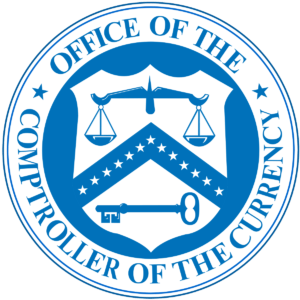 October 27, 2022 — The Office of the Comptroller of the Currency today announced it will establish an Office of Financial Technology early next year to bolster the agency’s expertise and ability to adapt to a rapidly changing banking landscape.
October 27, 2022 — The Office of the Comptroller of the Currency today announced it will establish an Office of Financial Technology early next year to bolster the agency’s expertise and ability to adapt to a rapidly changing banking landscape.
The Office of Financial Technology will build on and incorporate the Office of Innovation, which the OCC established in 2016 to coordinate agency efforts to support responsible financial innovation.
“Financial technology is changing rapidly and bank-fintech partnerships are likely to continue growing in number and complexity. To ensure that the federal banking system is safe, sound, and fair today and well into the future, we need to have a deep understanding of financial technology and the financial technology landscape,” said Acting Comptroller of the Currency Michael J. Hsu. “The establishment of this office will enable us to be more agile and to promote responsible innovation, consistent with our mission.”
The Office of Financial Technology will be led a by a Chief Financial Technology Officer, who will be a Deputy Comptroller reporting to the Senior Deputy Comptroller for Bank Supervision Policy. The office will provide strategic leadership, vision, and perspective for the OCC’s financial technology activities and related supervision.
Competing Interests: Data Ownership at the Crossroads of SaaS Stakeholders and Regulation
Courtesy of Foley & Lardner LLP, National Law Review, Volume XII, Number 298
Overview of SaaS Stakeholders
In a typical SaaS platform, various stakeholders are involved at different levels of data processing, each having their own unique roles and ownership claims with respect to at least some aspect of data that they store or process. Each of these stakeholders may access, own, consume, store, process, or otherwise interact with the user data at various layers of the data stack.
The number of stakeholders can vary greatly based on the complexity of the SaaS platform. For instance, a SaaS platform might include data from end users (e.g., personal, financial, or medical data) as well as confidential data from enterprises (e.g., employee, technical, or business confidential information). The SaaS service provider can further store the received confidential data on company systems or cloud service providers, where it is further processed using proprietary or open source software solutions. Alternatively, the processing and software solutions could be provided or handled by third party service provider(s) with access to the data on the company systems and the cloud service providers.
Related Reading: Why Data Protection Is So Important for SaaS
Technological, political, and legal issues impact privacy and data protection these days. Hardware and software need more and more personal information to operate correctly. The Internet of Things, for example, opens up a massive breach between technology and legislation. While software and hardware companies make giant leaps, legislation is slow to interact. Designing regulations against data theft and fraud becomes more and more challenging.
Geographic and Data-Specific Concerns With SaaS Platforms
The complexities of how enterprises and other entities interact with the data used by SaaS companies are amplified by geography. For example, stakeholders could be located in various geographic regions and subject to different jurisdictional laws, regulations, and expectations with respect to data ownership and management. Consequently, many issues can arise with respect to how obligations for complying with these considerations are allocated amongst stakeholders. In addition, different stakeholders can have competing interests and various obligations in relation to other parties indirectly involved in the SaaS process, affecting commercial relationships further downstream from the immediate ownership or management of the data.
U.S. Authorities Amplify Enforcement Efforts to Address Financial Crime Risks in the Digital Asset Industry
Courtesy of K2 Integrity
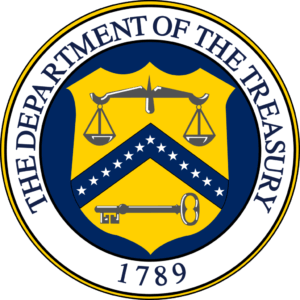 October 26, 2022 — The United States Department of the Treasury has continued to signal that it will focus policy, regulatory, and enforcement attention on the financial crime and sanctions risk in the crypto and digital asset ecosystem. The Treasury recently released the “Action Plan to Address Illicit Financing Risks of Digital Assets” updating the illicit finance risks it sees in the digital asset domain.1 The United States and international regulators have continued to focus on these risks as a predominant theme for regulation of the sector.
October 26, 2022 — The United States Department of the Treasury has continued to signal that it will focus policy, regulatory, and enforcement attention on the financial crime and sanctions risk in the crypto and digital asset ecosystem. The Treasury recently released the “Action Plan to Address Illicit Financing Risks of Digital Assets” updating the illicit finance risks it sees in the digital asset domain.1 The United States and international regulators have continued to focus on these risks as a predominant theme for regulation of the sector.
Prior client alerts have illuminated the growing attention from regulators and treatment of the crypto and digital asset ecosystem (see U.S. Policy Objectives on Digital Assets; Risks Due to Virtual Currency Abuses by Russian Actors; Virtual Currency Industry Guidance). The Treasury Department—as a part of a broader effort by the U.S. government—has signaled to actors in the Digital Asset industry that there are financial crime compliance risks associated with new methods of transferring value and new types of assets and that the industry should be proactively mitigating such risks. Recent actions of the Treasury Department remind the digital asset and FinTech industry that the Treasury Department is imposing sanctions and financial crime compliance expectations analogous to those required of the traditional finance industry.
Related Reading: DOJ leads regulatory “carrot & stick” strategy to push firms to boost compliance regime
The US Justice Department has begun work on an initiative to push financial regulators to improve Wall Street culture with a “carrot & stick” strategy The initiative — which pushes rewards or penalties based on the specific steps financial services firms take in order to better compel compliant behavior — raises the prospect of firms paying higher compensation by providing incentives for compliance staff independence, but it also increases potentials risks for falling behind in updating technology.
On October 11, 2022, the U.S. Department of the Treasury’s Office of Foreign Assets Control (OFAC) and the Financial Crimes Enforcement Network (FinCEN) announced the first parallel enforcement action in the virtual currency industry against Bittrex, Inc. (Bittrex), a U.S.-based company that provides online virtual currency exchange and hosted wallet services.2 Authorities concluded that (i) Bittrex did not maintain an appropriate compliance program for the first 18 months of its operation; (ii) it did not report suspicious activities as required by relevant laws in the United States; and (iii) it provided services to customers in sanctioned jurisdictions.
The total amount of fines imposed—$53,561,658.40—was the largest to date for a company in the virtual currency space. The OFAC and FinCEN settlement amounts were $24,280,829.20 and $29,280,829.20, respectively. FinCEN credited the Bittrex’s settlement amount with OFAC against its own settlement which meant Bittrex would need to pay $5 million in addition to what it pays to OFAC as part of the FinCEN Consent Order.
Separately, on September 30, 2022, OFAC announced a settlement in the amount of $116,048.60 with Tango Card, Inc. (Tango Card), a U.S.-based company that supplies and distributes customer and employee incentive awards such as stored value cards. OFAC concluded that Tango Card was in apparent violation of a number of U.S. sanctions programs by issuing value cards for individuals located in sanctioned countries as a result of its deficient geolocation identification controls.
These actions come on the heels of OFAC’s action to impose sanctions on a cryptocurrency mixer, Tornado Cash.3 In August 2022, OFAC imposed blocking sanctions on Tornado Cash. As a result, no one over whom OFAC has jurisdiction, may deal with Tornado Cash. OFAC sanctioned the mixer because it was used by malicious actors including Lazarus Group, a Democratic People’s Republic of Korea state-sponsored hacking group, to break the traceability of the stolen digital assets obtained via series of hacks. The move by OFAC triggered some disagreements about whether OFAC had the authority to impose sanctions on a decentralized autonomous organization,4 otherwise known as DAO, and whether OFAC has infringed constitutional rights of the U.S. persons who were barred from using the mixer following the imposition of sanctions on Tornado Cash.5
FinCEN Renews and Expands Real Estate Geographic Targeting Orders
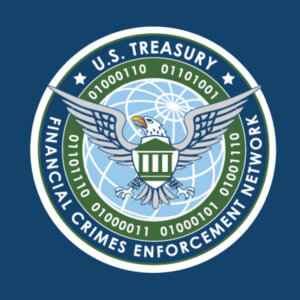 October 26, 2022 — The Financial Crimes Enforcement Network (FinCEN) today announced the renewal and expansion of its Geographic Targeting Orders (GTOs) that require U.S. title insurance companies to identify the natural persons behind shell companies used in non-financed purchases of residential real estate.
October 26, 2022 — The Financial Crimes Enforcement Network (FinCEN) today announced the renewal and expansion of its Geographic Targeting Orders (GTOs) that require U.S. title insurance companies to identify the natural persons behind shell companies used in non-financed purchases of residential real estate.
The terms of the GTOs are effective beginning October 27, 2022, and ending on April 24, 2023. The GTOs continue to provide valuable data on the purchase of residential real estate by persons possibly involved in various illicit enterprises. Renewing the GTOs will further assist in tracking illicit funds and other criminal or illicit activity, as well as inform FinCEN’s future regulatory efforts in this sector.
FinCEN renewed the GTOs that cover certain counties within the following major U.S. metropolitan areas: Boston; Chicago; Dallas-Fort Worth; Las Vegas; Los Angeles; Miami; New York City; San Antonio; San Diego; San Francisco; Seattle, the District of Columbia, Northern Virginia, and Maryland (DMV) area; as well as the City and County of Baltimore, the County of Fairfield, Connecticut, and the Hawaiian islands of Honolulu, Maui, Hawaii, and Kauai. FinCEN, working in conjunction with our law enforcement partners, identified additional regions that present greater risks for illicit finance activity through non-financed purchases of residential real estate. Accordingly, today, FinCEN expanded the geographic coverage of the GTOs to counties encompassing the Texas cities of Houston and Laredo. The effective period of the GTOs for purchases in these newly added areas begins on November 25, 2022. The purchase amount threshold remains $300,000 for each covered metropolitan area, with the exception of the City and County of Baltimore, where the purchase threshold is $50,000.
FinCEN appreciates the continued assistance and cooperation of title insurance companies and the American Land Title Association in protecting real estate markets from abuse by illicit actors. Any questions about the Orders should be directed to FinCEN’s Regulatory Support Section at [email protected].
Articles for October 21, 2022
- CFPB Funding Mechanism Violates Constitution, Fifth Circuit Says
- Treasury’s Federal Insurance Office Takes Important Step to Assess Climate-related Financial Risk – Seeks Comment on Proposed Data Call
- Acting Comptroller Discusses Crypto Risks, Including Use of Bank-Like Terminology
- CFPB Takes Action to Address Junk Data in Credit Reports
- Federal Deposit Insurance Corporation (FDIC) Board of Directors Adopts Final Rule on Assessments, Revised Deposit Insurance Assessment Rates; Maintains the Designated Reserve Ratio for 2023
CFPB Funding Mechanism Violates Constitution, Fifth Circuit Says
Courtesy of Evan Weinberger, Bloomberg Law
 Oct. 19, 2022 — The Consumer Financial Protection Bureau’s independent funding through the Federal Reserve violates the Constitution’s separation of powers clause, the Fifth Circuit ruled.
Oct. 19, 2022 — The Consumer Financial Protection Bureau’s independent funding through the Federal Reserve violates the Constitution’s separation of powers clause, the Fifth Circuit ruled.
The constitutional flaws found by the U.S. Court of Appeals for the Fifth Circuit in its Wednesday ruling also invalidated the remaining portions of the CFPB’s restrictions on the lenders offering payday, auto title and other short-term, high-interest loans.
“The Bureau’s perpetual self-directed, double-insulated funding structure goes a significant step further than that enjoyed by the other agencies on offer,” Judge Cory T. Wilson wrote for the appeals court’s three-judge panel.
The ruling was a win for payday lenders that had been attempting to kill a CFPB rule that would restrict their ability to access customers’ bank accounts and other measures. It also adds another headache for an agency that only recently shed a constitutional challenge to its leadership structure.
If the CFPB fails to get the Fifth Circuit ruling overturned in a likely appeal, the agency could face a massive fight in Congress over funding and potential placement on Congressional appropriations, particularly if Republicans retake one or both houses of Congress in the upcoming midterm elections.
A CFPB spokesman said there was “nothing novel or unusual” about the CFPB’s funding mechanism, noting that the Federal Reserve System and programs like Medicare and Social Security are funded outside of the appropriations process.
“The CFPB will continue to carry out its vital work enforcing the laws of the nation and protecting American consumers,” the CFPB spokesman said.
The Community Financial Services Association of America, the payday lending industry group leading the litigation over the rule, didn’t immediately reply to a request for comment.
Congress created the CFPB in 2010 in the Dodd-Frank Act, the legislative response to the 2008 financial crisis. The law intended to insulate the CFPB from political pressures by both requiring that the CFPB’s single director could only be fired for cause and by providing independent funding through the Fed rather than through the Congressional appropriations process.
In June 2020, the Supreme Court ruled in Seila Law v. CFPB that the for-cause removal protections were unconstitutional and made the CFPB director an at-will employee of the president.
Treasury’s Federal Insurance Office Takes Important Step to Assess Climate-Related Financial Risk – Seeks Comment on Proposed Data Call
 Oct. 19, 2022 — Today, the U.S. Department of the Treasury’s Federal Insurance Office (FIO) issued a proposed data collection from insurers to assess climate-related financial risk across the United States. FIO is seeking public input on a proposed collection of data from property and casualty insurers regarding current and historical underwriting data on homeowners’ insurance.
Oct. 19, 2022 — Today, the U.S. Department of the Treasury’s Federal Insurance Office (FIO) issued a proposed data collection from insurers to assess climate-related financial risk across the United States. FIO is seeking public input on a proposed collection of data from property and casualty insurers regarding current and historical underwriting data on homeowners’ insurance.
The data collection would be aggregated at the ZIP Code level for a specific subset of insurers and would not involve data on individual homeowners or other insured entities. The proposal represents a critical step toward supplying FIO with consistent, granular, and comparable insurance data needed to help assess the potential for major disruptions of private insurance coverage in regions of the country that are particularly vulnerable to the impacts of climate change. The proposed data collection would also help FIO’s work to assess both the availability of insurance for millions of Americans as well as the affordability of such insurance.
Related links
-
- A copy of the request for public comments is available here.
- A copy of the proposed data collection template is available here.
- A copy of the instructions for the proposed data collection is here.
- A copy of FIO’s August 2021 request for information is available here.
- For more information on FIO, see here.
“Today’s action by the Federal Insurance Office is an important step in determining how Americans are being affected by the increasing costs of climate change,” said Secretary of the Treasury Janet L. Yellen. “The recent impacts in Florida from Hurricane Ian demonstrate the critical nature of this work and the need for an increased understanding of insurance market vulnerabilities in the United States. FIO’s data collection will add to the work of regulators and policymakers across the Administration to assess climate-related risks to the financial system, the U.S. economy, and the American people.”
The comments submitted by the public will inform FIO’s work in responding to President Biden’s Executive Order on Climate-related Financial Risk, EO 14030 (May 20, 2021). Underscoring the important role of the insurance sector in responding to climate-related financial risks, EO 14030 called for FIO to “assess, in consultation with States, the potential for major disruptions of private insurance coverage in regions of the country particularly vulnerable to climate change impacts.” On August 31, 2021, FIO outlined its priorities with regard to climate-related financial risk in a request for information on the insurance sector and climate-related financial risks. The data collection proposed today is another step in FIO’s continued efforts in this area.
Acting Comptroller Discusses Crypto Risks, Including Use of Bank-Like Terminology
Courtesy of Mindy Harris, Ballard Spahr LLP
 Oct. 19, 2022 — In remarks at the DC Fintech Week conference on October 11, 2022 and in a keynote address later the same day at a roundtable conducted by the Harvard Law School Program on International Financial Systems, Acting Comptroller of the Currency Michael J. Hsu expressed concerns about risks to consumers and the financial system posed by crypto industry participants.
Oct. 19, 2022 — In remarks at the DC Fintech Week conference on October 11, 2022 and in a keynote address later the same day at a roundtable conducted by the Harvard Law School Program on International Financial Systems, Acting Comptroller of the Currency Michael J. Hsu expressed concerns about risks to consumers and the financial system posed by crypto industry participants.
Acting Comptroller Hsu identified risks created by crypto companies’ use of bank-like terminology; integration and commingling of services both between banks and crypto firms, and within the crypto industry; and gaps in data necessary to understand risks posed by crypto-asset exposures at traditional banks.
As to terminology and marketing approaches used by crypto companies, Acting Comptroller Hsu warned that by using “skeuomorphism”, a design concept where a novel product or process is made to appear to be the same as a familiar product or process, “crypto has mimicked” familiar concepts associated with traditional financial products and services in order to suggest to the public that crypto products are analogous to banking products. As an example, Mr. Hsu pointed to “crypto savings accounts” offered by crypto companies on their platforms. These accounts promise consumers returns paid in additional units of crypto that are sometimes referred to as “yield” and quoted in terms of “APY,” thereby suggesting a stable, predictable return. In some cases, consumers are assured that they can reclaim their assets at any time, even if the crypto company fails.
Related Reading:
While Mr. Hsu did not refer to crypto companies’ claims as “misleading” or “deceptive”, his comments reflect his skepticism about approaches the crypto industry has used to draw consumers away from traditional banking relationships. He noted that “[a]s many are now learning the hard way, the risks of these arrangements are materially different than their representations,” and cautioned that “[i]n these examples, skeuomorphism is not a bridge, but a disguise. Using the familiar to introduce something novel can downplay or mask the risks involved and establish false expectations. In time, people get hurt.” In later remarks, Hsu reiterated the same theme: “A large segment of the crypto-asset industry continues to rely on hype and bootstrapping to grow. Promises of innovation and inclusion often mask crypto’s promotion of a gold rush vibe…”.
As to integration and commingling concerns, Mr. Hsu cited fears not only about integrating crypto and traditional finance, but also about overreaching by crypto companies wishing to offer an increasingly broad range of services, such as: “digital wallets; buying and selling crypto; crypto custody; staking crypto for yield; crypto margin lending; trading crypto derivatives; holding fiat; borrowing and payments with a credit card; direct deposit of paychecks; facilitating peer to peer payments; issuing stablecoins; and creating, collecting, and connecting to NFTs.” He expressed the view that until crypto matures and appropriate guardrails are put in place, limits should be placed on the scope of activities commingled within a single crypto firm and on the integration of crypto and traditional finance.
As to lack of availability of data necessary to identify, understand, and monitor risks posed by crypto activities, Mr. Hsu cited supervisory processes in place to monitor banks’ exposures to crypto and to gain visibility into their crypto activities, such as the requirement that institutions first obtain a supervisory non-objection before engaging in any of the crypto-asset activities that the OCC has determined to be permissible. To receive a non-objection, an institution must demonstrate that it can conduct the proposed activity safely, soundly, and fairly. He noted that the FDIC and Federal Reserve have adopted a similar approach, helping to maintain a level playing field across the banking system. He also cautioned that although this approach has been effective in monitoring banks’ crypto-related activities, further enhancements may be needed to track the risk of “cross-contagion.” He indicated that the OCC is considering enhanced supervisory processes to more fully understand “the prevalence and scope of crypto-asset exposures and interconnectedness at our supervised institutions.”
Acting Comptroller Hsu went on to propose alternatives to impose supervision and, ultimately regulation, on the crypto industry, while not clearly identifying an optimal way to achieve this goal, or which regulator(s) should be responsible. He suggested that gathering data from crypto firms and platforms on their activities with traditional financial institutions would give financial stability regulators a fuller picture, thereby enabling more effective surveillance of financial stability risks. He also suggested that in the U.S., such monitoring could be conducted by the Office of Financial Research (OFR) and that in light of the borderless nature of crypto, consideration should be given to international coordination.
CFPB Takes Action to Address Junk Data in Credit Reports
Effort seeks to address false information on the credit reports of children in foster care and the general public
 Oct. 20, 2022 — Today, the Consumer Financial Protection Bureau (CFPB) issued guidance to consumer reporting companies about their obligation to screen for and eliminate obviously false “junk data” from consumers’ credit reports. Companies need to take steps to reliably detect and remove inconsistent or impossible information from consumers’ credit profiles. For example, many children in foster care have large amounts of information on their credit reports that is clearly junk data because as minors they are prohibited from entering into most contracts for credit.
Oct. 20, 2022 — Today, the Consumer Financial Protection Bureau (CFPB) issued guidance to consumer reporting companies about their obligation to screen for and eliminate obviously false “junk data” from consumers’ credit reports. Companies need to take steps to reliably detect and remove inconsistent or impossible information from consumers’ credit profiles. For example, many children in foster care have large amounts of information on their credit reports that is clearly junk data because as minors they are prohibited from entering into most contracts for credit.
“When a credit report accuses someone of defaulting on a loan before they were born, this is nonsensical, junk data that should have never shown up in the first place,” said CFPB Director Rohit Chopra. “Consumer reporting companies have a clear obligation to use better procedures to screen for and eliminate conflicting information, or information that cannot be true.”
While incorrect data affects millions of Americans, children in foster care may be particularly susceptible to these problems because of a high rate of identity theft impacting that population. The roughly 400,000 children in the United States foster care system often lack permanent addresses, and their personal information is frequently shared among numerous adults and agency databases. When bad actors take advantage of children passing through their care and use their personal information to take out loans, children in foster care may enter adulthood saddled with negative and clearly inaccurate credit histories that can hinder their progress toward financial independence.
Read the advisory opinion, Fair Credit Reporting; Facially False Data.
When consumer reporting companies include inconsistent or conflicting account information or information that does not make sense or cannot be true, consumers can suffer real-world consequences. Junk data in reports can lead to consumers being denied credit, housing, or employment, or paying more for credit. Junk data can take many forms, but some examples are credit reports that reflect a child having a mortgage, or a credit report that reflects a debt incurred years before the person’s birth.
Consumer reporting companies have a legal requirement to follow reasonable procedures to assure maximum possible accuracy of information that they collect and report. As part of that requirement, companies must have policies and procedures to screen for and eliminate junk data. Specifically, the policies and procedures should be able to detect and remove:
- Inconsistent account information: Sometimes consumer reports can show two or more pieces of information that cannot all be true. For example, an account is paid in full but still shows a balance, or a date of first delinquency predates the account’s opening.
- Information that cannot be accurate: Sometimes information on consumer reports reflects obvious impossibilities. For example, if a tradeline includes a date that predates the consumer’s date of birth or if just one of many tradelines indicates a consumer is deceased.
A consumer reporting company’s policies, procedures, and internal controls should further identify and prevent reporting of illegitimate credit transactions for a minor. Minors generally cannot legally enter into contracts for credit except in certain limited circumstances, including applications for student loans, for emancipated minors, or as credit card authorized users.
Today’s guidance is one in a series of actions being taken by the CFPB to ensure consumer reporting companies comply with consumer financial protection law. Consumer complaints submitted to the CFPB continue to reflect significant concern about inaccuracies in consumer reports. Complaints about “incorrect information on your report” have represented the largest share of credit or consumer reporting complaints submitted to the CFPB for at least the last six years, and the CFPB receives more complaints about credit reporting than any other subject.
Federal Deposit Insurance Corporation (FDIC) Board of Directors Adopts Final Rule on Assessments, Revised Deposit Insurance Assessment Rates; Maintains the Designated Reserve Ratio for 2023
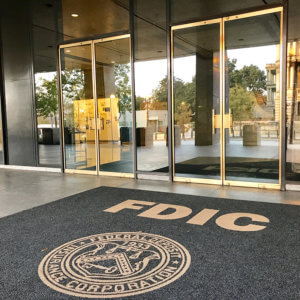 Oct. 18, 2022 — The Federal Deposit Insurance Corporation (FDIC) adopted a final rule to increase initial base deposit insurance assessment rate schedules uniformly by 2 basis points beginning in the first quarterly assessment period of 2023. After careful consideration of comments received and updated analysis and projections, the FDIC adopted as final and without change, the increase in assessment rates as proposed on June 21, 2022.
Oct. 18, 2022 — The Federal Deposit Insurance Corporation (FDIC) adopted a final rule to increase initial base deposit insurance assessment rate schedules uniformly by 2 basis points beginning in the first quarterly assessment period of 2023. After careful consideration of comments received and updated analysis and projections, the FDIC adopted as final and without change, the increase in assessment rates as proposed on June 21, 2022.
“The increased assessment revenue will strengthen the DIF at a time of significant downside risk to the economy and financial system, increasing the likelihood that the reserve ratio will reach the statutory minimum of 1.35 percent while reducing the likelihood of a pro-cyclical increase in the future, and promoting public confidence in federal deposit insurance,” said Acting Chairman Martin Gruenberg.
The final rule is intended to increase the likelihood that the reserve ratio of the Deposit Insurance Fund (DIF) reaches the statutory minimum of 1.35 percent by the statutory deadline of September 30, 2028, consistent with the Amended Restoration Plan. The final rule also reduces the likelihood that the FDIC would need to consider a potentially pro-cyclical assessment rate increase (i.e., raise assessments when banking and economic conditions may be less favorable).
Related Reading: FDIC Board of Directors Approves Advance Notice of Proposed Rulemaking Regarding Resolution–Related Resource Requirements for Large Banking Organizations
The increase in assessment rates is projected to have an insignificant effect on institutions’ capital levels, is estimated to reduce income slightly by annual average of 1.2 percent, and should not impact lending or credit availability in any meaningful way.
The FDIC also concurrently maintained the Designated Reserve Ratio (DRR) for the DIF at 2 percent for 2023. The increase in assessment rate schedules is also intended to support growth in the DIF in progressing toward the FDIC’s long-term goal of a 2 percent DRR. Growing the DIF increases the likelihood of the DIF remaining positive throughout periods of significant losses due to bank failures, consistent with the FDIC’s long-term fund management plan. Therefore, the new assessment rate schedules will remain in effect unless and until the reserve ratio meets or exceeds 2 percent, absent further Board action. Progressively lower assessment rate schedules will take effect when the reserve ratio reaches 2 percent, and again when it reaches 2.5 percent.
Revised rate schedules will be effective on January 1, 2023, and applicable to the first quarterly assessment period of 2023 (i.e., January 1 through March 31, 2023, with an invoice payment date of June 30, 2023). The revised rate schedules are applicable to all insured depository institutions.
Related Links:
Articles for October 14, 2022:
- CFPB Report Finds High Fees Charged on Student Banking Products Endorsed by Colleges
- OFAC Issues Sanctions Compliance Guidance for Instant Payment Systems
- Federal Insurance Office (FIO), Treasury: Request for Comment on Potential Federal Insurance Response to Catastrophic Cyber Incidents
- Cybersecurity and Infrastructure Security Agency, Department of Homeland Security: Request for Information on the Cyber Incident Reporting for Critical Infrastructure Act of 2022
- Prepared Remarks of FinCEN Acting Director Himamauli Das During the ACAMS AML Conference
CFPB Report Finds High Fees Charged on Student Banking Products Endorsed by Colleges
 Oct. 13, 2022 — The Consumer Financial Protection Bureau (CFPB) published a report on terms and fees associated with banking products marketed in partnership with colleges to students. The report raises questions about whether some marketing deals between colleges and financial institutions comply with Department of Education rules. The report also highlights a lack of transparency in the arrangements schools have made with financial institutions. In conjunction with the release of this report, the Department of Education issued guidance to schools on requirements for college-sponsored banking arrangements and committed to additional oversight on this issue.
Oct. 13, 2022 — The Consumer Financial Protection Bureau (CFPB) published a report on terms and fees associated with banking products marketed in partnership with colleges to students. The report raises questions about whether some marketing deals between colleges and financial institutions comply with Department of Education rules. The report also highlights a lack of transparency in the arrangements schools have made with financial institutions. In conjunction with the release of this report, the Department of Education issued guidance to schools on requirements for college-sponsored banking arrangements and committed to additional oversight on this issue.
A small set of financial institutions partner with hundreds of colleges and universities in the United States to disburse federal financial aid and provide financial products to students, including credit cards and prepaid and debit accounts. These partnerships often claim to support students’ financial health. However, the products marketed to students are often more costly than what students might otherwise find in the market.
Key Findings
The CFPB’s review included data on 11 account providers, including non-bank financial service providers, banks, and credit unions offering more than 650,000 student accounts in partnership with 462 institutions of higher education during the 2020-2021 Award Year. Among the CFPB’s key findings:
- Financial services providers and their partner schools appear to offer and promote more costly products to students than are otherwise available in the market: Students are subject to direct marketing efforts that promote accounts that impose more costs than comparable accounts – even comparable accounts offered by the same financial services provider. Some providers’ agreements with schools allow them charge students five overdraft or NSF penalties, per day, costing $175.
- One entity dominates the market for financial aid disbursements, providing nearly 70% of the accounts offered in partnership with schools—and imposes surprise monthly fees: Under this provider, accountholders are charged monthly service fees on accounts with less than $300 in qualifying deposits per month, but financial aid disbursements that may comprise the bulk of a student’s deposits do not count as qualifying deposits. Of the $15 million in annual costs paid by students in the CFPB’s sample, nearly $13 million was paid to this provider.
- Many students are directed to lists of account options that do not appear to meet Department of Education requirements: Under Department of Education regulations, students must be allowed to select the way they receive their financial aid from a neutral list, and cannot be coerced into selecting college-sponsored products under threat that their financial aid disbursements will be delayed if they choose non-sponsored accounts. The CFPB identified instances where students were told that financial aid payments might not be as timely if students didn’t choose a college-sponsored account.
- Many agreements between financial institutions and colleges do not appear to be posted prominently as required: Nearly 30% of accounts in the CFPB’s sample were subject to arrangements in which the financial services provider made payments to the partner school. Schools are required to post on their websites the agreements they have with financial services providers, any compensation exchanged between them, and the average costs paid by students. These disclosures help make the terms of the college-bank relationship transparent, but the CFPB’s review found that hundreds of schools did not appear to have posted the disclosures in the public and conspicuous manner required.
The Department of Education Increases Accountability
Today, the Department issued guidance clarifying schools’ responsibility to ensure that campus financial products are consistent with students’ best financial interests, including by reviewing whether any fees assessed are consistent with or below prevailing market rates. This guidance discusses overdraft and NSF fees, given that financial institutions in the general market have increasingly been reducing or eliminating certain fees. The Department also announced that it will take steps to enhance enforcement of its cash management regulations by tracking new data and bringing on additional staff to conduct oversight of college banking arrangements.
OFAC Issues Sanctions Compliance Guidance for Instant Payment Systems
Courtesy of Fatema Merchant, Jonathan Wang, Reid Whitten, Sheppard Mullin Richter & Hampton LLP
 Oct. 11, 2022 — On September 30, 2022, the Office of Foreign Assets Control (OFAC) published compliance guidance for instant payment systems. The guide highlights the need for emerging payment technology companies to assess their sanctions risks and implement compliance programs that mitigate those risks. Specifically, the guidance: (i) reaffirms that financial institutions should take a risk-based approach to managing sanctions risks; (ii) highlights key factors that may be relevant in determining that risk-based approach; (iii) encourages the development and deployment of innovative sanctions compliance approaches and technologies to address identified risks; and (iv) encourages developers of instant payment systems to incorporate sanctions compliance considerations as they develop new payment technologies.
Oct. 11, 2022 — On September 30, 2022, the Office of Foreign Assets Control (OFAC) published compliance guidance for instant payment systems. The guide highlights the need for emerging payment technology companies to assess their sanctions risks and implement compliance programs that mitigate those risks. Specifically, the guidance: (i) reaffirms that financial institutions should take a risk-based approach to managing sanctions risks; (ii) highlights key factors that may be relevant in determining that risk-based approach; (iii) encourages the development and deployment of innovative sanctions compliance approaches and technologies to address identified risks; and (iv) encourages developers of instant payment systems to incorporate sanctions compliance considerations as they develop new payment technologies.
Background
Instant payment systems allow users to send and receive funds almost instantly – in real time. The financial sector has increasingly developed the availability of these systems which presents unique questions about OFAC compliance because each instant payment system is different –with varying characteristics such as the geographic location of its customers or the nature and value of the payment.
Key Takeaways
- Customers’ History Provides Opportunities for Risk Assessment: OFAC highlights how companies should monitor patterns and customer history to assess risks. For example, a customer’s prior history that is inconsistent with a payment (significantly higher than previous payments or made to a foreign person to whom the customer has not been previously involved with) may indicate a potential sanctions risk.
- Domestic Instant Payment Systems Face Lower Risks: Domestic systems in which all transactions involve only accounts maintained at U.S. banks, excluding foreign correspondent accounts are less likely to risk sanctions exposure. OFAC notes that U.S. banks are likely already performing the necessary due diligence on their customers for any potential sanctions nexus. Non-U.S. banks may not be subject to a similar regulatory regime.
- Technology Solutions Can Support Your Sanctions Compliance: New and emerging technological sanctions compliance tools are available that can help mitigate a financial institution’s sanctions risks. Some tools use information sharing mechanisms across financial institutions, which may enhance sanctions screening functions and reduce false positives. OFAC encourages the use of such technological tools and solutions.
- Certain Compliance Features Could Be Integrated Into Instant Payment Systems: When instant payment systems are being developed, OFAC encourages developers to incorporate sanctions compliance features. One example includes a messaging system that allows participating financial institutions involved in processing payments to communicate with each other so that they can gather the necessary information related to potential sanctions alerts and effectively adjudicate them. Another example is exception processing, which allows a transaction to be removed from the automated process to provide sufficient time for a financial institution to investigate potential sanctions concerns.
Request for Comment on Potential Federal Insurance Response to Catastrophic Cyber Incidents
Federal Insurance Office (FIO), Treasury
 Over the past several years, the Federal Insurance Office (FIO) in the U.S. Department of the Treasury (Treasury) has continued its ongoing efforts with regard to both cyber insurance and insurer cybersecurity. Cyber insurance is a significant risk-transfer mechanism, and the insurance industry has an important role to play in strengthening cyber hygiene and building resiliency. FIO has also increased its data collection in this area with regard to the Terrorism Risk Insurance Program (TRIP) and has supported the development of Treasury’s counter-ransomware strategy. The Government Accountability Office (GAO) released a report in June 2022 recommending that FIO and the Department of Homeland Security’s Cybersecurity and Infrastructure Security Agency (CISA) conduct a joint assessment to determine “the extent to which risks to critical infrastructure from catastrophic cyber incidents and potential financial exposures warrant a federal insurance response.” Both FIO and CISA have agreed to conduct the recommended assessment. FIO is also coordinating with the White House Office of the National Cyber Director on these issues.
Over the past several years, the Federal Insurance Office (FIO) in the U.S. Department of the Treasury (Treasury) has continued its ongoing efforts with regard to both cyber insurance and insurer cybersecurity. Cyber insurance is a significant risk-transfer mechanism, and the insurance industry has an important role to play in strengthening cyber hygiene and building resiliency. FIO has also increased its data collection in this area with regard to the Terrorism Risk Insurance Program (TRIP) and has supported the development of Treasury’s counter-ransomware strategy. The Government Accountability Office (GAO) released a report in June 2022 recommending that FIO and the Department of Homeland Security’s Cybersecurity and Infrastructure Security Agency (CISA) conduct a joint assessment to determine “the extent to which risks to critical infrastructure from catastrophic cyber incidents and potential financial exposures warrant a federal insurance response.” Both FIO and CISA have agreed to conduct the recommended assessment. FIO is also coordinating with the White House Office of the National Cyber Director on these issues.
In order to inform FIO’s future work and the joint assessment, FIO is seeking comments from the public on questions related to cyber insurance and catastrophic cyber incidents.
Submit comments on or before. November 14, 2022.
The NASCUS team is currently reviewing this posting.
Request for Information on the Cyber Incident Reporting for Critical Infrastructure Act of 2022
Cybersecurity and Infrastructure Security Agency, Department of Homeland Security
 The Cybersecurity and Infrastructure Security Agency (CISA) is issuing this Request for Information (RFI) to receive input from the public as CISA develops proposed regulations required by the Cyber Incident Reporting for Critical Infrastructure Act of 2022 (CIRCIA). Among other things, CIRCIA directs CISA to develop and oversee implementation of regulations requiring covered entities to submit to CISA reports detailing covered cyber incidents and ransom payments. CIRCIA requires CISA to publish a Notice of Proposed Rulemaking (NPRM) within 24 months of the date of enactment of CIRCIA as part of the process for developing these regulations. CISA is interested in receiving public input on potential aspects of the proposed regulation prior to publication of the NPRM and is issuing this RFI as a means to receive that input. While CISA welcomes input on other aspects of CIRCIA’s regulatory requirements, CISA is particularly interested in input on definitions for and interpretations of the terminology to be used in the proposed regulations; the form, manner, content, and procedures for submission of reports required under CIRCIA; information regarding other incident reporting requirements including the requirement to report a description of the vulnerabilities exploited; and other policies and procedures, such as enforcement procedures and information protection policies, that will be required for implementation of the regulations.
The Cybersecurity and Infrastructure Security Agency (CISA) is issuing this Request for Information (RFI) to receive input from the public as CISA develops proposed regulations required by the Cyber Incident Reporting for Critical Infrastructure Act of 2022 (CIRCIA). Among other things, CIRCIA directs CISA to develop and oversee implementation of regulations requiring covered entities to submit to CISA reports detailing covered cyber incidents and ransom payments. CIRCIA requires CISA to publish a Notice of Proposed Rulemaking (NPRM) within 24 months of the date of enactment of CIRCIA as part of the process for developing these regulations. CISA is interested in receiving public input on potential aspects of the proposed regulation prior to publication of the NPRM and is issuing this RFI as a means to receive that input. While CISA welcomes input on other aspects of CIRCIA’s regulatory requirements, CISA is particularly interested in input on definitions for and interpretations of the terminology to be used in the proposed regulations; the form, manner, content, and procedures for submission of reports required under CIRCIA; information regarding other incident reporting requirements including the requirement to report a description of the vulnerabilities exploited; and other policies and procedures, such as enforcement procedures and information protection policies, that will be required for implementation of the regulations.
Written comments are requested on or before November 14, 2022. Submissions received after that date may not be considered.
The NASCUS team is currently reviewing this posting.
FinCEN Acting Director Himamauli Das Remarks During the ACAMS AML Conference

Himamauli Das
Oct. 12, 2022 — Financial Crimes Enforcement Network Acting Director Himamauli Das gave remarks during the ACAMS AML Conference, including remarks on the recently adopted Beneficial Ownership Regulations.
First, I’d like to note that all of you are incredibly important to our efforts to combat financial crime. This is a partnership between financial institutions, FinCEN, law enforcement, innovators, and the national security community. We are constantly looking for ways to strengthen these partnerships, and this collaboration. And effective AML/CFT compliance programs are a cornerstone of this effort.
I know that the new beneficial ownership information reporting rule has been getting the headlines lately. I will spend some time today talking about that, for sure, but it’s important to note that the information we’ll get from that rule will add value on top of your incredibly important programs and existing reporting.
The SAR reporting—and other reports—that financial institutions file with FinCEN are critical for law enforcement to find tips and leads that lead to investigations—and prosecutions. We at Treasury have worked for years—long before finalizing the new beneficial ownership rule—to learn about bad actors that hide behind shell and front companies, that abuse our financial system, and that harm American businesses and the American taxpayer.
Ultimately, just like most transactions that are legitimate, we all know that most companies are legitimate businesses. That’s why your SAR reporting has been and will continue to be critical tools, in addition to beneficial ownership information, to identify the real owners behind companies that are suspected of illicit activity—and will continue to help us link shell companies and front companies to illicit activity.
Recently, we and the rest of TFI have seen how Russian oligarchs use shell companies to hide assets and evade U.S. sanctions. We have also seen bad actors using shell companies to fraudulently apply for assistance under various Federal assistance programs—the Paycheck Protection Program, child nutrition programs, and others—that have cost the American taxpayer and hurt those that need help.
Foreign governments and drug traffickers alike use anonymous shell and front companies to conduct illicit activity. And they undermine national security and confidence in our financial system. For example, we started the real estate Geographic Targeting Order (GTO) program in 2016 to find the real owners behind all-cash residential purchases in a number of jurisdictions. That reporting has been invaluable to law enforcement in linking illicit activities to efforts to launder the proceeds of crime.
The final rule is a significant step forward in our efforts to support law enforcement and national security efforts to stop illicit activity, and will be a valuable additional to our existing tools to counter illicit finance. It is the culmination of not only years of hard work at Treasury, but years of bipartisan efforts by Congress, the law enforcement community, national security agencies, and other stakeholders to bolster the United States’ corporate transparency framework.
We think that it will play an important role in protecting American taxpayers and businesses who play by the rules, but are hurt by criminals that use companies for illegal reasons. Before we get to the discussion, I would like to just briefly highlight these efforts in a little more detail. The beneficial ownership information reporting rule is the first of three rulemakings to implement the CTA. This rule goes into effect on January 1, 2024.
The second is the Access rule, which will lay out the protocols for access to the beneficial ownership database by law enforcement—at the Federal, state, local, and tribal levels—and by financial institutions. We are working very hard on this NPRM right how—and we are working to issue it in the near term.
Third, we will be revising the Customer Due Diligence (CDD) rule no later than one year after the effective date of the reporting rule—as required by the CTA.
In parallel with the rulemaking effort, FinCEN is developing the infrastructure to build a secure and confidential database that meets the highest security standards, and that ensures that only authorized users can access the information for authorized purposes. Security and confidentiality are incredibly important—to us and it’s required by the Corporate Transparency Act.
We expect the system to be operational by the time the reporting rule comes into effect.
Articles for October 7, 2022 Issue:
- ATACH Seeking to Provide Intoxicating Hemp Regulatory Clarity
- Federal Reserve Board Finalizes Updates To The Board’s Rule Concerning Debit Card Transactions
- OIG Report: The CFPB Is Generally Prepared to Implement the OPEN Government Data Act and Can Take Additional Steps to Further Align With Related Requirements
- Financial Stability Oversight Council Releases Report on Digital Asset Financial Stability Risks and Regulation
- U.S. Treasury Watchdog Suggests Crypto Activities Could Threaten Financial Stability
ATACH Seeking to Provide Intoxicating Hemp Regulatory Clarity
 Oct. 4, 2022 — The American Trade Association for Cannabis and Hemp (ATACH) and the U.S. Food and Drug Administration (FDA) recently conducted a listening session focused on unregulated intoxicating hemp product regulatory clarity.
Oct. 4, 2022 — The American Trade Association for Cannabis and Hemp (ATACH) and the U.S. Food and Drug Administration (FDA) recently conducted a listening session focused on unregulated intoxicating hemp product regulatory clarity.
“ATACH aims to educate and raise awareness on the unregulated intoxicating hemp-derived cannabinoid market and the issues posed to the state-regulated markets,” ATACH President Michael Bronstein said. “The lack of regulation and enforcement is leading to potential risks to consumer health and safety and confusion at the state level on how to regulate these products.”
Four years ago, the U.S. Farm Bill legalized hemp under federal law and permitted plant materials containing no more than .3 percent THC on a dry-weight basis, but hemp-derived products are presently being sold in numerous states and across state lines containing significant levels of THC, the main psychoactive compound in cannabis.
The result is an unregulated market for intoxicating consumer products available in gas stations, convenience stores, smoke shops, and online – in some instances, available for purchase without age verification.
Listening session topics included intoxicating hemp-derived cannabinoid products sold in concentrations exceeding what is allowable in regulated cannabis markets as it relates to per serving and per package limits; the ease of access of intoxicating hemp-derived products to youth and unsuspecting adult consumers who believe all hemp products to be non-intoxicating/impairing; and a survey of FDA regulations presently applied by state agencies in the regulation of manufactured cannabis products.
ATACH is also requesting Congress move toward establishing greater unregulated intoxicating hemp product regulatory clarity in the next Farm Bill.
Federal Reserve Board Finalizes Updates To The Board’s Rule Concerning Debit Card Transactions
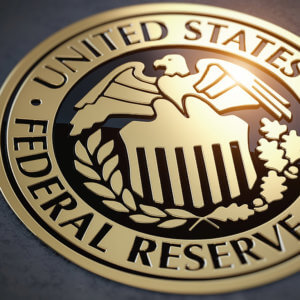 Oct. 3, 2022 —The Federal Reserve Board on Monday finalized updates to the Board’s rule concerning debit card transactions. Pursuant to statute, the updates specify that debit card issuers should enable at least two payment card networks to process all debit card transactions, including “card-not-present” transactions, such as online payments.1 The final rule is substantially similar to the proposal issued last year.
Oct. 3, 2022 —The Federal Reserve Board on Monday finalized updates to the Board’s rule concerning debit card transactions. Pursuant to statute, the updates specify that debit card issuers should enable at least two payment card networks to process all debit card transactions, including “card-not-present” transactions, such as online payments.1 The final rule is substantially similar to the proposal issued last year.
Related links
- Federal Register notice: Debit Card Interchange Fees and Routing (PDF)
- Board memo (PDF)
- Statement by Governor Bowman
By law, the Board is required to make rules ensuring that debit card issuers give merchants the opportunity to choose between at least two unaffiliated networks when routing debit card transactions. When the Board initially issued the rule in July 2011, the market had not developed solutions to broadly support multiple networks for card-not-present debit card transactions. Since that time, technology has evolved to address these barriers. However, some debit card issuers have not yet enabled at least two unaffiliated networks for merchants to choose between when routing such transactions. This issue has become increasingly pronounced because of continued growth in online payments.
The final rule underscores that debit card issuers should enable at least two unaffiliated networks to process debit card transactions. Importantly, input received in connection with the proposal suggests that many debit card issuers, and especially most community bank issuers, are already compliant with the final rule. In response to public comments, the final rule also includes certain changes that make it easier for debit card issuers to determine whether they are in compliance with the final rule. The final rule will encourage competition between networks and incentivize them to improve their fraud-prevention capabilities.
The final rule does not modify requirements concerning interchange fees. As previously stated, the Board will continue to review interchange fee requirements in light of the most recent debit card industry cost data collected by the Board, and may propose to modify these requirements in the future.
The final rule will be effective July 1, 2023.
OIG Report: The CFPB Is Generally Prepared to Implement the OPEN Government Data Act and Can Take Additional Steps to Further Align With Related Requirements
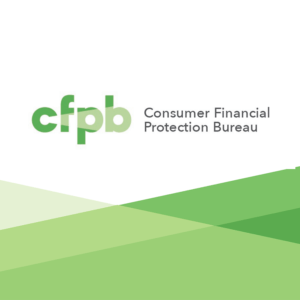 September 28, 2022 — The CFPB obtains and uses data to inform its decision-making and ensure that financial products and services are more transparent to the public. We evaluated the agency’s readiness to implement the OPEN Government Data Act, which includes requirements for data governance, management, and transparency.
September 28, 2022 — The CFPB obtains and uses data to inform its decision-making and ensure that financial products and services are more transparent to the public. We evaluated the agency’s readiness to implement the OPEN Government Data Act, which includes requirements for data governance, management, and transparency.
The CFPB generally complies with phase I of Office of Management and Budget guidance for the OPEN Government Data Act and is generally prepared to implement draft phase II guidance. However, the CFPB can enhance its data governance by making some technical updates to relevant policy, and the agency should prepare a draft strategic information resources management plan to more readily comply with phase II guidance, once finalized.
Click here to read the report and recommendations.
Findings
We found that the Consumer Financial Protection Bureau generally complies with finalized Office of Management and Budget (OMB) phase I guidance related to the Open, Public, Electronic, and Necessary Government Data Act of 2018 (OPEN Government Data Act). In addition, we found that the CFPB continues to make progress and is generally prepared to implement draft OMB phase II guidance related to the act, once finalized. However, the CFPB can take additional steps to further align with requirements outlined in the OPEN Government Data Act and related phase I and phase II guidance. Specifically, we found that the CFPB can enhance its data governance by making some technical updates to its Policy on Information Governance to reflect the current operating structure of the CFPB, which aligns with certain OPEN Government Data Act and phase I requirements. Additionally, we found that the CFPB should prepare a draft strategic information resources management plan (strategic IRM plan), to more readily comply with phase II guidance, once finalized, and obtain additional organizational benefits.
In September 2022, after completion of our fieldwork, senior CFPB officials informed us that the agency had developed a draft strategic IRM plan in 2019. We understand that this initial draft will serve as one input, among others, for developing the agency’s updated strategic IRM plan draft.
Recommendations
This report contains two recommendations designed to enhance the CFPB’s preparedness to implement the requirements of the OPEN Government Data Act and related guidance. In its response to a draft of our report, the CFPB concurs with our recommendations and outlines actions to address them. We will follow up to ensure that the recommendations are fully addressed.
Financial Stability Oversight Council Releases Report on Digital Asset Financial Stability Risks and Regulation
 Oct. 3, 2022 — The Financial Stability Oversight Council (Council) today released its Report on Digital Asset Financial Stability Risks and Regulation. The Council voted to approve the report in response to Section 6 of President Biden’s Executive Order 14067, “Ensuring Responsible Development of Digital Assets.”
Oct. 3, 2022 — The Financial Stability Oversight Council (Council) today released its Report on Digital Asset Financial Stability Risks and Regulation. The Council voted to approve the report in response to Section 6 of President Biden’s Executive Order 14067, “Ensuring Responsible Development of Digital Assets.”
As called for by the Executive Order, the report reviews financial stability risks and regulatory gaps posed by various types of digital assets and provides recommendations to address such risks.
“This report provides a strong foundation for policymakers as we work to mitigate the financial stability risks of digital assets while realizing the potential benefits of innovation,” said Secretary of the Treasury Janet L. Yellen. “It is an important contribution to the set of reports that Treasury and our interagency partners have produced as part of President Biden’s executive order. The report concludes that crypto-asset activities could pose risks to the stability of the U.S. financial system and emphasizes the importance of appropriate regulation, including enforcement of existing laws. It is vital that government stakeholders collectively work to make progress on these recommendations.”
Related Reading:
- The full report.
- A fact sheet summarizing the report’s key findings and recommendations.
- A copy of Secretary Yellen’s remarks regarding the report during the Council’s open session.
Established under the Dodd-Frank Wall Street Reform and Consumer Protection Act, the Council is charged with identifying risks to U.S. financial stability, promoting market discipline, and responding to emerging threats to the stability of the U.S. financial system. The Council brings together the expertise of federal financial regulators, state regulators, and an independent insurance expert appointed by the President.
U.S. Treasury Watchdog Suggests Crypto Activities Could Threaten Financial Stability
Courtesy of Rhodilee Jean Dolor, DailyHodl.com
 Oct. 4, 2022 — The Treasury Department’s Financial Stability Oversight Council (FSOC) is weighing in on crypto assets and their potential to affect the traditional financial structure of the US.
Oct. 4, 2022 — The Treasury Department’s Financial Stability Oversight Council (FSOC) is weighing in on crypto assets and their potential to affect the traditional financial structure of the US.
The council, which was formed by the Dodd-Frank Act to help identify financial stability risks in the United States, says that crypto assets such as stablecoins may compromise the country’s financial system if the industry remains unregulated.
Related Reading: Former SEC Chair Jay Clayton Says Crypto Regulation Must Start with Stablecoins
“Crypto-asset activities could pose risks to the stability of the U.S. financial system if their interconnections with the traditional financial system or their overall scale were to grow without adherence to or being paired with appropriate regulation, including enforcement of the existing regulatory structure.”
The FSOC says that while space’s connection to the traditional system is still relatively negligible, certain choke points like stablecoins and trading platforms could pose threats in the future.
“Although interconnections with the traditional financial system are currently relatively limited, they could potentially increase rapidly. Participants in the crypto asset ecosystem and the traditional financial system have explored or created a variety of interconnections. Notable sources of potential interconnections include
traditional assets held as part of stablecoin activities.
Crypto-asset trading platforms may also have the potential for greater interconnections by providing a wide variety of services, including leveraged trading and asset custody, to a range of retail investors and traditional financial institutions. Consumers can also increasingly access crypto-asset activities, including through certain traditional money services businesses.”
The council says that compliance with and enforcement of existing regulations is a “key step” in addressing these potential risks. It also recommends bolstering the capacity of regulatory agencies related to crypto-asset data and expertise in order to tackle the threats the industry may pose.
Articles for September 30, 2022 Issue:
- Federal and State Financial Regulatory Agencies Issue Interagency Statement on Supervisory Practices Regarding Financial Institutions Affected by Hurricanes Fiona and Ian
- FinCEN Issues Final Rule for Beneficial Ownership Reporting to Support Law Enforcement Efforts, Counter Illicit Finance, and Increase Transparency
- CFPB in the News:
- CFPB Orders Regions Bank to Pay $191 Million for Illegal Surprise Overdraft Fees:Repeat offender will refund at least $141 million to customers and pay $50 million penalty
- CFPB Sues MoneyLion for Overcharging Servicemembers and Trapping Consumers in Costly Memberships
- CFPB Supervisory Examinations Find Violations of Federal Law by Student Loan Servicers and University-Owned Lenders: Blanket withholding of academic transcripts to pressure borrowers to pay cited as unlawful
- Examining the potential impact of high vehicle costs on Americans with deep subprime credit scores
- CFPB Ending No-Action-Letter, Sandbox Policies
Federal and State Financial Regulatory Agencies Issue Interagency Statement on Supervisory Practices Regarding Financial Institutions Affected by Hurricanes Fiona and Ian
 Sept. 29, 2022 — The Board of Governors of the Federal Reserve System, the Federal Deposit Insurance Corporation, the National Credit Union Administration, the Office of the Comptroller of the Currency, and state financial regulators, collectively the agencies, recognize the serious impact of Hurricanes Fiona and Ian on the customers and operations of many financial institutions and will provide appropriate regulatory assistance to affected institutions subject to their supervision. The agencies encourage institutions operating in the affected areas to meet the financial services needs of their communities.
Sept. 29, 2022 — The Board of Governors of the Federal Reserve System, the Federal Deposit Insurance Corporation, the National Credit Union Administration, the Office of the Comptroller of the Currency, and state financial regulators, collectively the agencies, recognize the serious impact of Hurricanes Fiona and Ian on the customers and operations of many financial institutions and will provide appropriate regulatory assistance to affected institutions subject to their supervision. The agencies encourage institutions operating in the affected areas to meet the financial services needs of their communities.
A complete list of the affected disaster areas can be found here.
- Lending: The agencies encourage financial institutions to work constructively with borrowers in communities affected by Hurricanes Fiona and Ian. Prudent efforts to adjust or alter terms on existing loans in affected areas are supported by the agencies and should not be subject to examiner criticism. In accordance with U.S. generally accepted accounting principles, institutions should individually evaluate modifications of existing loans to determine whether they represent troubled debt restructurings or modifications to borrowers experiencing financial difficulty, as applicable. In making this evaluation, institutions should consider the facts and circumstances of each borrower and modification. In supervising institutions affected by Hurricanes Fiona and Ian, the agencies will consider the unusual circumstances these institutions face. The agencies recognize that efforts to work with borrowers in communities under stress can be consistent with safe-and-sound practices as well as in the public interest.
- Temporary Facilities: The agencies understand that many financial institutions face staffing, power, telecommunications, and other challenges in re-opening facilities after Hurricanes Fiona and Ian. In cases in which operational challenges persist, the primary federal and/or state regulator will expedite, as appropriate, any request to operate temporary facilities to provide more convenient availability of services to those affected by Hurricanes Fiona and Ian. In most cases, a telephone notice to the primary federal and/or state regulator will suffice initially to start the approval process, with necessary written notification being submitted shortly thereafter.
- Publishing Requirements: The agencies understand that the damage caused by Hurricanes Fiona and Ian may affect compliance with publishing and other requirements for branch closings, relocations, and temporary facilities under various laws and regulations. Institutions experiencing disaster-related difficulties in complying with any publishing or other requirements should contact their primary federal and/or state regulator.
- Regulatory Reporting Requirements: Institutions affected by Hurricanes Fiona and Ian that expect to encounter difficulty meeting the agencies’ reporting requirements should contact their primary federal and/or state regulator to discuss their situation. The agencies do not expect to assess penalties or take other supervisory action against institutions that take reasonable and prudent steps to comply with the agencies’ regulatory reporting requirements if those institutions are unable to fully satisfy those requirements because of Hurricanes Fiona and Ian.
The agencies’ staffs stand ready to work with affected institutions that may be experiencing problems fulfilling their reporting responsibilities, taking into account each institution’s particular circumstances, including the status of its reporting and recordkeeping systems and the condition of its underlying financial records.
- Community Reinvestment Act (CRA): Financial institutions may receive CRA consideration for community development loans, investments, or services that revitalize or stabilize federally designated disaster areas in their assessment areas or in the states or regions that include their assessment areas. For additional information, refer to the Interagency Questions and Answers Regarding Community Reinvestment.
- Investments: Institutions are encouraged to monitor municipal securities and loans affected by Hurricanes Fiona and Ian. The agencies realize local government projects may be negatively affected by the disaster and encourage institutions to engage in appropriate monitoring and take prudent efforts to stabilize such investments.
Click here for additional information and to view the entire release.
FinCEN Issues Final Rule for Beneficial Ownership Reporting to Support Law Enforcement Efforts, Counter Illicit Finance, and Increase Transparency
 Sept. 29, 2022 — The U.S. Treasury’s Financial Crimes Enforcement Network (FinCEN) took a historic step in support of U.S. government efforts to crack down on illicit finance and enhance transparency by issuing a final rule establishing a beneficial ownership information reporting requirement, pursuant to the bipartisan Corporate Transparency Act (CTA). The rule will require most corporations, limited liability companies, and other entities created in or registered to do business in the United States to report information about their beneficial owners—the persons who ultimately own or control the company, to FinCEN. Designed to protect U.S. national security and strengthen the integrity and transparency of the U.S. financial system, the rule will help to stop criminal actors, including oligarchs, kleptocrats, drug traffickers, human traffickers, and those who would use anonymous shell companies to hide their illicit proceeds.
Sept. 29, 2022 — The U.S. Treasury’s Financial Crimes Enforcement Network (FinCEN) took a historic step in support of U.S. government efforts to crack down on illicit finance and enhance transparency by issuing a final rule establishing a beneficial ownership information reporting requirement, pursuant to the bipartisan Corporate Transparency Act (CTA). The rule will require most corporations, limited liability companies, and other entities created in or registered to do business in the United States to report information about their beneficial owners—the persons who ultimately own or control the company, to FinCEN. Designed to protect U.S. national security and strengthen the integrity and transparency of the U.S. financial system, the rule will help to stop criminal actors, including oligarchs, kleptocrats, drug traffickers, human traffickers, and those who would use anonymous shell companies to hide their illicit proceeds.
Related Reading: Beneficial Ownership Information Reporting Rule Fact Sheet
Related Reading: Treasury Statement by Secretary of the Treasury Janet L. Yellen on New Rule Under the Corporate Transparency Act
“For too long, it has been far too easy for criminals, Russian oligarchs, and other bad actors to fund their illicit activity by hiding and moving money through anonymous shell companies and other corporate structures right here in the United States,” said Acting FinCEN Director Himamauli Das. “This final rule is a significant step forward in our efforts to support national security, intelligence, and law enforcement agencies in their work to curb illicit activities. The final rule will also play an important role in protecting American taxpayers and businesses who play by the rules, but are repeatedly hurt by criminals that use companies for illegal reasons.”
This final rule represents the culmination of years of bipartisan efforts by Congress, the Treasury, national security agencies, law enforcement, and other stakeholders to bolster the United States’ corporate transparency framework. It addresses deficiencies in the U.S. anti-money laundering regime as identified by the Financial Action Task Force—the international standard-setting body for anti-money laundering and countering the financing of terrorism and proliferation of weapons of mass destruction standards—and delivers on commitments made by the United States ahead of the December 2021 Summit for Democracy and in the first-ever U.S. Strategy on Countering Corruption.
The rule is effective January 1, 2024. Reporting companies created or registered before January 1, 2024, will have one year (until January 1, 2025) to file their initial reports, while reporting companies created or registered after January 1, 2024, will have 30 days after creation or registration to file their initial reports. Once the initial report has been filed, both existing and new reporting companies will have to file updates within 30 days of a change in their beneficial ownership information. FinCEN is committed to implementing these statutory obligations in a robust manner while minimizing burdens on reporting companies.
The reporting rule is one of three rulemakings planned to implement the CTA. FinCEN will engage in additional rulemakings to: (1) establish rules for who may access beneficial ownership information, for what purposes, and what safeguards will be required to ensure that the information is secured and protected; and (2) revise FinCEN’s customer due diligence rule. In addition, FinCEN continues to develop the infrastructure to administer these requirements, including the information technology system that will be used to store beneficial ownership information in accordance with the strict security and confidentiality requirements of the CTA.
CFPB in the News:
 CFPB Orders Regions Bank to Pay $191 Million for Illegal Surprise Overdraft Fees:
CFPB Orders Regions Bank to Pay $191 Million for Illegal Surprise Overdraft Fees:
Repeat offender will refund at least $141 million to customers and pay $50 million penalty.
Sept. 29, 2022 — The Consumer Financial Protection Bureau (CFPB) is ordering Regions Bank to pay $50 million into the CFPB’s victims relief fund and to refund at least $141 million to customers harmed by its illegal surprise overdraft fees. From August 2018 through July 2021, Regions charged customers surprise overdraft fees on certain ATM withdrawals and debit card purchases. The bank charged overdraft fees even after telling consumers they had sufficient funds at the time of the transactions. Financial regulators have long cautioned banks against charging this type of overdraft fee. The CFPB also found that Regions leadership knew about and could have discontinued its surprise overdraft fee practices years earlier, but they chose to wait while Regions pursued changes that would generate new fee revenue to make up for ending the illegal fees.
“Regions Bank raked in tens of millions of dollars in surprise overdraft fees every year, even after its own staff warned that the bank’s practices were illegal,” said CFPB Director Rohit Chopra. “Too often, large financial firms make a calculation that continuing to break the law is more profitable than following it. We have more work to do to change this mentality.”
Regions Bank is based in Birmingham, Ala., with more than $160 billion in consolidated assets. It operates approximately 1,700 retail branches and 2,000 ATMs across 16 states. It offers and provides an array of financial products and services to consumers, including deposit accounts, credit cards, and lines of credit. Overdraft and non-sufficient funds fees are a core part of Regions Bank’s profit model. In fact, overdraft and non-sufficient funds fees were 17.7% of Regions Bank’s 2019 non-interest income.
This is not the first time Regions has been caught engaging in illegal overdraft abuses. In 2015, the CFPB ordered Regions to refund $49 million to consumers and pay a $7.5 million penalty for charging overdraft fees to consumers who had not opted into overdraft protection and to consumers who had been told they would not be charged overdraft fees.
 CFPB Sues MoneyLion for Overcharging Servicemembers and Trapping Consumers in Costly Memberships
CFPB Sues MoneyLion for Overcharging Servicemembers and Trapping Consumers in Costly Memberships
Sept. 29, 2022 — The CFPB sued MoneyLion Technologies, an online lender, and 38 of its subsidiaries, for imposing illegal and excessive charges on servicemembers and their dependents. The CFPB alleges that MoneyLion violated the Military Lending Act by charging more than the legally allowable 36% rate cap on loans to servicemembers and their dependents, through a combination of stated interest rates and monthly membership fees. The CFPB also alleges MoneyLion required customers to join a membership program to access certain “low-APR” loans, and then did not allow them to cancel their memberships until their loans were paid. This is the CFPB’s fourth enforcement action related to the Military Lending Act in the past two years.
“MoneyLion targeted military families by illegally extracting fees and making it difficult to cancel monthly subscriptions,” said CFPB Director Rohit Chopra. “Companies are breaking the law when they require monthly membership fees to obtain loans and then create barriers to canceling those memberships.”
MoneyLion, based in New York City, is a financial technology company that offers online installment loans and other products. MoneyLion requires customers to join a MoneyLion membership program and pay monthly membership fees to access what it markets as its “low-APR” installment loan product.
The CFPB alleges that MoneyLion’s practices violated the Consumer Financial Protection Act and the Military Lending Act. The Military Lending Act protects active duty servicemembers and their dependents, including by limiting the annual percentage rate applicable to credit extended to servicemembers and their dependents to 36%. Specifically, MoneyLion allegedly harmed consumers by:
- Overcharging and deceiving servicemembers and military dependents: MoneyLion imposed membership fees on covered borrowers that, when combined with loan-interest-rate charges, exceeded the Military Lending Act’s 36% rate cap. MoneyLion deceived these borrowers by representing that they owed loan payments and fees that they did not actually owe because the loans were void under the Military Lending Act.
- Refusing to allow customers to exit its membership programs and stop paying monthly fees: To access what MoneyLion markets as its “low-APR” installment loan, the company required consumers to join its membership programs and pay monthly membership fees, which ranged from $19.99 to $29. MoneyLion falsely led many consumers to believe that they could cancel their memberships at any time. In fact, MoneyLion refused customers’ requests to cancel memberships, and to stop paying membership fees, if they had outstanding loan balances. In some cases, MoneyLion refused to cancel memberships after loan payoff if consumers had any unpaid membership fees.
 CFPB Supervisory Examinations Find Violations of Federal Law by Student Loan Servicers and University-Owned Lenders:
CFPB Supervisory Examinations Find Violations of Federal Law by Student Loan Servicers and University-Owned Lenders:
Blanket withholding of academic transcripts to pressure borrowers to pay cited as unlawful
Sept. 29, 2022 — The CFPB released a special edition of Supervisory Highlights on recent examination findings covering the practices of student loan servicers, and schools that lend to students directly. The exams found that these schools had improper blanket policies of withholding transcripts to force students to make payments. These findings come after the CFPB announced earlier this year that it would examine the operations of colleges that operate lending businesses. The CFPB’s exams also found that student loan servicers illegally hampered borrowers’ access to federal student loan payment relief and cancellation programs including Income-Driven Repayment, Public Service Loan Forgiveness and Teacher Loan Forgiveness. The CFPB directed servicers to act to remediate these issues.
“Americans must exercise their right to their educational data to obtain a job or transfer schools,” said CFPB Director Rohit Chopra. “Our examinations of lenders found that blanket policies to withhold transcripts can run afoul of the law.”
Transcript Withholding
Under the Consumer Financial Protection Act, Congress gave the CFPB supervisory authority over entities that originate private education loans, including institutional loans. The CFPB examines private student lenders of all sizes, including entities that operate school-based lenders that extend loans directly to students.
Many in-house lenders employ a practice of withholding transcripts when a student borrower has an outstanding debt. Transcript withholding is designed to gain leverage over borrowers and coerce them into making payments, as it is difficult to seek employment or transfer education credits to another school without an official transcript. Even when borrowers enter into payment agreements with a school, the transcript might not be released until the debt is paid in full.
The CFPB’s examinations found that the blanket withholding of transcripts to pressure borrowers is an abusive practice under the Consumer Financial Protection Act.
Servicers’ Unlawful Impediments to Borrower Benefit Programs
The examinations also found many cases where federal loan servicers improperly denied borrower applications for loan cancellation through Teacher Loan Forgiveness or Public Service Loan Forgiveness. Servicers illegally misrepresented borrowers’ eligibility dates and the number of payments the borrower needed to make to qualify for relief. Servicers also provided misinformation about borrowers’ entitlement to progress toward loan forgiveness during the pandemic payment suspension. The CFPB directed servicers to address consumer harm caused by these actions, and it will continue to monitor servicers’ practices to ensure that student loan borrowers are not illegally excluded from relief provided for them under federal law.
 Examining the potential impact of high vehicle costs on Americans with deep subprime credit scores
Examining the potential impact of high vehicle costs on Americans with deep subprime credit scores
Courtesy of Jonathan Hawkins-Pierot and David Low, CFPB
Sept. 29, 2022 —Vehicle prices have increased dramatically since 2019. In a recent blog post, other experts at the CFPB examined the potential impacts of these cost increases on consumers using information in consumer credit reports. This information is available through our Consumer Credit Panel (CCP), a deidentified sample of records from one of the three nationwide consumer reporting agencies. But as noted in that blog post, the CCP is missing information on many deep subprime auto loans, because lenders often don’t provide information on deep subprime auto loans to the nationwide consumer reporting agencies. Consumers with deep subprime credit scores are particularly likely to be financially vulnerable, and so we are especially concerned with how recent increases in vehicle prices may have affected them.
In this report, we study this question using Velocity Risk℠, a statistical database with deidentified information on vehicles and vehicle loans. The data are drawn from several different sources, including vehicle titles and registrations, auto lenders, and auto manufacturers. Importantly, the data include information on vehicle values and borrower credit scores for all vehicles purchased with a loan.
In this report we divide borrowers into one of four credit tiers: (1) “deep subprime” (with credit scores below 540), (2) “subprime” (with credit scores between 540 and 619), (3) “nonprime” (with credit scores between 620 and 679), and (4) “prime” (with credit scores of 680 or above). Categorizing borrowers according to credit score in this way is standard, although the definitions of the various tiers are not universal and different sources use different numeric cutoffs.
 CFPB Ending No-Action-Letter, Sandbox Policies
CFPB Ending No-Action-Letter, Sandbox Policies
Policy Expiration: In a new Federal Register notice, the CFPB said the policies—which provided approved companies with a regulatory safe harbor to test their products—will expire this Friday, Sept. 30. The agency said the policies do not advance their stated objective of facilitating consumer-beneficial innovation and failed to meet appropriate standards for transparency and stakeholder participation.
Change in Direction: The CFPB said it is developing new approaches to facilitate the development of new products and services. The programs’ expiration follows the CFPB’s launch earlier this year of a new Office of Competition and Innovation to replace its Office of Innovation, which operated the no-action-letter and sandbox approaches.
Articles for September 23, 2022 Issue:
Treasury Notice: Ensuring Responsible Development of Digital Assets
 Sept. 19, 2022 — The U.S. Department of the Treasury today filed a Request for Comment (RFC) to seek feedback from the American people on the illicit finance and national security risks posed by digital assets. The filing is pursuant to President Joe Biden’s Executive Order, “Ensuring Responsible Development of Digital Assets” and the subsequent Illicit Finance Action Plan released by the Treasury Department last week.
Sept. 19, 2022 — The U.S. Department of the Treasury today filed a Request for Comment (RFC) to seek feedback from the American people on the illicit finance and national security risks posed by digital assets. The filing is pursuant to President Joe Biden’s Executive Order, “Ensuring Responsible Development of Digital Assets” and the subsequent Illicit Finance Action Plan released by the Treasury Department last week.
“Without appropriate controls and enforcement of existing laws, digital assets can pose a significant risk to national security by facilitating illicit finance, such as money laundering, cybercrime and terrorist actions,” U.S. Under Secretary of the Treasury for Terrorism and Financial Intelligence Brian E. Nelson said. “As we work to implement the Illicit Finance Action Plan, hold bad actors accountable and identify potential gaps in existing enforcement, we look forward to receiving the public’s input on this urgent work.”
The full RFC, which will be open for comment through November 3, 2022, can be viewed here
Related Reading:
- Fact Sheet: Treasury Report on the Future of Money and Payments
- Treasury: Remarks Regarding Digital Assets by Under Secretary for Domestic Finance Nellie Liang
As FedNow Rollout Progresses, Banks, Processors Begin Strategic Shifts
Courtesy of PYMNTS.com
 Sept. 22, 2022 — Less than a year from now, faster payments — instant ones, in fact — will be a widespread reality in the United States.
Sept. 22, 2022 — Less than a year from now, faster payments — instant ones, in fact — will be a widespread reality in the United States.
Connie Theien, head of industry relations for Federal Reserve Financial Services, told PYMNTS that the work going on behind the scenes has involved a seismic shift of how companies think about operations and the payments landscape in general.
The launch is slated for next summer, and the service has already enrolled 120 separate organizations in the pilot program — 80 financial institutions (FIs) and 40 processors and other service providers that Theien said connect smaller banks to the FedNow Service.
“These companies have spent the last year helping shape the FedNow Service and have been getting their own ‘back rooms’ ready,” she told PYMNTS. “It’s been a big lift for many of these companies, with a lot of learning and planning just to get to this point.” Along the way, she said, three key areas have been in focus for the FIs involved: developing product roadmaps; operationalizing the services that are to be made available (and in what sequence); and optimizing the back end.
“If you connect directly to the Fed, you’ll have to engage your mobile banking software provider and your core processing software provider,” she explained. “Thinking about these external partnerships and engaging with them early is key to success.”
The Fed has given a bit of tailwind to those discussions by offering service provider showcases — a sort of Yellow Pages for instant payments, she said, that ranges from processors and consultants to fraud analytics engine providers.
As might be expected, moving beyond the pilot stage requires some strategizing. Participants must consider whether they want to connect to the Fed directly or through processors in the bid to get transactions to post in seconds. In addition, they must decide how they will update everything from mobile banking platforms to corporate treasury departments. In the back office, there are considerations around funding accounts and managing transactions that will be real-time in nature and settle 24/7.
Such widespread internal change requires the input and collaboration of all manner of stakeholders across the firm, said Theien, including risk and fraud professionals, cash management executives and product development specialists. Security is, of course, always top of mind.
“As fast as life moves, and as fast as we’re trying to move money, fraudsters are pretty fast too,” Theien said.
It’s imperative for FIs to have strong authentication and security in place, along with consumer education. In some cases, FIs are exploring the potential to use “multiple choice” questions as to why money is being sent to help consumers protect themselves more fully, and to make sure that the transactions are indeed legitimate. Transaction limits also play a role in helping beef up security, Theien said.
Looking Ahead
Enough progress has been made, she told PYMNTS, that the FedNow Service will be launching end-to-end testing — and will be ready to go (fully) live by the middle of next year. The testing will have six to nine months of certifications before the FedNow Service hits the ground running. A rule-setting circular will be published in coming weeks, she said, along with pricing details.
The readiness to offer instant payments is critical, said Theien, noting that interest and demand are increasing. As many as 90% of respondents in the Fed’s business and consumer studies have said they want faster payments capabilities. Two-thirds of businesses have said they would consider switching institutions if those capabilities were not offered by their FIs.
Click here to read the entire article.
Regulation Could Prevent Next Crypto Contagion
Courtesy of Alex Richardson, DailyHodl.com
 Sept. 20, 2022 — FTX chief executive Sam Bankman-Fried says that more stringent regulatory policy might be what prevents the next 2022-style crypto meltdown.
Sept. 20, 2022 — FTX chief executive Sam Bankman-Fried says that more stringent regulatory policy might be what prevents the next 2022-style crypto meltdown.
In a new interview on the FTX Podcast, the crypto billionaire says that while centralized digital asset firms like Three Arrows Capital or Celsius felt a lot of pain during the market downturn of this year, the decentralized finance (DeFi) space held up quite well.
He says DeFi’s on-chain transparency might have saved the digital asset subsector during the last crash and transparency stemming from regulatory oversight could be what prevents another collapse in the broader crypto markets.
“I think that one thing worth noting is when you look at the decentralized versions of these, they actually didn’t have big problems during the most recent crash and the reason is that there was transparency on a lot of assets that were backing which loans. And that helped a lot, and so I think having some regulatory oversight of the asset-to-loan ratios here would help make sure that these lending platforms are operating in a responsible manner.
I think some of these problems had been brewing for quite a while before they actually ultimately surfaced, and so I think that just having a bit of oversight and transparency I do think would actually go a pretty long way here towards helping.
Outside of that, I think just getting to a position as a space where there is regulatory clarity for those who are looking for it or whether there are clear ways to register products, will help a lot because right now, if it’s not even clear how to register, then you’re going to get a lot of unregulated products with no oversight.”
 Recent CFPB Activities:
Recent CFPB Activities:
Request for Information Regarding Mortgage Refinances and Forbearances
Sept. 22, 2022 — The Consumer Financial Protection Bureau (Bureau or CFPB) is seeking comment from the public about (1) ways to facilitate mortgage refinances for consumers who would benefit from refinancing, especially consumers with smaller loan balances; and (2) ways to reduce risks for consumers who experience disruptions in their financial situation that could interfere with their ability to remain current on their mortgage payments.
Click to view the official notification.
Launches Effort to Spur New Opportunities for Homeowners in the Mortgage Market
Sept. 22, 2022 — Agency seeks information on refinances, mortgage products to promote competition and support household financial stability.
The Consumer Financial Protection Bureau (CFPB) is asking for public input on ways to spur new mortgage products that help households. The CFPB seeks insights on ways to improve mortgage refinances for homeowners who would benefit from refinancing, especially for borrowers with smaller loan balances. The agency also seeks public input on ways to support automatic short-term and long-term loss mitigation assistance for homeowners who experience financial disruptions. The CFPB will use this information as it considers steps to support household financial stability and address refinance market gaps. Today’s initiative is part of a broader CFPB effort to promote competition and innovation in consumer finance markets.
Specifically, the CFPB is requesting information about:
- Targeted and streamlined refinance programs: Targeted and streamlined refinance programs have been used to improve refinancing, typically with lower transaction costs than traditional refinances. Refinance programs can lead to lower monthly payments and interest rates for homeowners who previously would have been unlikely or unable to refinance.
- Innovative refinancing products, such as automatic refinancing: Such products might automatically trigger an offer to refinance or automatically reduce a loan’s interest rate in certain circumstances. This could help homeowners who currently face barriers to refinancing, including those with lower-balance mortgages, access beneficial refinancing.
- Automatic forbearance and long-term loss mitigation assistance: Mortgage products with automatic forbearance features may help ensure that homeowners whose incomes or financial situations are affected by events, such as natural disasters, are able to receive timely payment relief that could help them avoid foreclosure and provide increased household financial stability. Additionally, such automatic forbearance features could provide benefits for mortgage servicers and holders as well.
- Read the Request for Information Regarding Mortgage Refinances and Forbearances . The deadline for submitting comments is 60 days after publication in the Federal Register.
- Read Director Chopra’s prepared remarks at the Exchequer Club, discussing the announcement.
- Read the Statement on Competition and Innovation .
- Learn more about refinancing and loss mitigation.
- Learn more about CFPB’s Office of Competition and Innovation.
Annual Report of 2021 Mortgage Market Activity Reveals an End to the Refinancing Boom and an Increase in Home Purchase Loans
Sept. 19, 2022 — Asian, Black, and Hispanic white shares of home purchase loans increased.
The Consumer Financial Protection Bureau (CFPB) released its annual report on residential mortgage lending activity and trends for 2021. The report’s data are submitted by thousands of the nation’s lending institutions under the Home Mortgage Disclosure Act (HMDA). The report shows a shift from refinance loans in 2020 to home purchase loans in 2021, with a greater share of home purchase loans going to Asian, Black, and Hispanic white borrowers relative to the share of home purchase loans for non-Hispanic white borrowers. The top 25 closed-end lenders by loan volume held nearly half of the market share of residential mortgage lending – a trend that has risen each year since 2018.
The Home Mortgage Disclosure Act requires financial institutions to collect and report mortgage loan-level information on applications and originations. The data inform determinations as to whether financial institutions are serving the housing needs of their local communities. Additionally, the data facilitate the distribution of funds to local communities to help attract private investment, as well as to help identify possible discriminatory lending patterns and to enforce antidiscrimination statutes.
Key findings from this year’s analysis include:
- Increase in mortgage originations was driven by home purchase loans as refinance loans fell: Closed-end mortgage originations, excluding reverse mortgages, increased in 2021 by 2.4%, from 13.4 million in 2020 to 13.7 million. While the 66.8% increase in originations from 2019 to 2020 was largely driven by refinances, most of the increase from 2020 to 2021 was due to jumbo home purchase loans. In fact, non-cash-out refinance loans began decreasing following a peak in March 2021.
- The number of mortgage lending institutions reporting HMDA data dropped in 2021: At least one closed-end mortgage loan had been reported by 4,332 financial institutions, down by 3.1% from 4,472 financial institutions in 2020. The top 25 closed-end lenders by loan volume held a combined market share of 43.9%, which has risen yearly since 2018. The top 25 mortgage lenders by loan volume were particularly prominent in the refinance market, accounting for 53% of all refinance loans.
- Asian, Black, and Hispanic white borrowers’ home purchase loan shares increased from 2020 to 2021: Black borrowers’ share of home purchase loans increased from 7.3% in 2020 to 7.9% in 2021. Hispanic white borrowers saw their share of home purchase loans increase from 9.1% to 9.2%, and Asian borrowers’ share increased from 5.5% in 2020 to 7.1% in 2021. The share of non-Hispanic white borrowers’ home purchase loans decreased from 59.1% to 55.6% during the same time period. Black and Hispanic white borrowers, overall, continued to qualify for lower median loan amounts, had lower median credit scores, and had higher denial rates compared to non-Hispanic white and Asian borrowers. Additionally, Black and Hispanic white borrowers paid higher median interest rates and higher total loan costs overall.
Read the report Data Point: 2021 Mortgage Market Activity and Trends
Articles for September 16, 2022 Issue:
- There’s No Future for DeFi Without Regulation
- CFPB: Furnishers Have an Obligation to Investigate Consumer Disputes
- Bank Policy Institute: Regulatory Risks May Discourage Small-Dollar Lending by Banks
- NCUA Releases Simplified CECL Tool for Small Credit Unions
There’s No Future for DeFi Without Regulation
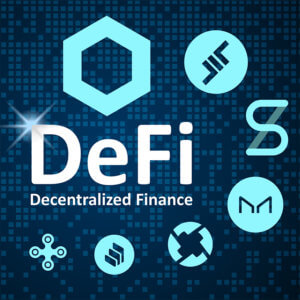 Courtesy of Paul Brody and Rodney Ramcharan, CoinDesk
Courtesy of Paul Brody and Rodney Ramcharan, CoinDesk
Paul Brody is EY’s global blockchain leader and a CoinDesk columnist. Rodney Ramcharan is a professor of finance and economics at the University of Southern California.
Sept. 12, 2022 — Believe it or not, the blockchain era is really America’s second experiment with decentralized finance (DeFi). Long before blockchains, the U.S. was the very last of the major industrial countries to establish a central bank. The Federal Reserve System was created in 1913, more than a century after the Bank of England was established and most big European countries had their own central banks as well. Even then, the Fed was established somewhat reluctantly after a series of financial crises.
Prior to the establishment of the Federal Reserve, banking in the U.S. operated like DeFi does today: a kind of “Wild West” with little regulation and no lender of last resort. As a result, a crisis at one bank could quickly lead to contagion at others. The specific crisis that triggered the creation of the Federal Reserve came from a highly leveraged short squeeze that went wrong, leaving the financing company, the Knickerbocker Trust, illiquid. Knickerbocker’s collapse led to a broader stock market plunge and a wave of bank runs.
As in 1913, the idea that regulators had a role to play wasn’t necessarily popular with everyone. The argument then, as it is now, is the same: Bank crises are painful, but they are a form of market discipline, and crypto ecosystems, because they lack central banks, offer a higher standard of discipline and performance.
Crypto was supposed to be better than 19th century banks. The extreme transparency that blockchain technology enables should have made it clear which funds and firms were operating on the edge, exposed to risky products. Four factors came together to make it hard for a transparent, disciplined market to emerge.
Related reading: Why DeFi Might Be Safer Than Traditional Finance
Four Factors
First, many companies and protocols have started to blend on-chain DeFi with off-chain but still unregulated centralized finance (CeFi). Instead of on-chain components that should be clear and transparent, the trail dead-ends in off-chain assets that are unknown or, worse, pledged to multiple owners. If an asset is pledged as collateral on-chain, that’s entirely visible to others. If the same asset is pledged off-chain, however, a firm might have liabilities far in excess of what people can determine by looking at on-chain data.
Consequently, if the firm doesn’t share that information, assessments made based on-chain data will be dangerously incomplete. Some of this was certainly out-and-out fraud. Much of it was evidence of how badly some firms scaled as they failed to segregate funds or monitor their own processes. It will likely be many months before some of the biggest bankruptcies are fully reported and investigated for us to find out.
Second, transparency has its limits. It’s all well and good that fully decentralized and on-chain systems are readable by end users. That doesn’t mean end users can understand what they are buying or how to evaluate the risks. Only a tiny fraction of crypto buyers have the technical knowledge (nevermind the time) to fully understand the most complex DeFi protocols. In short, as in traditional banking, end users or depositors are dispersed and lack the monitoring expertise to sufficiently discipline these institutions.
Not only are most users not equipped to understand protocols, you cannot have a “flight to quality” without effective benchmarks and other standards for on-chain and off-chain financial services. Banks are subject to liquidity and capital quality standards established by regulators and the results are published.
Finally, markets are not rational in the short run. A speculative frenzy sent everything upwards in the first part of the cycle in early 2021 and despair led people to liquidate quickly in the plunge, which began in November 2021 and continued through much of 2022. Reason may prevail over time, but, in the moment, investors tend not to behave rationally. The automated and interconnected nature of DeFi may accelerate the cascade of panic as well.
CFPB: Furnishers Have an Obligation to Investigate Consumer Disputes
 Courtesy of Seth Frotman, CFPB
Courtesy of Seth Frotman, CFPB
Sept. 12, 2022 — Even minor inaccuracies on a credit report can lead to a consumer being denied a loan, housing, or a job. As a result, it is critical that consumers have a meaningful opportunity to correct errors or inaccuracies when they are identified. Over the years, however, companies have relied on a series of legally dubious arguments to try to prevent consumers from being able to resolve problems on their credit reports — and protect themselves from being held accountable — when mistakes are made.
As the federal government agency charged with implementing and administering the federal consumer financial laws, the CFPB is committed to ensuring that companies follow the law. For that reason, the CFPB and the Federal Trade Commission (FTC), which together with the CFPB helps enforce fair credit reporting laws, filed an amicus brief yesterday in the U.S. Court of Appeals for the Third Circuit in Ingram v. Waypoint Resource Group, LLC, to ensure that businesses that provide information to credit reporting companies comply with the law and investigate potential inaccuracies or errors as required.
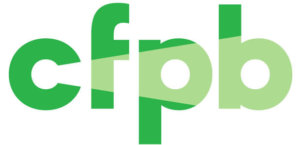 The responsibility of furnishers to investigate disputes
The responsibility of furnishers to investigate disputes
The Fair Credit Reporting Act (FCRA) provides consumers multiple ways to dispute inaccurate information on their credit reports. Commonly, consumers dispute the accuracy of information on their credit reports with the credit reporting company, such as Experian, Equifax, or TransUnion. In response, the credit reporting company often refers the dispute to the furnisher, which is the business that originally provided the disputed information. Consumers may also dispute the accuracy of information on their credit reports directly with the furnisher. For example, if a consumer’s credit report incorrectly states that a consumer has an outstanding credit card balance, the consumer can submit a dispute to the credit card company itself, file a dispute with the credit reporting company, or both.
When a consumer submits a dispute to a credit reporting company and it is passed along to the furnisher, the furnisher is then required to conduct its own investigation into the disputed information and report the results of its investigation back to the credit reporting company. Despite this clear obligation, some furnishers have argued that they are free to ignore disputes they decide are without merit.
The brief filed with the FTC indicates that a furnisher is required to investigate any dispute forwarded to it by a credit reporting company and can’t avoid that obligation by claiming a dispute is “frivolous.” Here are three reasons why.
FCRA is clear and unambiguous
First, the text of the FCRA is unambiguous. There is nothing in the statute that exempts a furnisher from investigating frivolous disputes forwarded by credit reporting companies. If Congress intended to allow furnishers not to investigate disputes that they thought were frivolous, it knew how to say so. In fact, in other parts of the statute, Congress expressly provided that certain frivolous disputes don’t need to be investigated.
Consumers have the right to be notified and informed of their options
Second, consumers are entitled to receive notice of the outcome of their disputes and to be informed of their options. When the FCRA, in other contexts, states that some disputes don’t need to be investigated, it consistently requires that the consumer be notified and advised of what additional information is necessary for the dispute to be investigated. If furnishers could just ignore disputes referred to them by credit reporting companies, that could create an unintended loophole that would allow the dispute to disappear into a proverbial “black hole.”
![]() Click here to read the entire article.
Click here to read the entire article.
Regulatory Risks May Discourage Small-Dollar Lending by Banks
Courtesy of Paul Calem, Bank Policy Institute
 Sept. 12, 2022 — Many U.S. households lack the financial resources needed to meet small, unexpected expenses, making them vulnerable to episodes of financial stress. When faced with cash shortfalls, these households typically rely on payday loans or other high-cost, nonbank credit products as their most readily available option.
Sept. 12, 2022 — Many U.S. households lack the financial resources needed to meet small, unexpected expenses, making them vulnerable to episodes of financial stress. When faced with cash shortfalls, these households typically rely on payday loans or other high-cost, nonbank credit products as their most readily available option.
For example, according to the 2022 Report on the Economic Well-Being of U.S. Households published by the Federal Reserve, about 32 percent of respondents to a recent, nationwide survey said they would have some difficulty coming up with $400 immediately (using cash, savings or a credit card paid off at the next statement.) About 70 percent of these households would cover the $400 expense at least in part by running a balance on their credit card or borrowing from a friend or a family member, while the remaining 30 percent would have to sell an asset, use a payday loan or simply not pay the unexpected expense.
Fortunately, the banking industry has been stepping up to provide lower-cost, small-dollar credit alternatives that allow financially vulnerable households to meet their short-term borrowing needs more sustainably. However, many banks remain on the sidelines, hesitant to develop and introduce small-dollar lending programs. At least in part this is due to perceived regulatory or supervisory risks for these programs arising from:
- Uncertainty about the regulatory and supervisory treatment of such products owing to numerous arbitrary changes made by regulatory agencies in the past
- The possibility that Congress may legislate a national interest rate cap that could result in banks making losses on these products
This post reviews the potential social benefits of bank-provided, small-dollar loans and the sources of regulatory uncertainty that may be impeding their availability. The discussion highlights how more supportive and coordinated treatment by the CFPB and the prudential banking agencies of these products would minimize the regulatory risks for banks that offer small-dollar products, thereby expanding the set of affordable borrowing options for households that struggle to pay small and unexpected expenses.
The Benefits of Small-Dollar Lending by Banks
Given the large share of households that have little or no financial cushion to absorb a small and unexpected expense, there is a clear need for small-dollar credit products that would meet their short-term, small-borrowing needs in a responsible manner. Most lower income households have relied on small-dollar credit products provided by non-banks, such as payday loans, for meeting such expenses.
These nonbank options have a high price to consumers, via very elevated interest rates or fees, and are characterized by lack of disclosure or transparency regarding their likely, ultimate all-in costs to the borrower. Moreover, these credit products are underwritten with minimal consideration to the borrower’s ability to repay. The repayment of such loans is often not affordable, necessitating rollover of the loan.
NCUA Releases Simplified CECL Tool for Small Credit Unions
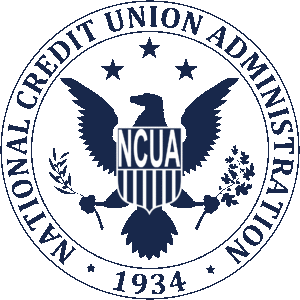 Sept. 14, 2022 — The National Credit Union Administration released today a new tool to help small credit unions comply with the Financial Accounting Standards Board’s accounting standard on current expected credit loss, or CECL, which goes into effect for most credit unions at the start of 2023. The CECL Tool is intended for use by credit unions with under $100 million in assets, although it could be used by larger credit unions based on the discretion of their management and auditors.
Sept. 14, 2022 — The National Credit Union Administration released today a new tool to help small credit unions comply with the Financial Accounting Standards Board’s accounting standard on current expected credit loss, or CECL, which goes into effect for most credit unions at the start of 2023. The CECL Tool is intended for use by credit unions with under $100 million in assets, although it could be used by larger credit unions based on the discretion of their management and auditors.
MEMBER BENEFIT: Click here to read NASCUS’s summary on this topic.
“The Simplified CECL Tool gives small credit unions a valuable resource to help them implement CECL without having to hire an econometrician or to use complicated models,” NCUA Chairman Todd M. Harper said. “With an uncertain economic picture, this tool provides relief for smaller credit unions, so they can focus on serving their members and communities. The NCUA will continue to provide CECL-related information on our website, and our staff is available to assist credit unions with using the tool and with other CECL-related questions.”
The Simplified CECL Tool uses the Weighted Average Remaining Maturity (WARM) methodology, which FASB supports, to estimate the allowance for credit loss. The tool is simple to use, requiring a credit union to enter its charter number, total assets, and loan portfolio balances. The loan portfolio categories in the tool mirror the categories in NCUA’s Call Report. For each loan portfolio category, the tool calculates the credit union’s net charge-off rate from its Call Report data and provides the industry-based WARM factor. The tool also allows the credit union to make qualitative adjustments for current conditions and reasonable and supportable forecasts, as required by CECL.
The Simplified CECL Tool, along with FAQs, a user guide, and information on the model used, is available on the NCUA website, CECL Resource Center.
Articles for September 9, 2022 Issue:
- U.S. Bank Regulator Warns of Crisis Risk from Fintech Proliferation
- NCUA’s Hood Laments Lack of Progress on Federal Law & Serving Cannabis Industry
- CFPB Intro’s Graphs Tool for Quarterly HMDA Data
- The CFPB Office of Inspector General Report: “Fiscal Years 2020 and 2021 Risk Assessment of the Bureau’s Purchase Card Program.”
- OCC Releases Strategic Plan for Fiscal Years 2023-2027
U.S. Bank Regulator Warns of Crisis Risk from Fintech Proliferation
Courtesy of Lananh Nguyen and Saeed Azhar, Reuters
 September 7, 2022 — The rise of fintech services and digital banking could spur financial risks and potentially a crisis over the long term, Michael Hsu, Acting Comptroller of the Currency, a major U.S. bank regulator, warned on Wednesday.
September 7, 2022 — The rise of fintech services and digital banking could spur financial risks and potentially a crisis over the long term, Michael Hsu, Acting Comptroller of the Currency, a major U.S. bank regulator, warned on Wednesday.
“I believe fintechs and big techs are having a large impact and warrant much more of our attention,” Hsu told a New York conference, noting the encroachment of fintech companies into the traditional financial sector, including via partnerships with banks, was creating more complexity and “de-integration” across the banking sector.
Related Reading: Here’s Where YC’s Latest Batch of Founders Are Placing Fintech Bets
Y Combinator’s latest cohort of founders have opinions on the future of fintech. One-fifth of the accelerator’s Summer 2022 batch, which spans 240 companies, is working on solving issues in the financial space. The pitches range from building the Square for micro-merchants in Latin America to creating a way to angel invest in your favorite athlete.
“My strong sense is that this process, left to its own devices, is likely to accelerate and expand until there is a severe problem, or even a crisis,” Hsu said.
Banks and tech firms, in an effort to provide a seamless customer experience, are teaming up in ways that make it more difficult for regulators to distinguish between where the bank stops and where the tech firm starts, said Hsu. And with fintech valuations falling as financing costs rise, bank partnerships with fintechs are increasing, he said.
That could create IT risks around information security and resilience, and also raises customer protection issues, said Hsu.
“I worry increasingly about the ‘unknowns’ and am concerned that the less familiar risks of this digital transition are unlabeled and thus unseen. As we learned from the 2008 financial crisis, risks that are unseen have a tendency to grow and later to be the source of nasty surprises,” said Hsu.
Earlier, Gene Ludwig, a former Comptroller of the Currency, also warned that regulations for fintechs are much less strict than those that govern banks.
“The non-banking industry is getting away with murder,” said Ludwig, who is now a managing partner of Canapi Ventures, a venture capital firm.
Ludwig predicted non-banks “will get us into the next financial crisis if we don’t do something about it.”
U.S. regulators have been wary of allowing banks to dive into cryptocurrencies, which have slumped in recent months on fears interest rate hikes will end the era of cheap money. Several crypto companies have filed for bankruptcy.
Hsu said that the turmoil had “all of the hallmarks of a classic run” on an interconnected industry that had problems, and cautioned that the market is very “hype-driven.”
NCUA’s Hood Laments Lack of Progress on Federal Law & Serving Cannabis Industry
Courtesy of CUToday.info

The Honorable Rodney Hood speaking at the 2022 NASCUS Cannabis Symposium
September 7, 2022 —Lamenting there has been little progress made at the federal level since he last addressed the same group, NCUA Board Member Rodney Hood told a cannabis industry meeting it remains up to Congress to act, and that the compliance demands in serving pot companies has even driven one CU to stop accepting new business.
In remarks to the PBC Conference, which stands for payments, banking and compliance in the cannabis industry, Hood said his position remains the same as when he offered remarks in 2021, and he repeated his position there is an “urgent need to reform banking laws as they pertain to marijuana-related businesses.”
“It is essential that Congress take legislative action to clarify and harmonize the laws and regulations surrounding the state-legal cannabis industry and marijuana-related businesses, so the industry can take part in the legitimate financial services industry,” he said.
Related Reading: Even As Some CUs Have Expanded Outreach to Cannabis Biz, the Businesses Themselves Have Found Profitability to be Harsh
Even as some credit unions have worked to expand services to cannabis-related businesses, and one cannabis business services CUSO went public for $185 million, most of those same cannabis companies are not making money themselves, according to a new report.
Hood said there has been little progress on the issue since he last addressed the group. Indeed, he cited a recent report noting Vermont State Employees Credit Union has stopped accepting new accounts from businesses in the cannabis industry, after reporting it had received a spike in applications from a large number of cannabis enterprises for accounts. VSECU expressed concern it does not have the compliance mechanisms in place to service so many new accounts, Hood said.
As if Things are ‘Moving Backward’
“Keep in mind, this is an institution that’s been providing financial services to cannabis businesses for some time, since Vermont legalized medical marijuana in Vermont almost two decades ago, in 2004,” Hood commented. “So, they’re pretty far ahead in having addressed a lot of the challenges that many other states are struggling with now, in terms of determining how to manage financial services for cannabis businesses.”
Given what’s happened in Vermont, Hood added it’s “almost as if things are actually moving backward.” Hood said he does not blame VSECU for its decision, saying that as cooperative-credit institutions, credit union leaders have to weigh risks carefully as a fiduciary responsibility to their member-owners.
“I share this anecdote from Vermont not to discourage you, but as a concrete reminder of how much work we still have to do,” Hood told the meeting. “And yet, with all that said, I’m still quite optimistic about the prospects for the future. Because the reality is that we are seeing momentum on this issue, even if it’s moving more slowly than the cannabis industry, the financial services industry, and financial regulators would like.”
Center of Debate
Hood said cannabis banking was an issue that even just a few years ago seemed marginal but it has now moved to the center of public debate and attention.
“Moreover, we’re seeing some extremely positive signs in the form of engagement from policymakers at every level. Last December, Treasury Secretary Janet Yellen told Congress that banking reform for marijuana-related businesses would allow for more efficient tax collection from this growing industry,” Hood said. “Over the last few months, both the U.S. Council of Mayors and the National Council of State Legislatures issued resolutions calling on Congress to address the marijuana banking issue. So, we’re seeing more policymakers stepping forward with a highly reasonable and pragmatic approach to the issue, on a bipartisan basis. Again, that’s a positive development.”
According to Hood, private sector solutions have also increased to address the gap in banking services for cannabis businesses, and there has been progress at the state level as well.
‘Making It Impossible’
“Here’s the fundamental thing I’ve been trying to get legislators to understand: this state of affairs is making it impossible for (regulators) to do our jobs,” Hood said. “If you’re in the legal cannabis business, it’s making it hard to plan for the future, both short- and long-term, particularly for the smaller players. If you’re in the financial services industry, it’s making it hard to conduct transactions with this legal, and growing industry. And if you’re like me, on the regulatory side of things, the lack of clarity is making it hard for us to tell you all what you need to be doing.
“Moreover, this state of affairs is making it impossible for this increasingly legal industry to thrive,” he continued. “Here we have a burgeoning legal industry—projected to generate some $32 billion in sales this year and to grow to more than $45 billion by 2025—that desperately needs access to capital and access to safe, affordable financial services. Instead, many players either have to conduct transactions in cash, which is both inconvenient and dangerous, or they have to pay a premium for services.”
Hood urged attendees to “keep doing what you’re doing.”
CFPB Intro’s Graphs Tool for Quarterly HMDA Data
Courtesy of CUToday.info
 September 6, 2022 —The Consumer Financial Protection Bureau (CFPB) has introduced a new graphs tool that utilizes quarterly Home Mortgage Disclosure Act (HMDA) data reported by certain financial institutions.
September 6, 2022 —The Consumer Financial Protection Bureau (CFPB) has introduced a new graphs tool that utilizes quarterly Home Mortgage Disclosure Act (HMDA) data reported by certain financial institutions.
According to the CFPB, the new quarterly graphs tool gives users the ability to review a total of 21 graphs organized according to questions often asked about the mortgage market. The Bureau explained the graphs show aggregated filing information in numerous categories, including combined loan-to-value ratio, credit score, debt-to-income ratio, denial rates, interest rates, loan and application counts, and total loan costs.
In announcing the new tool, the Bureau reminded that under 2015 revisions to the Consumer Financial Protection Bureau’s (CFPB) HMDA rule (Regulation C), quarterly data is submitted by financial institutions that report a combined total of at least 60,000 applications and covered loans, excluding purchased covered loans, for the preceding calendar year.
Multiple Formats
“To help the public use the new data, the tool allows for the download of the graphs and the displayed data in CSV or XLS format, custom URL sharing, and the opportunity to save the graph as a PDF,” the Bureau stated. “The HMDA Graphs tool currently contains data for 2019, 2020, 2021, and the first quarter of 2022. Data for each new quarter will be added as soon as it is available.”
The CFPB Office of Inspector General Report: “Fiscal Years 2020 and 2021 Risk Assessment of the Bureau’s Purchase Card Program.”
August 31, 2022 — Click here to read the entire six-page report
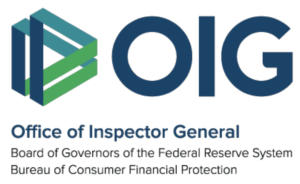 Executive Summary
Executive Summary
We have conducted a risk assessment of the Bureau of Consumer Financial Protection’s purchase card program to determine the necessary frequency and scope of purchase card audits. The results of the risk assessment show that the risk of illegal, improper, or erroneous use in the Bureau’s purchase card program is low. As a result, we will not recommend that an audit of the program for fiscal year 2022 be included in our 2023 annual audit plan.
The results of the risk assessment should not be interpreted to mean that a lower-risk program is free of illegal, improper, or erroneous use or internal control deficiencies. An audit of the program may identify issues not previously noted in the risk assessment. For instance, the overall risk level for the purchase card program may be assessed as low based on the design of internal controls and the size of the program; however, an audit may find that controls are not working effectively or that illegal, improper, or erroneous activity has taken place.
Background
The Government Charge Card Abuse Prevention Act of 2012 requires the inspector general of each executive agency to conduct periodic assessments or audits of purchase card programs to identify and analyze the risks of illegal, improper, or erroneous purchases and payments. In September 2013, the Office of Management and Budget (OMB) issued OMB Memorandum M-13-21, Implementation of the Government Charge Card Abuse Prevention Act of 2012, which states that inspectors general will conduct annual risk assessments of agency purchase card programs to analyze the risks of illegal, improper, or erroneous purchases. OMB directed that these risk assessments be used to determine the necessary scope, frequency, and number of audits or reviews of the purchase card program.
The Bureau participates in the U.S. General Services Administration’s SmartPay 3 program through a task order with the U.S. Department of the Treasury’s master contract with Citibank. Within Treasury, the Bureau of the Fiscal Service, Administrative Resource Center provides purchase card administrative services and acts as the liaison between the Bureau and Citibank. The Bureau’s Office of Procurement is responsible for managing the operation of the purchase card program and ensuring that the program complies with applicable laws, regulations, policies, and procedures.
The Office of Procurement also monitors the effectiveness of the purchase card program as a payment vehicle while working to ensure that the proper controls are in place. The Bureau operates its purchase card program under the policies and procedures set forth in its Purchase Card Policy and Management Plan, which was finalized in June 2018.
During the period of our review, October 1, 2019, through September 30, 2021, a total of 116 Bureau purchase cardholders had 7,037 purchase transactions totaling about $3.46 million.
OCC Releases Strategic Plan for Fiscal Years 2023-2027
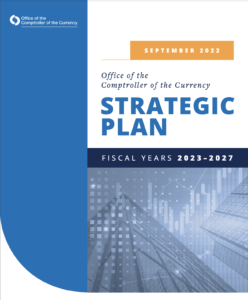 September 6, 2022 — The Office of the Comptroller of the Currency (OCC) today released its strategic plan for fiscal years (FY) 2023-2027.
September 6, 2022 — The Office of the Comptroller of the Currency (OCC) today released its strategic plan for fiscal years (FY) 2023-2027.
The strategic plan outlines the agency’s approach to achieve three strategic goals and fulfill its mission to ensure that national banks and federal savings associations operate in a safe and sound manner, provide fair access to financial services, treat customers fairly, and comply with applicable laws and regulations.
The OCC will invest in its people, operations, processes, and technology to meet its strategic goals for FY 2023-2027 that focus on
- Agility and learning
- Credibility and trust
- Leading on supervision as the banking system evolves
![]() Click here to read Strategic Plan for Fiscal Years 2023-2027 (PDF)
Click here to read Strategic Plan for Fiscal Years 2023-2027 (PDF)
Articles for September 2, 2022 Issue:
- How Regulatory Sandbox Programs Can Promote Technological Innovation and Consumer Welfare
- A Showdown Is Coming Over Who Is Liable For P2P Payments Fraud
- CFPB Plan for Reg E, EFT Act is Unlawful, CUNA Says
- A Busy Week at the NCUA
How Regulatory Sandbox Programs Can Promote Technological Innovation and Consumer Welfare
 Insights from Federal and State Experience
Insights from Federal and State Experience
Courtesy of Ryan Nabil, Competitive Enterprise Institute
Around the world, leading financial centers seek to attract companies capable of developing innovative financial products and services. From blockchain-based payments to alternative credit scoring systems, technological innovation is critical to maintaining a globally competitive financial sector that benefits consumers, investors, and entrepreneurs. However, the financial services industry, especially in the United States, remains heavily regulated. Such cumbersome regulations can deter both established companies and startups from offering innovative financial products and services.[i] Governments can use various policy tools to address this challenge and promote innovation.
Among the options gaining popularity are “regulatory sandbox” programs, which allow companies to test innovative products and services under a modified and frequently lightened regulatory framework for a limited period. These programs allow companies to test new financial products and enable regulators to become more familiar with technological innovation and its impact on businesses. By allowing regulators to evaluate how different rules impact businesses, sandbox programs can provide crucial information to help regulators craft business- and innovation-friendly rules.
Major International and U.S. Sandbox Programs. In 2016, the United Kingdom’s Financial Conduct Authority (FCA) launched the world’s first regulatory sandbox program.[ii] Since then, more than 50 jurisdictions around the world have adopted similar programs, according to the World Bank.[iii] This policy brief draws from regulatory experiences in five jurisdictions—the United States, Australia, Canada, Hong Kong, and the United Kingdom—but focuses on sandbox programs in the United States.[iv]
In the United States, due to the dual state-federal and overlapping financial regulatory authority, federal agencies and state regulators can run separate sandbox programs. The Consumer Financial Protection Bureau (CFPB) runs the Compliance Assistance Sandbox and the Trial Disclosure Sandbox, which are currently the only federal regulatory sandbox programs in the United States (Table 1). The CFPB can also grant no-action letters stating its intention not to pursue enforcement actions against a particular company if it adheres to specific rules and regulations.[v]
Although the Consumer Financial Protection Bureau’s sandbox and no-action letter programs are reportedly still in operation, their future remains uncertain because of the CFPB’s recent change in regulatory approach. In May 2022, the CFPB formed the Office of Competition and Innovation, replacing the Office of Innovation, which was in charge of the agency’s sandbox programs.[vi] In a press release published on May 24, 2022, the CFPB states:
After a review of these programs, the agency concludes that the initiatives proved to be ineffective and that some firms participating in these programs made public statements indicating that the Bureau had conferred benefits upon them that the Bureau expressly did not.[vii]
In June 2022, a CFPB representative clarified that it would not discontinue these two programs.[viii] Instead, the newly established office—which emphasizes competition as part of a new approach to financial innovation—will encourage companies to submit rulemaking petitions.[ix] Due to the Bureau’s current lack of interest in the no-action letter and sandbox programs, they are unlikely to play any significant role in promoting U.S. financial innovation—unless the CFPB changes course under a future administration or Congress establishes a new federal sandbox regime.
The lack of an effective federal sandbox program has cleared the way for state governments to play a leading role in creating regulatory sandboxes. In August 2018, Arizona became the first U.S. state to pass legislation creating a financial technology (FinTech) sandbox program,[x] followed by Utah and Kentucky in March 2019.[xi] Although Utah initially created both insurance and FinTech sandboxes, it replaced them in May 2022 with an expanded General Regulatory Sandbox—which targets innovations in multiple industries, including financial services, advanced manufacturing, and life sciences and health care.[xii]
As of August 2022, at least 11 states have established regulatory sandboxes: Arizona, Florida, Hawaii, Kentucky, Nevada, North Carolina, South Dakota, Utah, Vermont, West Virginia, and Wyoming.[xiii]
Among these states, only Arizona, Hawaii, and West Virginia run FinTech sandboxes that have admitted at least one participant as of November 2021 (Table 2). The FinTech sandboxes in Arizona, Hawaii, and West Virginia—along with the CFPB’s Compliance Assistance Sandbox—have admitted 31 companies as of November 2021 (Table 2). The Utah Supreme Court’s legal services sandbox has admitted 31 companies as of September 2021.[xiv] By comparison, 223 companies have participated in the Hong Kong Monetary Authority sandbox, while 178 companies have participated in the two different sandbox programs run by the UK’s Financial Conduct Authority (Table 1). (Unless otherwise indicated, the status of sandbox programs, the number of sandbox participants, and other related data in Tables 1 and 2 reflect information up to date as of November 2021.)
![]() Click here to read the report [PDF]
Click here to read the report [PDF]
Click here to read the entire article
A Showdown Is Coming Over Who Is Liable For P2P Payments Fraud
Courtesy of Kate Berry, American Banker
 The Consumer Financial Protection Bureau is expected to issue guidance soon on banks’ liabilities for fraud perpetrated on digital payments platforms like Zelle, setting up a major regulatory fight that could play out for years.
The Consumer Financial Protection Bureau is expected to issue guidance soon on banks’ liabilities for fraud perpetrated on digital payments platforms like Zelle, setting up a major regulatory fight that could play out for years.
Financial institutions claim they cannot be held liable when a consumer incorrectly sends an electronic payment to the wrong person or gets tricked by a criminal and authorizes a payment that turns out to be a scam or fraud. Banks and credit unions are likely to sue the bureau if it tries to assign broad liability for fraudulent payments authorized by consumers. Some expect the CFPB will need to issue a rulemaking if it tries to mandate that consumers get repaid for fraud.
“Most consumers do not know that there is a difference between sending payments from PayPal’s wallet or their underlying bank account,” said Aaron Klein, senior fellow at the Center on Regulation and Markets at the Brookings Institution. The issue is complicated because the 1970s-era law governing electronic payments — the Electronic Fund Transfer Act of 1978 — is woefully out of date.
The law never envisioned that consumers would transfer money to criminals or someone they do not know in response to an unexpected text or phone call, Klein says, and from a public policy perspective, consumers have come to believe that instant payments and digital wallets have the same consumer protections as credit cards.
“It’s important that the bureau modernizes Regulation E to deal with the realities of digital wallets existing outside of traditional banks,” Klein said.
The CFPB has clear authority to interpret the EFTA and could clarify that, in certain circumstances, a payment is an “error” when a consumer is defrauded into initiating an electronic transfer to a fraudster. The bureau also could add a new category of error for fraudulently-induced payment and may also clarify that EFTA applies to all electronic payments.
The EFTA has a list of seven categories of error, including unauthorized payments and incorrect transfers by a financial institution that require consumers be reimbursed if they notify their institution promptly. But at the time the act was passed, electronic transfers were almost exclusively executed by banks or other financial institutions, and as a result “errors” have traditionally been interpreted to have been made by financial institutions — not the consumer.
“I think there’s an excellent legal argument that a customer mistake is an incorrect transfer,” said Gail Hillebrand, a payments expert and former CFPB associate director for consumer education and engagement. “What’s more incorrect than sending your money to the wrong person?”
Hillebrand also said that a failure by financial institutions or payment providers to act to prevent fraud can be considered an “unfair” practice that the CFPB could enforce under its general prohibition against “unfair, deceptive or abusive acts or practices,” known as UDAAP. The CFPB has already taken some steps to apply UDAAP to payments.
In July, the CFPB fined Bank of America $100 million for botching the disbursement of unemployment benefits on prepaid cards. And earlier this month the CFPB said in a circular that a failure to prevent fraud and identity theft can constitute an “unfair” practice. Several Democratic lawmakers have urged CFPB Director Rohit Chopra to take steps to provide stronger protections for consumers after a spate of news stories and lawsuits against banks and payment providers.
Click here to read the entire article.
CFPB Plan for Reg E, EFT Act is Unlawful, CUNA Says
 Courtesy of CUToday.info
Courtesy of CUToday.info
The Consumer Financial Protection Bureau’s rumored plan to expand Regulation E and the Electronic Fund Transfer Act (EFTA) is unlawful, would contravene the bill’s text, and would run afoul of the Administrative Procedures Act, CUNA wrote to the CFPB.
“CUNA and the credit unions it represents strongly support efforts to stop fraudulent schemes, robust compliance programs to limit this activity, and all efforts at the federal level to mandate safe and reliable payment platforms,” the letter reads. “But expanding current law to punish member-owned credit unions for the actions of a rogue fraudulent actor, despite no fault of the credit union or other members, is not only unwise: it is unlawful,” it adds.
Liability Concerns
CUNA argued the CFPB cannot impose liability in the EFTA without Congressional revisions, nor can it revise Regulation E to impose liability on credit unions without going through the formal rulemaking process.
“CUNA asserts that the aforementioned changes, imposing new credit union liability and new requirements through the rumored guidance would not be the act of promulgating guidance at all, it would be issuing a legislative rule without going through the formal rulemaking processes,” the letter reads.
‘CFPB Would Also Benefit’
CUNA added that a rulemaking process will benefit the CFPB, credit unions, and consumers, as in addition to the legal obligation it will allow the CFPB to hear from stakeholders and ensure its regulations reflect sound policy.
CUNA further told the Bureau the “expansive burden” of forcing credit unions to pay for the misdeeds of fraudulent actors “would put a major strain on credit union resources and their ability to collaborate with payments platforms and expand consumer choice.”
A Busy Week at the NCUA
 NCUA Grants Will Allow Low-Income Credit Unions to Expand Service, Build Capacity
NCUA Grants Will Allow Low-Income Credit Unions to Expand Service, Build Capacity
Sept. 1, 2022 – The National Credit Union Administration has awarded more than $1.5 million in Community Development Revolving Loan Fund grants to help 90 low-income credit unions expand outreach to underserved communities, participate in mentoring relationships, receive training, and improve digital services and security.
“Low-income credit unions are on the frontlines of expanding access to safe, fair, and affordable credit, and these grants to credit unions will allow those institutions to expand services, build capacity, create professional support networks, and bolster their capacity to withstand cyberattacks,” NCUA Chairman Todd M. Harper said. “Again this year, we have seen the need far exceed our available resources, so I am very pleased that Congress is considering increasing the annual allocation. With more money, the NCUA will be able to make more grants and bigger grants through the Revolving Loan Fund.”
The NCUA awarded grants ranging from $1,400 to $50,000 to credit unions in 43 states and the District of Columbia. Twenty-eight credit unions were first-time grant recipients. Sixteen grantees were minority depository institutions. The NCUA made awards in four categories:
- Underserved outreach: 21 grants totaling $943,488
- Small Low-Income Credit Union (LICU) mentoring: 3 grants totaling $75,000
- Digital services and cyber security: 52 grants totaling $484,165
- Training: 14 grants totaling $64,510
During the 2022 grant round, the agency received 220 grant applications totaling more than $4.7 million.
 Letter to Credit Unions (22-CU-09): Updates to Interest Rate Risk Supervisory Framework
Letter to Credit Unions (22-CU-09): Updates to Interest Rate Risk Supervisory Framework
The NCUA has revised its interest rate risk (IRR) supervisory framework and issued the attached Supervisory Letter to exam staff to increase clarity and flexibility. The changes to the IRR supervisory framework will improve the focus of the NCUA’s supervision of IRR in credit unions given current market conditions.
The primary changes to the NCUA’s supervisory framework are:
- Revising the risk classifications by eliminating the extreme risk classification and modifying the high risk classification;
- Clarifying when a Document of Resolution (DOR) to address IRR is warranted, including removing any presumed need for a DOR based on an IRR supervisory risk classification and related need for a credit union to develop a de-risking plan;
- Providing examiners more flexibility in assigning IRR supervisory risk ratings; and
- Revising examination procedures to incorporate updated review steps when assessing how a credit union’s management of IRR is adapting to changes in the economic and interest rate environment.
Responding to changing economic and interest rate environments is essential to credit unions’ prudent IRR management and the related risks to capital, asset quality, earnings, and liquidity. Credit unions need to remain disciplined in managing their interest rate, liquidity, and related risks as they navigate the current economic and interest rate environment.
The attached Supervisory Letter will help federally insured credit unions better understand the NCUA’s expectations for managing IRR. I encourage all federally insured credit unions to review the enclosed Supervisory Letter and to take appropriate steps to mitigate risk, if needed.
The NCUA will continue to periodically assess the risk classifications and parameters used in its IRR measurements to ensure their appropriateness. Please contact your NCUA regional office or state supervisory authority if you have any questions.
NCUA to Distribute $395 Million Under Corporate System Resolution Program
The National Credit Union Administration, in its role as liquidating agent, announced a $313 million distribution to more than 400 membership and paid in capital shareholders of the former Members United, Constitution, and U.S. Central corporate credit unions. NCUA will also distribute $82 million in dividends to more than 1,100 shareholders of Southwest Corporate. NCUA completed capital distributions to Southwest Corporate capital holders last year.
“The NCUA has reached another milestone in winding down the remaining asset management estates under the successful Corporate System Resolution Program,” Chairman Todd M. Harper said. “Thanks to the diligent efforts of the NCUA team over more than a decade, we continue to fulfill our fiduciary responsibility to return these funds to capital holders. As a result, the federally insured credit unions receiving these distributions will have the capacity to lend more and better offer safe, fair, and affordable financial products. That is good for credit union members and for our economy.”
As liquidating agent of the former corporate credit unions’ asset management estates, the NCUA has previously made four rounds of distributions. In 2020, 2021, and the first quarter of 2022, distributions were made to capital holders of Southwest, Members United, Constitution, and U.S. Central. The distribution announced today is scheduled to occur before the end of September 2022. With this fifth distribution, the NCUA will have returned more than $2.6 billion to former membership and paid-in capital shareholders and almost $292 million in dividends to shareholders.
The Corporate System Resolution Program is a landmark initiative established by the NCUA Board to stabilize, resolve, and reform the corporate credit union system in the wake of the 2008 financial crisis. The program allowed the credit union system to absorb the failures of U.S. Central, Western, Southwest, Members United, and Constitution corporate credit unions over time.
Articles for August 26, 2022 Issue:
- Federal Reserve Bank of Boston: A Victimless Crime? Hardly; the Impacts of Synthetic Identity Fraud
- Fed Says Banks Should Notify it Before Dipping into Crypto
- CFPB: Why We’re Modernizing How We Collect Credit Card Data
- Federal Reserve Bank of New York: How Much Did Supply Constraints Boost U.S. Inflation?
Federal Reserve Bank of Boston: A Victimless Crime?
Hardly; the Impacts of Synthetic Identity Fraud
 Synthetic identity fraud costs billions and damages lives, but the Fed helps orgs deal with it.
Synthetic identity fraud costs billions and damages lives, but the Fed helps orgs deal with it.
Courtesy of Mike Timoney, Federal Reserve Bank of Boston
Is synthetic identity fraud a victimless crime?
After all, the “person” whose identity is used to commit the fraud isn’t a person at all. It’s a collection of personal information, some fictitious, some stolen, that’s combined to create an individual who only exists electronically. No single person’s identity is taken and misused. No one person sees his or her name and hard-earned reputation traded on and violated. But just because this kind of identity fraud doesn’t steal from a named victim, it doesn’t mean there aren’t victims. In fact, they come from all over. They include the people – often children – whose Social Security numbers are taken by synthetic identity fraudsters, and who later find their credit ruined.
They include individuals and businesses who struggled to survive the pandemic after synthetic identities “borrowed” millions in loans that could have gone to them. And they include those devastated by crimes the fraud underwrites, including human trafficking and terrorist financing. The damage done by synthetic identity fraud is far-reaching – with losses estimated at $20 billion in 2020 – and the list of victims keeps growing. That’s why the Federal Reserve is researching it, educating the industry about it, and encouraging action to address it.
A synthetic identity is painstakingly built
The building blocks of synthetic identity fraud are “personally identifiable information,” or PII. This includes names, birthdates, and Social Security numbers. Children often are targeted because the theft can go undetected for years, until they’re old enough to apply for credit or a job.
The fraudsters combine PII with fabricated information, such as a phone number or email address, to build a synthetic identity. They then use that identity to apply for a line of credit. The application often is rejected because no credit profile history exists. But now the credit bureaus have a credit file for the synthetic identity.
The fraudster keeps applying for credit as the synthetic identity until it is approved and they can start building a positive credit history. The goal? Higher credit limits and access to more sophisticated financial products and services, so there’s more to steal.
Synthetic identity fraud is not new. But new opportunities to commit it exist with the widespread digitization of financial systems and a rise in compromised PII, including a 68% year-over-year increase in reported data breaches in 2021. The Fed first mobilized against synthetic identity fraud in 2018, when we began working with the payments industry to raise awareness. We have researched how this type of fraud is defined, committed, detected, and mitigated.
Initial findings were detailed in a series of three white papers in 2019 and 2020. We then worked with fraud experts from across the industry to develop a common definition of synthetic identity fraud. That definition was incorporated into our FraudClassifierSM model to help organizations and industries more consistently classify and track this type of fraud. Most recently, we released a Synthetic Identity Fraud Mitigation Toolkit.
New toolkit aims to simplify complex problem, equip orgs to deal with it
The Fed created the toolkit in partnership with the industry to be a dynamic repository for information about synthetic identities, how they’re used, and how to mitigate this type of fraud. We all learn differently, so the toolkit aims to appeal to the different ways people consume information. It has downloadable documents, videos, and interactive tools that challenge readers to spot synthetic identities in various scenarios.
Our goal was to make the complex information more accessible by organizing the toolkit into modules that focus on particular topics. The first four modules focus on the definition, background, and mechanics of synthetic identity fraud. They also aim to raise awareness about how to spot synthetic identities that may be cloaked as good customers. The next two modules discuss ways to validate identities and detect synthetics, from the time a “customer” opens an account through the aftermath of a fraud loss.
The remaining two modules emphasize the importance of technology and fraud data strategy, including how artificial intelligence/machine learning can be used to root out synthetic identities. They also stress that collaboration is critical. Synthetic identities usually aren’t unique to a single organization, so it can be easier to shut down attacks when organizations work together.
It’s important that organizations understand that synthetic identity fraud is not an emerging threat – it’s a clear and present one. They also need to know that we at the Fed will continue to partner with them to help deal with it.
Fed Says Banks Should Notify it Before Dipping into Crypto
 Courtesy of Jon Hill, Law360
Courtesy of Jon Hill, Law360
August 16, 2022 — The Federal Reserve issued guidance Tuesday for what banks under its oversight should do before getting involved in any cryptocurrency-related activities, saying it wants to receive a heads-up from them for starters.
The Fed outlined its expectations in a supervisory letter that signaled openness to more banks wading into the emerging crypto sector, though the letter did not directly address the legal permissibility of any specific crypto activities, such as providing custody services or holding stablecoin reserves.
The letter instead said Fed-supervised banks should verify permissibility for themselves prior to taking on any new crypto activities. In particular, banks “must analyze the permissibility of such activities under relevant state and federal laws and determine whether any filings are required,” the Fed said.
“If any supervised banking organization has questions regarding the permissibility of any crypto-asset-related activities or about the applicability of any filing requirements, it should consult its lead supervisory point of contact at the Federal Reserve,” the letter added.
Either way, banks should provide their Fed supervisors with notification in advance of any planned crypto activities, according to the letter. And if a bank is already engaged in such activities, the letter said it should “promptly” alert its primary supervisory contact at the Fed.
“Federal Reserve supervisory staff will provide relevant supervisory feedback, as appropriate, in a timely manner,” the Fed said in its letter.
The letter further stressed that the Fed expects banks to have “adequate systems, risk management and controls” in place before undertaking any crypto activities. These guardrails should provide for the ongoing identification, measurement, monitoring and mitigation of risks arising from those activities, according to the Fed.
More specifically, the Fed advised that banks should have systems capable of addressing the full range of operational, financial, legal and compliance risks posed by their planned activities involving crypto, which the letter said can present “heightened and novel risks” related to bank safety and soundness, illicit finance and consumer protection.
“State member banks are also encouraged to notify their state regulator prior to engaging in any crypto-asset-related activity,” the Fed said.
Tuesday’s supervisory letter comes after the Office of the Comptroller of the Currency released guidance in November that likewise instructed banks under its oversight to provide it with prior notice of any planned crypto activities.
The OCC had previously authorized crypto custody services and certain other crypto-related activities as permissible for its banks, but its guidance late last year stipulated that they would need to wait for the agency’s “supervisory non-objection” to their plans before proceeding.
The Fed’s letter, by contrast, does not expressly include a non-objection requirement. Its silence on the permissibility of any particular crypto activities also distinguishes the letter from the OCC’s guidance, which has come under fire from some Democratic senators who see it as insufficiently rigorous.
CFPB: Why We’re Modernizing How We Collect Credit Card Data
 August 16, 2022 —When shopping online or in store, people like to weigh the costs and benefits of different products before they make a purchase, but it can be a challenge for consumers to compare interest rates across credit cards. Often, this price is hidden behind other promotional terms such as introductory rates, cash back rewards, or sign-up bonuses.
August 16, 2022 —When shopping online or in store, people like to weigh the costs and benefits of different products before they make a purchase, but it can be a challenge for consumers to compare interest rates across credit cards. Often, this price is hidden behind other promotional terms such as introductory rates, cash back rewards, or sign-up bonuses.
The lack of transparency in credit card terms and conditions is not new. In 1988, Congress passed the Fair Credit and Charge Card Disclosure Act to provide for a more detailed and uniform disclosure of credit card rates and fees by issuers. The Act originally required the Board of Governors of the Federal Reserve to collect credit card price and availability data from a sample of credit card issuers and make them available to the public; starting in 2011, this responsibility transferred to the CFPB. Twice per year, at least 150 issuers submit information to the CFPB on their largest credit card plans, including interest rates and fees, through our Terms of Credit Card Plans (TCCP) Survey.
The way this data is currently collected and published can be updated to help make it easier for people to shop for credit cards. For example, card issuers do not have to disclose realistic rates based on someone’s creditworthiness and instead report the midpoints of broad ranges that are often meaningless to people trying to compare cards.
![]() Related Reading: OPINION CFPB’s Approach To Regulations Is Taking Away Consumer Choice
Related Reading: OPINION CFPB’s Approach To Regulations Is Taking Away Consumer Choice
Companies in the accounts receivable management industry believe that consumers and those providing services in the financial services marketplace deserve a seat at the table. Congress enacted various laws outlining how federal agencies, even those independent from the congressional appropriations process, must act when engaging in policymaking. Yet the CFPB is blatantly ignoring those mandates.
To spur competition and give Americans the power to shop around and choose the best credit card for their needs, the CFPB is considering modernizing the TCCP Survey by:
Collecting median rates by credit score tiers
Issuers frequently disclose the purchase Annual Percentage Rate (APR) to shoppers as a range based on creditworthiness. Yet, consumers do not usually know where they fall within an issuer’s range of APRs until after applying and being approved for a credit card. Because applying for a credit card requires a hard credit inquiry—which may negatively impact one’s credit scores—some people may be hesitant to apply for multiple credit cards. This structural barrier may discourage consumers from searching widely for the best rate.
To provide people with a better understanding of the price of different credit cards, we are considering requiring selected issuers to submit data on the median APR offered to consumers in three broad credit score tiers. People often have a general idea of their credit scores, so seeing the median APR for their range will allow them to better compare realistic APRs across products and estimate the potential cost of borrowing before they apply.
Gathering information on credit cards available to specific communities or groups
Many smaller institutions like regional banks and credit unions only offer credit cards to people in particular communities or with specific affiliations. These institutions may offer better rates than the top issuers, but often do not advertise as widely as the biggest players.
By collecting and disclosing information on requirements for opening these types of accounts, we could help consumers see if they’re eligible for certain products and offer a free platform for local organizations focused on relationship banking to find customers.
Federal Reserve Bank of New York: How Much Did Supply Constraints Boost U.S. Inflation?
Courtesy of Julian di Giovanni, Federal Reserve Bank of New York
August 24, 2022 — What factors are behind the recent inflation surge has been a huge topic of debate amongst academics and policymakers. We know that pandemic-related supply constraints such as labor shortages and supply chain bottlenecks have been key factors pushing inflation higher. These bottlenecks started with the pandemic (lockdowns, sick workers) and were made worse by the push arising from increased demand caused by very expansionary fiscal and monetary policy. Our analysis of the relative importance of supply-side versus demand-side factors finds 60 percent of U.S. inflation over the 2019-21 period was due to the jump in demand for goods while 40 percent owed to supply-side issues that magnified the impact of this higher demand.
The Debate
The U.S. has witnessed near historic inflation since the economy began to re-open in 2021 following the COVID-19 lockdowns, as seen in the chart below. There have been several factors put forth to explain this inflation outburst and its persistence, which have been difficult for policymakers to disentangle and have led to an active debate by leading economists. Some analysts have focused on the importance of supply chain constraints, while others point to demand as driving the jump in inflation. Meanwhile, some economists argue that a combination of supply and demand factors are necessary to generate the inflation we are currently witnessing. Our work belongs to the last camp.
Inflation has been very elevated
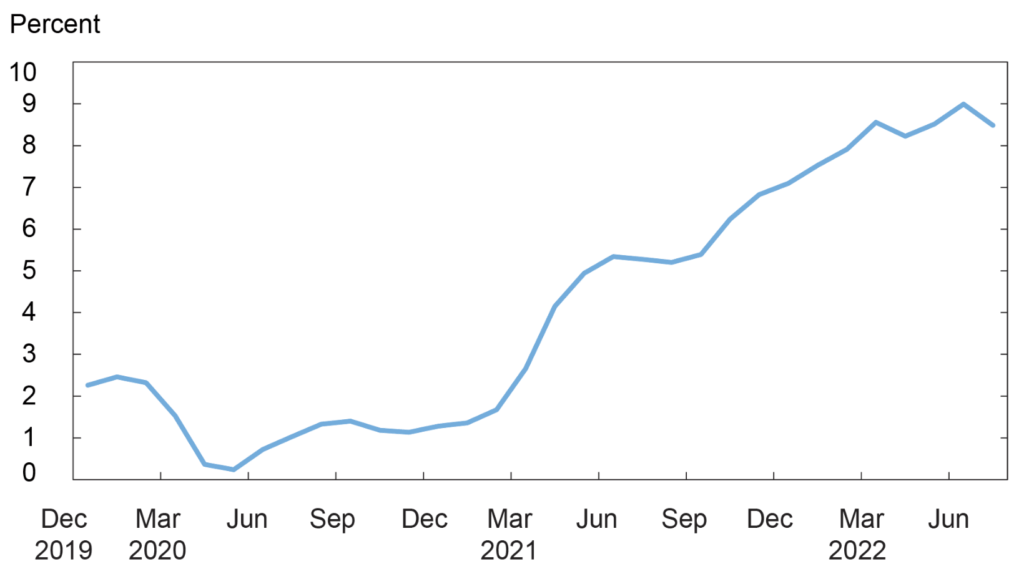
Source: U.S. Bureau of Labor Statistics. Notes: This chart plots the consumer price index (CPI) for all urban consumers (all items in U.S. city average). The monthly series represents the percentage change from a year ago and is not seasonally adjusted.
A Model-Based Approach
Arriving at a definitive understanding of the relative importance of demand and supply drivers of inflation is difficult without providing some formal structure that can be taken to the data. In the recent work referenced above, we take a step in this direction by building on the work of others to quantify the effects of the pandemic on inflation over the period spanning both the collapse and recovery phases of the economy. This framework not only allows us to examine the cumulative impact of the pandemic from 2019:Q4 to 2021:Q4, before the Russia-Ukraine war’s “energy/food shock” on inflation, but also to decompose the contribution of demand- and supply-side factors underlying the observed inflation.
The model allows for the observed limited factor mobility. That is, since everyone was exposed to the same health-related shock at a global level, it was difficult for firms to reallocate labor between sectors and/or switch and substitute suppliers in the short run, leading to shortages in labor and in other inputs. Furthermore, besides demand effects being present at the aggregate level—due to accommodative fiscal and monetary policy—the composition of demand also changed as consumers substituted from services to goods. The model incorporates these aggregate and sectoral demand effects, which can further amplify the impact of supply-side constraints on inflation due to the resulting supply-demand imbalances.
Taking the Model to the Data
We calibrate a closed-economy version of the model to match the observed U.S. inflation over the 2019-21 period, along with doing a similar exercise for the euro area. The model implies that inflation is a function of aggregate demand shocks, changes in hours worked, and productivity by sector. The changes in hours worked capture both demand and supply shocks, while changes in productivity/technology are sectoral supply shocks.
We assume that sector-level technological changes were zero over the 2019-21 period and use the observed inflation rate along with sectoral hours worked to back out the implied aggregate demand shock. The computed aggregate demand shock captures several possible demand drivers, such as changes in households’ preferences for consumption in the present vs. future as well as expansionary effects of fiscal and/or monetary policy.
Articles for August 12, 2022 Issue:
- Bank Regulators’ Heightened Scrutiny of AI Highlights Third-Party Risk
- FTC: Payments Company ‘Trapped’ Small Biz With Hidden Terms, ‘Zombie’ Charges, FTC Alleges
- Survey Seeks Information from Lenders and Borrowers on Plans to Remediate U.S. Dollar (USD) LIBOR Loans Ahead of LIBOR Cessation
- CFPB: New Risks Emerge as Line Between Payments and Commerce Blurs
Bank Regulators’ Heightened Scrutiny of AI Highlights Third-Party Risk
 As regulators signal a tighter focus on AI and machine learning, banks need to be vigilant about their internal models, as well as the models used by vendors, an expert says.
As regulators signal a tighter focus on AI and machine learning, banks need to be vigilant about their internal models, as well as the models used by vendors, an expert says.
Courtesy of Anna Hrushka, BankingDive.com
June 29, 2022 — As regulators zero in on how lenders are using artificial intelligence and machine learning in their operations, banks need to make sure they can adequately explain and monitor the models they use — particularly if they are partnering with a vendor, said Joe Sergienko, managing director at Berkeley Research Group.
“Does the bank understand what’s going on inside the model, and can they articulate that in a reasonable enough way? That’s a tough hill to climb in AI and machine learning models,” Sergienko said.
Related Reading: Bankthink: Regulators Must Root Out Bias In AI-Based Lending
The Consumer Financial Protection Bureau (CFPB) issued a warning in May for lenders that use AI or machine learning to underwrite loans or issue credit, telling companies they need to be prepared to explain to customers the specific reasons for denying an application for credit.
“Companies are not absolved of their legal responsibilities when they let a black-box model make lending decisions,” CFPB Director Rohit Chopra said in a statement. “The law gives every applicant the right to a specific explanation if their application for credit was denied, and that right is not diminished simply because a company uses a complex algorithm that it doesn’t understand.”
Chopra’s warning follows an interagency request for information released by the CFPB, the Office of the Comptroller of the Currency (OCC), the Federal Reserve, the Federal Deposit Insurance Corp. (FDIC) and the National Credit Union Administration (NCUA) in March 2021, aimed at gathering insight on financial institutions’ use of AI.
As AI becomes more prevalent in financial services, explaining a particular algorithm’s results is not only something banks owe to their customers, but it’s what regulators will want to see, Sergienko said.
As an increasing number of banks are using third-party vendors to deploy AI for their lending decisions, these fintech partnerships can add complexity to the issue, Sergienko said.
Partnering with fintechs that specialize in AI may be the industry’s “shiny new object,” Sergienko said, but banks need to be wary of the nascent nature of fintechs that are in the startup phase.
FTC: Payments Company ‘Trapped’ Small Biz With Hidden Terms, ‘Zombie’ Charges, FTC Alleges
Courtesy of CUToday.info
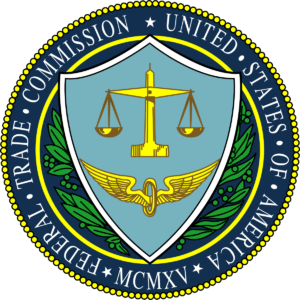 August 11, 2022 — The Federal Trade Commission has taken action against payment processing company First American Payment Systems and two of its sales affiliates for “trapping” small businesses with hidden terms, surprise exit fees, and zombie charges.
August 11, 2022 — The Federal Trade Commission has taken action against payment processing company First American Payment Systems and two of its sales affiliates for “trapping” small businesses with hidden terms, surprise exit fees, and zombie charges.
The FTC is alleging the defendants made false claims about fees and cost savings to lure merchants, many of whom had limited English proficiency.
Under a proposed federal court order, the defendants will be required to return $4.9 million to harmed businesses, stop their deception, and make it easier for merchants to cancel their services, the FTC said.
The company has issued a statement saying it “flatly denies” the FTC charges.
‘Harmful Practices’ Outlined
The FTC further stated First American is charged with engaging in a number of harmful practices against merchants:
- Deceiving businesses about pricing and savings with hidden terms. “The defendants pitched businesses with promises of small monthly fees, sometimes as low as zero, but the FTC’s complaint alleges that these claims were often false. The defendants also claimed that the businesses would save a lot of money over the course of a year by switching to defendants’ services but did not take into account the fact that First American periodically raises its prices for existing customers.”
- Imposing surprise fees when small businesses try to cancel. “The complaint alleges that defendants’ sales people regularly promise businesses they will be able to cancel services any time or within a trial period without a fee, when the company’s standard written agreement requires businesses to sign on to a three-year term with a $495 cancellation fee. In many instances, the business owners have limited English proficiency, and while the sales are conducted in their native language, the paperwork is only available in English.”
- Using an online enrollment system that obscures key contract terms. “The defendants’ online enrollment system for new customers hid a three-year obligation, cancellation requirements and fees, the fact that agreements would automatically renew, and other important information from business owners,” the complaint alleges. “These important facts often were in densely-packed documents that required business owners to click separate links to find.”
- Hitting small businesses with zombie charges after they withdraw consent accounts. “The complaint alleges that First American continued to make withdrawals from businesses’ bank accounts even after the businesses have withdrawn consent. For example, the complaint alleges that at times when a business acts to stop payments to the company from their bank, First American will attempt further withdrawals under different business names to evade stop payment orders.”
Enforcement Action Taken
The FTC said defendants in the case have agreed to a proposed federal court order that will require them to:
- Stop misleading consumers: The order will prohibit the defendants from misleading consumers about important contract terms like cancellation fees, while also prohibiting them making any unsubstantiated claims about their products or services, including specific pricing promises.
- Stop unauthorized bank withdrawals: The defendants will be prohibited from making withdrawals from any of their customers’ bank accounts without authorization, or after the customer has stopped any attempt to debit money from their account or communicated to the defendants that they refuse payment.
- Make cancellation easier: The defendants will be required to put a cancellation procedure in place that businesses can easily discover and use.
- Stop charging existing customers early termination fees: For consumers who signed electronic agreements with First American before April 6, 2020, the defendants will be prohibited from collecting any early termination fees or telling these customers that they will owe such fees if they cancel.
- Provide money to refund consumers: The defendants will be required to turn over $4.9 million to the FTC, which will be used to provide refunds to affected businesses.
Click here to read the entire article.
Federal Reserve Bank of New York: Survey Seeks Information from Lenders and Borrowers on Plans to Remediate U.S. Dollar (USD) LIBOR Loans Ahead of LIBOR Cessation
 August 9, 2022 — The Alternative Reference Rates Committee (ARRC) today released a survey seeking information on plans to remediate USD LIBOR loans. The survey is intended for both lenders and borrowers, asking about steps already under way and plans going forward to move to new rates or to update fallback language in USD LIBOR loans prior to June 30, 2023. The ARRC’s recent LIBOR Legacy Playbook has encouraged movement to new rates ahead of the LIBOR cessation, where feasible, and emphasized the operational challenges involved in attempting to transition a large number of contracts after the LIBOR cessation date. The survey is being issued to assist the ARRC and market participants in assessing LIBOR transition readiness and the need to address any potential operational issues involved.
August 9, 2022 — The Alternative Reference Rates Committee (ARRC) today released a survey seeking information on plans to remediate USD LIBOR loans. The survey is intended for both lenders and borrowers, asking about steps already under way and plans going forward to move to new rates or to update fallback language in USD LIBOR loans prior to June 30, 2023. The ARRC’s recent LIBOR Legacy Playbook has encouraged movement to new rates ahead of the LIBOR cessation, where feasible, and emphasized the operational challenges involved in attempting to transition a large number of contracts after the LIBOR cessation date. The survey is being issued to assist the ARRC and market participants in assessing LIBOR transition readiness and the need to address any potential operational issues involved.
“With less than a year left, the ARRC urges all market participants to ensure they are ready for LIBOR’s end. We’ve seen new loan activity convincingly move to SOFR this year, but there is a large number of legacy LIBOR loans that still need to be addressed. Understanding market participants’ plans to remediate these loans will be key to assessing how ready the loan market really is. We encourage all loan market participants to respond to the survey.” said Tom Wipf, ARRC Chair and Vice Chairman of Institutional Securities at Morgan Stanley.
The ARRC asks respondents to enter their responses into the spreadsheet, and to submit the spreadsheet by email to the ARRC Secretariat by September 7, 2022. As noted in the survey, individual firm responses will be maintained as confidential, and the survey results will be aggregated and anonymized prior to being published in order to preserve that confidentiality.
CFPB: New Risks Emerge as Line Between Payments and Commerce Blurs
Courtesy of Martin Kleinbard and Amy Zirkle, CFPB
 August 4, 2022 — Recent innovations across the payments ecosystem include the growing presence of Buy Now, Pay Later (BNPL) offerings, embedded commerce, and integrated “super apps.” Families, businesses, and the economy benefit when payments are fast and frictionless, and these emerging payment systems do make the user experience more “seamless” by integrating commerce and financial services. However, they also have the capacity to harvest user behavioral data to enhance their value propositions.
August 4, 2022 — Recent innovations across the payments ecosystem include the growing presence of Buy Now, Pay Later (BNPL) offerings, embedded commerce, and integrated “super apps.” Families, businesses, and the economy benefit when payments are fast and frictionless, and these emerging payment systems do make the user experience more “seamless” by integrating commerce and financial services. However, they also have the capacity to harvest user behavioral data to enhance their value propositions.
Related Reading:
Today, we issued a report, which explores the implications of this dynamic market and examines the development of new offerings that may blur the traditional lines of banking and commerce. We are focused on how large technology platforms and other emerging business models that operate outside of the traditional banking system use peoples’ sensitive spending and transaction data. We want to preserve the benefits of real-time payments, while still ensuring that the payments ecosystem in the United States is fair, transparent, and competitive.
We have witnessed the rise of super apps in markets outside the United States. For example, Alipay and WeChat Pay have become fixtures of daily life in China, supporting ecommerce, payments, other financial services, and chat functions. The resulting deep integration and synergies often mask how data is used, shared, and leveraged.
The value of user data collected in all three of the products surveyed in this report will only be enhanced as a cross section of Big Tech players, such as Apple and Google , leverage their dominance with respect to the systems and networks they control. Super apps, BNPL, and embedded commerce all allow for data to be kept within the confines of the tech platform and to deepen and secure consumer reliance on these products.
Today’s report continues the work we began when we issued our market monitoring orders to Big Tech companies and BNPL providers. These initiatives speak to our focus and commitment to consumer financial markets that work for all people. In the coming months, we plan to publish reports on the BNPL market and the implications of Big Tech’s movement into the payments space. Based in part on the findings that emerge in those reports, we will use our full range of tools to ensure that people are protected.
Articles for August 5, 2022 Issue:
CFTC Would Become Primary Crypto Regulator Under New Senate Committee Plan
US Lawmaker Calls for Apple and Google to Provide Info on Fake Crypto Apps
NY Regulator Fines Robinhood’s Crypto Arm $30 Million for Consumer Protection, Other Violations
Robinhood Seeks Fresh Following as Client Rosters, Revenue Plummet
Crypto Crackdown: SEC, Treasury Reportedly Investigate Exchanges
NCUA Updates This Week:
NCUA Workbook Update Results in Decline of LID Population
NCUA Charters WeDevelopment Federal Credit Union
CFTC Would Become Primary Crypto Regulator Under New Senate Committee Plan
Courtesy of Nikhilesh De, Coindesk.com
 The bill would create a definition of “digital commodity.”
The bill would create a definition of “digital commodity.”
August 3, 2022 — The Senate Agriculture Committee, which oversees the Commodity Futures Trading Commission, introduced a bipartisan bill Wednesday that would grant the CFTC “exclusive jurisdiction” over cryptocurrency trades that meet commodities law.
The Digital Commodities Consumer Protection Act of 2022, sponsored by Senators Debbie Stabenow (D-Mich.), John Boozman (R-Ark.), Cory Booker (D-N.J.) and John Thune (R-S.D.), would create a definition of “digital commodity” that would include cryptocurrencies like bitcoin and ether but not anything that may be a security, giving the CFTC the ability to oversee both digital commodity transactions and force registration of digital commodity platforms, according to a section-by-section breakdown of the bill.
The crypto industry has been pushing for either a federal agency or Congress to create a clear definition of “digital commodity” or a digital security, which could give companies greater clarity on when and how they must register with the CFTC or the Securities and Exchange Commission. The bill doesn’t provide that definition. The CFTC would have some ability to define digital commodities, and the bill appears to still defer to the SEC on what a security is.
The SEC, however, has moved slowly, and there is no formal rule-making in progress that would establish a registration requirement.
In the meantime, CFTC Chairman Rostin Behnam has waged a campaign to have his agency become the primary spot market regulator for the cryptocurrency markets, though Wednesday’s bill doesn’t go that far.
Still, Behnam appears to have some lawmaker support on this front. Rep. Sean Maloney (D-N.Y.), a member of the House Agriculture Committee, asked Chris Brummer, a professor at Georgetown Law, in June whether the CFTC should “have direct statutory authority to regulate cash markets.”
House Agriculture Committee Republicans have introduced the Digital Commodity Exchange Act, which would also grant the CFTC greater jurisdiction over crypto spot markets, though that too wouldn’t grant it exclusive oversight.
The Senate committee, which introduced the latest bill, called for the CFTC to provide more guidance on digital assets earlier this year.
Coin Center, an industry think tank, published a blog post supporting the bill, saying it would give the CFTC the authority to oversee spot markets rather than have the SEC oversee non-securities exchanges.
However, Peter Van Valkenburgh, director of research at Coin Center, cautioned that the current definition of “dealer” may be overly broad in the bill’s text.
US Lawmaker Calls for Apple And Google to Provide Info on Fake Crypto Apps
Courtesy of Turner Wright, CoinTelegraph

Apple/Google/JR Raphael
“Industry shouldn’t be allowed to write the rules that they want to play by,” said Senator Sherrod Brown in calling for U.S. lawmakers and regulators to address crypto scams.
Senator Sherrod Brown, chair of the Senate Banking Committee, has penned letters to the CEOs of Google’s parent company Alphabet and Apple calling for the tech firms to provide information on the ways they prevent certain apps from promoting crypto scams.
According to the letters published on Thursday, Brown asked Apple CEO Tim Cook and Alphabet CEO Sundar Pichai for the steps the tech giants were taking in the approval of crypto apps on Apple and Android devices. The senator requested information related to how the companies assessed if apps were “trusted and secure,” prevented possible phishing apps through fraudulent apps and reported such apps to users.
“Cyber criminals have stolen company logos, names, and other identifying information of crypto firms and then created fake mobile apps to trick unsuspecting investors into believing they are conducting business with a legitimate crypto firm,” said Brown. “While firms that offer crypto investment and other related services should take the necessary steps to prevent fraudulent activity, including warning investors about the uptick in scams, it is likewise imperative that app stores have the proper safeguards in place to prevent against fraudulent mobile application activity.”
Brown’s letters came following the Federal Bureau of Investigation issuing a public warning about fraudulent cryptocurrency apps on July 18. The bureau reported that scammers had pilfered more than $42 million from 244 people between October 2021 and May 2022, including a case in which an app used the name of a former legitimate crypto exchange.
Speaking at a Thursday hearing with the Senate Banking Committee on “Understanding Scams and Risks in Crypto and Securities Markets,” Brown seemed to place some of the burden of addressing crypto scams on platforms and apps on lawmakers and regulators rather than companies:
“We hear industry players call for rules of the road when a big fraud is uncovered, and after a big actor has knowingly violated the law. The rules are there, the roadmap is clear, and [the Senate Banking Committee] needs to make sure our regulators enforce the law and protect the workers and families that keep this economy rolling […] Industry shouldn’t be allowed to write the rules that they want to play by.”
Gerri Walsh, the president of the Financial Industry Regulatory Authority Investor Education Foundation, said in written testimony for the hearing that some of the $57 million in fines the financial regulator had charged trading app Robinhood in June 2021 would be used toward educating crypto investors, including those using online accounts or mobile apps. Walsh also pointed to scammers using dating and messaging apps to convince victims to send funds or invest in fraudulent crypto platforms and said misinformation on social media was a major factor in the propagation of such scams in response to a question on Instagram posts.
Related: 4 clever crypto scams to beware — Dubai OTC trader Amin Rad
The Federal Trade Commission reported in June that roughly 46,000 people in the United States had lost up to $1 billion in crypto to scams in 2021. The commission said at the time that roughly half of all the crypto-related scams originated from social media platforms through ads, posts and messages.
NY Regulator Fines Robinhood’s Crypto Arm $30 Million for Consumer Protection, Other Violations
Courtesy of Brian Rosenzweig, CNET
 August 2, 2022 — The fine is the latest in a series of lawsuits and alleged violations against the investing app.
August 2, 2022 — The fine is the latest in a series of lawsuits and alleged violations against the investing app.
Robinhood Crypto, the cryptocurrency trading unit of the popular investing app, was hit with a $30 million fine from the New York State Department of Financial Services for “significant” failures to comply with the state’s anti-money laundering, consumer protection and cybersecurity measures.
The department, which regulates financial services and products in the state, said in a press release Tuesday that Robinhood Crypto failed to adequately staff their bank secrecy act/anti-money laundering program, and that the program didn’t have enough resources to address the risks that consumers face using its services. The department also said the company’s cybersecurity program wasn’t in full compliance with state regulations.
On top of that, the Department of Financial Services said the company failed to offer “a distinct, dedicated phone number on its website” for receiving consumer complaints.
Related Reading:
Robinhood Seeks Fresh Following as Client Rosters, Revenue Plummet
Crypto Crackdown: SEC, Treasury Reportedly Investigate Exchanges
- This is the department’s first crypto enforcement action, according to The Wall Street Journal. Robinhood previously said it expected to pay the $30 million fine to the NYDFS last year after a 2020 investigation “focused primarily on anti-money laundering and cybersecurity-related issues” found the company to be in violation of several requirements.
- In addition to the $30 million fine, Robinhood will be required to retain an independent consultant to perform a comprehensive evaluation of Robinhood Crypto’s compliance and remediation efforts in regard to its violations.
- This isn’t the first time Robinhood has faced fines or legal action for allegedly misleading consumers. In June, the nonprofit Financial Industry Regulatory Authority hit Robinhood with a $70 million fine, its largest fine ever, for misleading consumers and failing to report customer complaints. In early 2021, Robinhood faced regulatory scrutiny after it restricted users’ ability to buy stock in GameStop, citing “market volatility.”
- Robinhood didn’t immediately respond to a request for comment.
- NCUA Updates This Week:
- NCUA Workbook Update Results in Decline of LID Population
- Courtesy of Moriah Taylor, CU Collaborate
 August 01, 2022 — Changes to the NCUA’s Low-Income Designated Area Workbook have led to a drop in the overall LID eligible population, with certain states and counties impacted more than others.
August 01, 2022 — Changes to the NCUA’s Low-Income Designated Area Workbook have led to a drop in the overall LID eligible population, with certain states and counties impacted more than others.- The NCUA recently released an updated version of its Low-Income Designated (LID) Area Workbook, used to determine which geographic areas are classified as low-income. The new workbook implements the most recent American Community Survey (ACS) data to provide a list of the counties, census tracts, census block groups, and zip codes that meet the threshold.
- The update moves from 2019 ACS data to 2020 ACS data, and brings with it a variety of changes.
- When considering the country as a whole, there has been a decrease in the number of individuals that qualify as low-income. Whereas with the last workbook approximately 188.25 million individuals (making up 57.39% of the total population) qualified as low-income, now 181.95 million individuals (55.17% of the total population) meet the criteria..
- An Outsized Impact on Certain States
- At the state level, there were only four (out of the 50 states plus District of Columbia and Puerto Rico) that saw an increase in their low-income population.

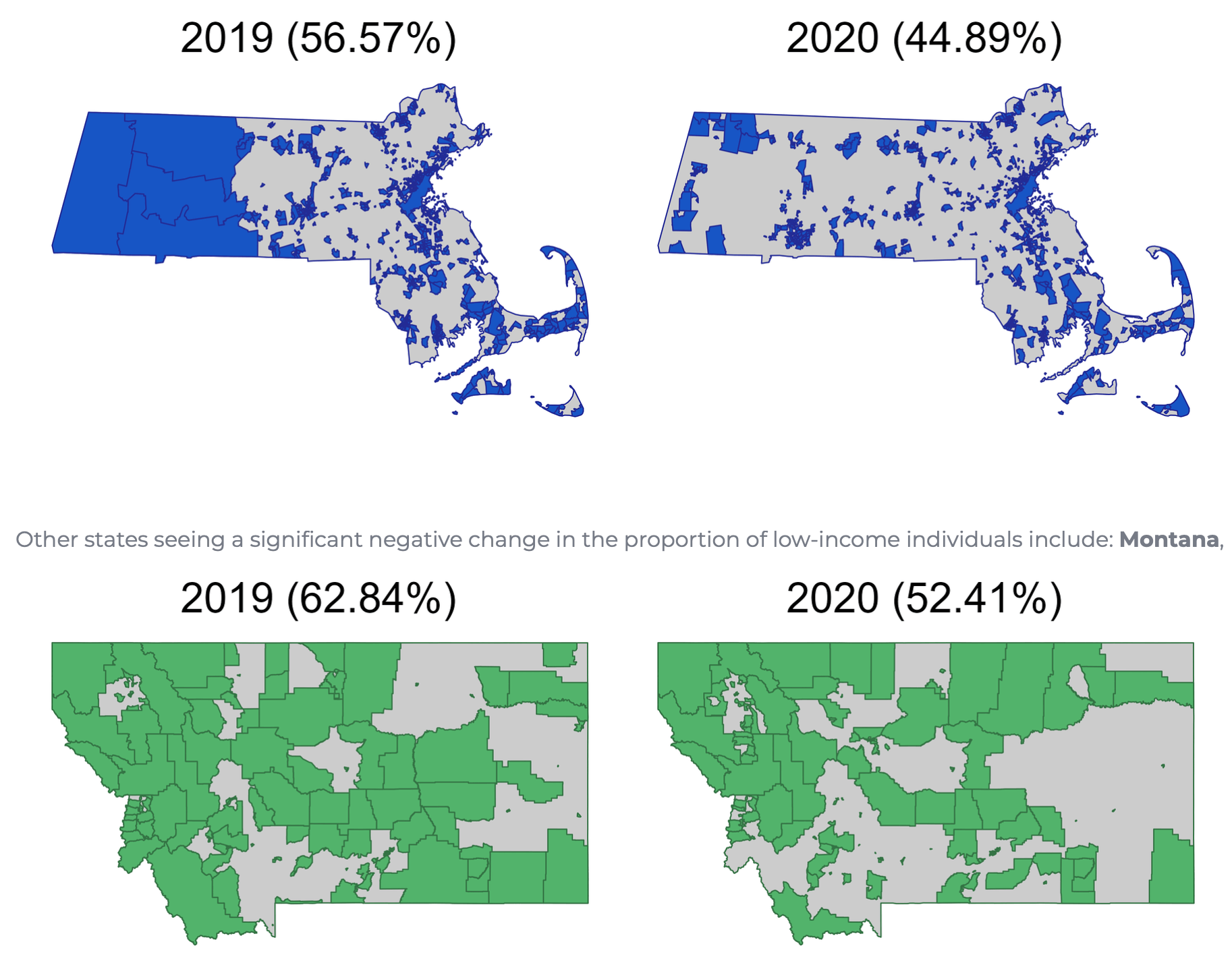
 Click here to read the entire article, as well as view more state-by-state changes and maps.
Click here to read the entire article, as well as view more state-by-state changes and maps. - NCUA: Agencies Invite Comment on Proposed Commercial Real Estate Loan Workouts and Accommodations Statement
 August 2, 2022 — The National Credit Union Administration, the Federal Deposit Insurance Corporation, and the Office of the Comptroller of the Currency, in consultation with state bank and credit union regulators, are inviting public comment on a proposed policy statement for prudent commercial real estate (CRE) loan accommodations and workouts.
August 2, 2022 — The National Credit Union Administration, the Federal Deposit Insurance Corporation, and the Office of the Comptroller of the Currency, in consultation with state bank and credit union regulators, are inviting public comment on a proposed policy statement for prudent commercial real estate (CRE) loan accommodations and workouts.- The proposed statement reaffirms the key principles from the October 30, 2009, statement that serves as a useful resource for both agency staff and financial institutions in understanding risk management and accounting practices for CRE loan workouts. The proposed statement addresses a financial institution’s handling of loan accommodations and workouts on matters like risk management, classification of loans, regulatory reporting, and accounting considerations. It includes updated references to supervisory guidance and updated loan workout examples.
- “The proposed policy statement will assist credit unions with managing risks associated with multi-family housing and other commercial real estate,” NCUA Chairman Todd M. Harper said. “It also provides credit unions with guidance on working constructively with CRE borrowers who are experiencing financial difficulty. I encourage credit union stakeholders to review and provide comments on the proposed policy statement.”
- The proposed statement additionally reflects changes in U.S. generally accepted accounting principles (GAAP) that have occurred since 2009. This includes eliminating the need for credit unions to identify and account for loan modifications as troubled debt restructurings (TDRs) after adopting the current expected credit losses (CECL) accounting methodology. It also emphasizes that federally insured credit unions (FICUs) with less than $10 million in assets are not required to comply with GAAP, unless the credit union is state-chartered and GAAP compliance is mandated by state law.
- NCUA Charters WeDevelopment Federal Credit Union
 August 4, 2022 — The National Credit Union Administration has granted a federal charter and Share Insurance Fund coverage to WeDevelopment Federal Credit Union in Kansas City, Missouri.
August 4, 2022 — The National Credit Union Administration has granted a federal charter and Share Insurance Fund coverage to WeDevelopment Federal Credit Union in Kansas City, Missouri.- “What the WeDevelopment organizers have accomplished is a clear reminder of the credit union system’s statutory mission of meeting the credit and savings needs of members, especially those of modest means,” NCUA Chairman Todd M. Harper said. “They will be serving a low-income membership to provide access to safe, fair, and affordable financial services. In doing so, WeDevelopment will help its members build more secure futures, and strengthen its community. I am pleased that the NCUA assisted this dedicated group in bringing their vision of financial stability and opportunity to reality.”
- WeDevelopment will serve a community with a poverty rate of approximately 30 percent. During its first year of operations, WeDevelopment plans to offer products and services that include:
- Regular shares
- Share drafts
- Business share drafts
- Certificates of deposit
- Individual retirement accounts
- New and used auto loans
- Signature loans
- Savings-secured loans
- Home improvement loans
- Wire transfers
- Debit/ATM access
- Online and mobile services
- Gift cards
- Cashier’s checks
- WeDevelopment’s charter became effective July 22, 2022, and the credit union expects to commence operations later this year.
- The new credit union will have a low-income designation and will serve people who live, work or regularly conduct business in, worship, attend school, participate in associations headquartered in, or participate in programs to alleviate poverty or distress in a specified area in Jackson County, Missouri. It will also serve businesses and other legal entities, incorporated and unincorporated organizations located in, or maintaining a facility located within that area.
- WeDevelopment is the first federal credit union chartered in 2022.
- Articles for July 29, 2022 Issue:
- Federal Privacy Legislation – Is it Finally Happening?
- Apple’s Move Into Buy Now Pay Later Space Triggers Alarm at CFPB
- The U.S. Economy is Shrinking. The Fed’s Rate Hikes May Have Only Just Begun to Bite
- SMBs Struggle to Balance Global Expansion with Local Compliance
- Federal Privacy Legislation – Is it Finally Happening?
- Authored by Bracewell LLP, JDSupra.com
 Proposed federal privacy legislation is not a new thing. But the latest iteration – the American Data Privacy and Protection Act – has many wondering if this will be the legislation that finally goes the distance. This is the first federal privacy legislation to advance out of committee, and despite the obstacles, momentum is on the upswing for a federal privacy law. Read on to find out more about the legislation and why the support may finally be there to enact a comprehensive federal privacy law.
Proposed federal privacy legislation is not a new thing. But the latest iteration – the American Data Privacy and Protection Act – has many wondering if this will be the legislation that finally goes the distance. This is the first federal privacy legislation to advance out of committee, and despite the obstacles, momentum is on the upswing for a federal privacy law. Read on to find out more about the legislation and why the support may finally be there to enact a comprehensive federal privacy law.- Setting the Stage
The American Data Privacy and Protection Act (the “Act”) is not the first privacy legislation introduced in the 117th Congress, in fact protections for consumer privacy, health privacy, financial privacy, cybersecurity, children’s privacy, and other protections have been introduced. But there are two elements that make this Act unique. First, it is the “bipartisan and bicameral effort to produce a comprehensive data privacy framework” as noted in the joint press release by the authors of the Act U.S. Senator Roger Wicker (R-MS) of the Senate Committee on Commerce, Science, and Transportation and U.S. Representatives Frank Pallone (D-NJ) and Cathy McMorris (R-WA), both members of the House Committee on Energy and Commerce. Indeed, the theme of compromise featured prominently during the July 20 House Committee on Energy and Commerce markup of the bill, the members focused repeatedly on the compromise nature of the bill as they discussed proposed amendments. The framework proposed by the Act builds on legislation that has come before, but in doing so reflects a thoughtful approach to development and a potential path to building broad support. - Second, the timing of the Act. We now have five states – California, Connecticut, Colorado, Utah, and Virginia – that have enacted a comprehensive privacy law. There is mounting concern from key stakeholders of the impact that this “patchwork” of laws will have on consumers and businesses. At the same time, without a federal privacy law the United States is being left out of the conversation at a global level as Europe and China seek to lead the world in defining the privacy protection framework.
- Key Elements of the Act
The framework for the Act, H.R. 8152, steers away from the consent framework while still including consumer rights, imposing duties on covered entities including privacy by design and corporate accountability. Other features of note: - Covered data does not include employee data.
- Data minimization is required
- “a covered entity may not collect, process or transfer covered data unless the collection, processing, or transfer is limited to what is reasonably necessary and proportionate to” achieve a purpose specified in the Act.
- The FTC, who ultimately would be granted enforcement authority, shall issue guidance regarding what is reasonably necessary and proportionate.
- While these elements may be of significant concern to those subject to the Act, the provisions likely to get the most discussion are the provisions related to preemption and private right of action.
- The proposed private right of action limits awards to compensatory damages, injunctive relief, and attorney’s fees. What complicates, or perhaps overly complicates, the private right of action is a requirement to notify the FTC and the respective State Attorney General of the intent to file the suit prior to doing so. The FTC and State Attorney General then have 60 days to determine “whether they will independently seek to intervene in such action.” Committee markups changed the effective date of the right begin two years from when the Act takes effect compared to the initial four, but to this point the right has been maintained.
- Regarding preemption, the story is different. The Act preempts state comprehensive data privacy laws, such as CPRA, but does not preempt the Illinois Biometric Information Privacy Act. Other examples of state laws that are not preempted include (i) breach notification requirements, including the personal information breach requirements under the CPRA; (ii) criminal laws for fraud, identity theft, or cyberstalking; (iii) financial and bank records; or (iv) health information. The Act does not preempt COPPA. An amendment to exempt the California Consumer Privacy Act and the California Privacy Rights Act failed, but it is likely this issue will be raised again.
 Read More Here.
Read More Here.- Apple’s Move Into Buy Now Pay Later Space Triggers Alarm at CFPB
- Courtesy of PYMTS.com
 Apple’s move into the buy now pay later (BNPL) space has the attention of Rohit Chopra, director of the Consumer Financial Protection Bureau (CFPB), who is now examining the larger implications of big tech companies becoming lenders.
Apple’s move into the buy now pay later (BNPL) space has the attention of Rohit Chopra, director of the Consumer Financial Protection Bureau (CFPB), who is now examining the larger implications of big tech companies becoming lenders.- The CFPB is taking a close look at the “implications of Big Tech entering this space” and is considering a number of issues, including whether Apple Pay Later could “reduce competition and innovation in the market,” Chopra said, Financial Times (FT) reported on Wednesday (July 27).
- Read more: Apple Says Now Is the Time for Pay Later
- See also: Is Apple Pay Later Really a Threat to Affirm and Other BNPL Providers?
- Apple Pay Later is one of about 80 BNPL products on the app shelf, including PayPal, Affirm, Afterpay and Klarna, PYMNTS reported in June. The number of BNPL products worldwide escalated since 2020, including several EU FinTechs offering installment billing in the U.S.
- The CFPB boss told FT that while his agency has concerns over tech entering the BNPL space, there is also unease over how Apple is using information collected in its buy later transactions and whether it’s being combined with browsing, geolocation, and health data.
- “Big Tech’s ambitions when it comes to ‘buy now, pay later’ are inextricably linked to the desire to dominate the digital wallet,” Chopra told FT.
- “Any tech giant that has a lot of control over a mobile operating system is going to have unique advantages to exploit data and eCommerce more broadly,” he said.
- The demand for BNPL took off during the pandemic and has not shown signs of abating. Apple’s product allows for four installment payments over six weeks, with no interest or fees, PYMNTS reported last month. Everything is processed through the digital wallet and the Mastercard network.
- Unlike other BNPL services that partner with financial institutions to underwrite the short-term loans, Apple is serving as the underwriter for its pay later product and funding the loans itself.
- “We’re glad to offer customers a choice which prioritizes their financial health and privacy with Apple Pay Later, and we look forward to working with the CFPB to answer any questions they may have,” an Apple spokesperson told FT.
- The CFPB will publish a report in the fall based on feedback requested of Afterpay, Affirm, Klarna, PayPal and Zip regarding transaction trends, fees, underwriting policies, and credit reporting, FT reported.
- The report will also include the CFPB’s “potential next steps from a regulatory perspective,” Chopra told FT.
 Read More Here.
Read More Here.- The U.S. Economy is Shrinking. The Fed’s Rate Hikes May Have Only Just Begun to Bite
- Courtesy of Ann Saphir and Lindsay Dunsmuir, Reuters
 The U.S. economy contracted for a second straight quarter, the Commerce Department reported on Thursday, a day after the Federal Reserve raised interest rates by three quarters of a percentage point to a range of 2.25%-2.50% in an effort to slow growth and ease price pressures.
The U.S. economy contracted for a second straight quarter, the Commerce Department reported on Thursday, a day after the Federal Reserve raised interest rates by three quarters of a percentage point to a range of 2.25%-2.50% in an effort to slow growth and ease price pressures.- The report likely won’t change Fed Chair Jerome Powell’s view that an economy that is adding hundreds of thousands of jobs a month is not in recession, and won’t deter him from raising borrowing costs further.
- But he and colleagues will be parsing it carefully for clues on where their policy tightening to bring down decades-high inflation is already having an effect, where it may yet begin to bite, and whether they are on track for the soft landing they aim for or the harder crash that analysts increasingly fear.
- “We do want to see demand running below potential for a sustained period to create slack and give inflation a chance to come down,” Powell said on Wednesday. “It’s also worth noting that these rate hikes have been large and they’ve come quickly, and it’s likely that their full effect has not been felt by the economy. So there’s probably some additional tightening – significant additional tightening in the pipeline.”
- The GDP adds to evidence that the aimed-for slowdown is already happening, although only part of that is due to the Fed. Here’s a partial breakdown:
- SLUMP IN HOUSING: FED RATE HIKES AT WORK
- Of all the categories in GDP, the interest-rate sensitive housing sector is where the effects of the Fed’s actions to tighten financial conditions are the most obvious. Even before the Fed began raising rates in March, mortgage rates began rising in anticipation, nearly doubling since late last year to nearly 6% and making already pricey houses even less affordable.
- The second quarter’s 14% decline in residential investment was the largest in 12 years aside from the stall in housing during the initial lockdowns to stem COVID-19 infections in the second quarter of 2020.
- It is unusual for this large of a housing subtraction from economic growth to occur outside of a recession.
- Other recent data shows homes sales are declining with sales of previously owned homes falling for a fifth straight month in June, and housing starts and building permits also declining further.
- And with the Fed still raising rates – perhaps another full percentage point this year, Powell suggested on Wednesday – the worst may still be to come.
- CONSUMER SPENDING SLOWING: SOME FED EFFECT BUT MORE TO COME
- Consumer spending, accounting for roughly two-thirds of the U.S. economy, slowed to a 1% annualized growth rate in the second quarter, from a 1.8% pace in the first, the report showed.
- The slowing growth was driven by a 4.4% drop in spending on goods, which had soared during the pandemic, and a look under the hood suggests that much of that was down to high inflation rather than a reaction to higher borrowing costs.
- For example, in nominal terms, consumers spent nearly $6 billion more on food for consumption at home than in the first quarter but took home less of it. Adjusted for inflation, food consumption fell $33.5 billion, resulting in food having its largest drag on the economy in nearly half a century.
- Meanwhile, spending on services rose 4.1%, the report showed, as people freed from pandemic restrictions spent on travel and restaurants. It’s not clear how long that will last though, said Rubeela Farooqi of High Frequency Economics.
- “The question really is… what is the staying power of service spending? The Fed is really hiking into a slowdown… (it’s) in a tough spot,” Farooqi said, noting households will soon begin to tap out their savings and take on more credit card debt to finance their lives.
 Read More Here.
Read More Here.- SMBs Struggle to Balance Global Expansion with Local Compliance
- Courtesy of PYMTS.com
- The payments landscape is constantly evolving.
 Companies must evolve — even scramble at times — to keep pace with changing rules and regulations that can vary wildly from market to market. After all, the firms that get caught off guard are the ones who wind up paying hefty fines for violations — even if they occur unwittingly.
Companies must evolve — even scramble at times — to keep pace with changing rules and regulations that can vary wildly from market to market. After all, the firms that get caught off guard are the ones who wind up paying hefty fines for violations — even if they occur unwittingly.- Executives are certainly aware of the challenges, as surveys have shown that roughly 80% of compliance officers expect to see an increase in regulatory demands in the coming year.
- Payments regulations are changing on multiple fronts, Dylan Lowrey, general counsel at Nium, told PYMNTS. The challenges confront all manner of firms that operate globally, including his company, which is licensed in 11 countries and is “passported” into the rest of Europe.
- That means operating in 40 countries that have their own considerations about, and ways they enable, payments and payments technologies. They also have their own regulations about consumer protections and data security.
- “You cannot take a one-size-fits-all approach to how you tackle all of this — you need to go country by country,” Lowrey said.
- Read more: The Perils Of ‘One-Size-Fits-All’ Authentication
- See also: Nium and FINCI Team to Boost International Payments
- That means “going local, market by market,” he explained. Companies and the platforms they operate on have to strike local relationships with local regulators to make sure that data localization laws are followed.
- There’s also the emerging question about how FinTechs, banks and established technology players will interact. An increasing level of scrutiny is being placed on FinTech, said Lowrey, and the platform model (through providers such as Nium) can help stakeholders navigate these regulatory complexities.
- “Businesses shouldn’t worry about how to solve for making or receiving payments in a certain country,” Lowrey said. “These are things they can solve for by using the right platform — and the platforms can abstract away from that complexity.”
- Getting those solutions from the platform means that companies — especially resource-constrained smaller players — don’t have to grapple with shifting regulations and can instead focus on their strategic, go-to-market goals.
- “The costs are defrayed,” he said, “and the speed to market and increasing their global reach are all improved.”
- Biometrics Tackle Fraud
- Moving into the technologies that help improve security, Lowrey pointed to biometrics as a means to improve authentication. He cautioned that there are no isolated technologies that will stop data breaches, but the continued embrace of device-level protection is an important line of defense against bad actors.
- Europe, he said, has been the proverbial high-water mark for payments and data security. In the U.K., he added — despite political turmoil — there has been a record of “consistency and predictability” as regulators, including the Financial Conduct Authority, have firmly addressed data and payments security.
- Looking ahead, he said that as compliance officers continue to tackle changes in the compliance landscape, technology will evolve, too, in a bid to reduce friction and improve the payments experience.
- “There’s a lot of change coming on the horizon,” he told PYMNTS.
 Read More Here.
Read More Here.- Articles for July 22, 2022 Issue:
- House Version of NDAA Gives NCUA Third-Party Oversight Authority
- CFPB: Banks’ Overdraft/NSF Fee Revenues Evolve Along with Their Policies
- CFPB to Push Banks to Cover More Payment-Services Scams
- Schumer’s Legal Cannabis Bill Is Finally Here — the Long-awaited Legislation Was Introduced But Faces an Uphill Battle
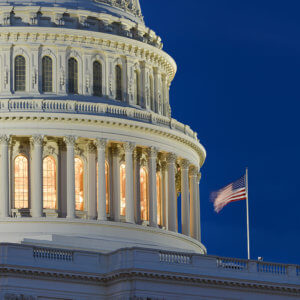 House Version of NDAA Gives NCUA Third-Party Oversight Authority
House Version of NDAA Gives NCUA Third-Party Oversight Authority- Courtesy of CUToday.info
- July 18, 2022 — While the credit union trade associations have hailed House passage of the National Defense Authorization Act (NDAA) because it includes amendments backed by CUs, getting less attention with last week’s passage is the fact the bill would also give NCUA oversight of third-party vendors.
- And that’s something CUNA, NAFCU, the National Association of CUSOs and others within credit unions have strongly opposed, even as the agency has sought the authority for years. As CUToday.info was first to report in May, a discussion draft of legislation that would provide NCUA with third-party oversight authority was circulated in the House of Representatives.
- Such oversight has been a long-time priority of numerous members of the NCUA board, including its current three members. The agency argues other regulators have the authority and that the inability to oversee the many vendors, including CUSOs, to credit unions creates numerous vulnerabilities, most especially in data security. The CU trade groups have argued NCUA already has all the oversight authority it needs, including over vendors.
- Muted Opposition
- However, one source told CUToday.info that the trade group opposition may have muted somewhat on the issue as the result of growing risks around cyber-breaches. The discussion draft previously circulated under the title “The NCUA Oversight of Third Party Vendors Act,” and would authorize section 206A of the Federal Credit Union Act to provide the oversight authority it is seeking.
- As a number of credit union advocates on Capitol Hill have been saying, including at the time the discussion draft was circulated, such standalone bills to pass would need to be attached to larger pieces of must-pass legislation or spending bills, such as the NDAA.
- That is also the case for the several pieces of legislation that were attached as amendments and which have strong credit union support: the Secure and Fair Enforcement (SAFE) Banking Act, which would remove federal prohibitions on serving cannabis businesses; an extension of CARES Act Central Liquidity Facility (CLF) flexibility, and provisions to support fair hiring in financial services.
- ‘Regulatory Blind Spot’
- As CUToday.info reported here in early May, in response to questions from Sen. Pat Toomey (R-PA), NCUA Chairman Todd Harper wrote, “Most credit unions rely on vendors to conduct important parts of their operations. Yet, as credit unions respond to COVID-19 issues, they have little time to address problems that may arise with those vendors. Many also lack the resources required to fully conduct due diligence when adding new vendors to address COVID-19 needs.
- “At present, the NCUA lacks the authority to supervise or oversee credit union third-party vendors, even though the Government Accountability Office and Financial Stability Oversight Council have long urged Congress to close this regulatory blind spot,” Harper continued. “I respectfully request that you provide the NCUA with this oversight authority now. In making this change, the NCUA would achieve parity with the federal banking agencies, which already have vendor oversight authority.”
- Banks and industry groups are expected to fight an expanded interpretation of their legal obligations. Firms may be forced to cut services or impose new fees to cover added costs for platforms like Zelle, industry officials say. Others warn steps to rein in scams could backfire by opening the door for more fraud.
-
 CFPB: Banks’ Overdraft/NSF Fee Revenues Evolve Along with Their Policies
CFPB: Banks’ Overdraft/NSF Fee Revenues Evolve Along with Their PoliciesIn this blog post, we examine the evolution of banks’ reliance on overdraft and NSF fees since the publication of our report “Overdraft/NSF Fee Reliance Since 2015 – Evidence from Bank Call Reports” last December. To do so, we rely on additional data from the call report from the last three available quarters – the third quarter of 2021 through the first quarter of 2022. These quarters represented important times for the overdraft market since – as we reviewed in our blog Comparing overdraft fees and policies across banks – several banks have announced changes to their overdraft programs in late 2021 and early 2022. Some banks announced significant changes while others made smaller or no changes. It is an open question how these program changes, once implemented, translate into changes in overdraft/NSF fee revenues. The examination of this question is further complicated by the fact that some of the pandemic-era declines in overdraft/NSF fee revenues may be reversed as the economy and checking account balances return to a more usual course.
In our Dec 2021 report, we documented a 26.2 percent decline in overdraft/NSF fee revenues between 2019 and 2020, some of which was likely due to pandemic-era increases in average checking account balances. Here we find that overdraft/NSF fee revenues continued to be depressed in 2021 and stayed below their 2019 volume by 27.4 percent. In the first quarter of 2022, overdraft/NSF fee revenues stopped their decline and reversed somewhat and were 20.1 percent below their corresponding 2019 levels.
When comparing changes across banks and across 2021 and the first quarter of 2022 for individual banks, however, important differences emerge across banks and groups of banks which may, at least in part, reflect changes in overdraft programs that some banks have instituted.1 First, some large banks, namely PNC and JPMorgan Chase, have seen significantly larger declines in overdraft/NSF fee revenues than other banks in 2021, which may reflect an effect of their overdraft program changes. Second, some banks experienced less reversal in overdraft/NSF fee revenues than the market overall in early 2022, which may be evidence of changing overdraft policies at these institutions. Third, some banks – and especially those that have seen the largest decline in overdraft/NSF fee revenue – experienced an increase in revenues from other listed fees (i.e., maintenance and ATM fees), but these have been too small to offset the loss of revenues from overdraft/NSF fees.
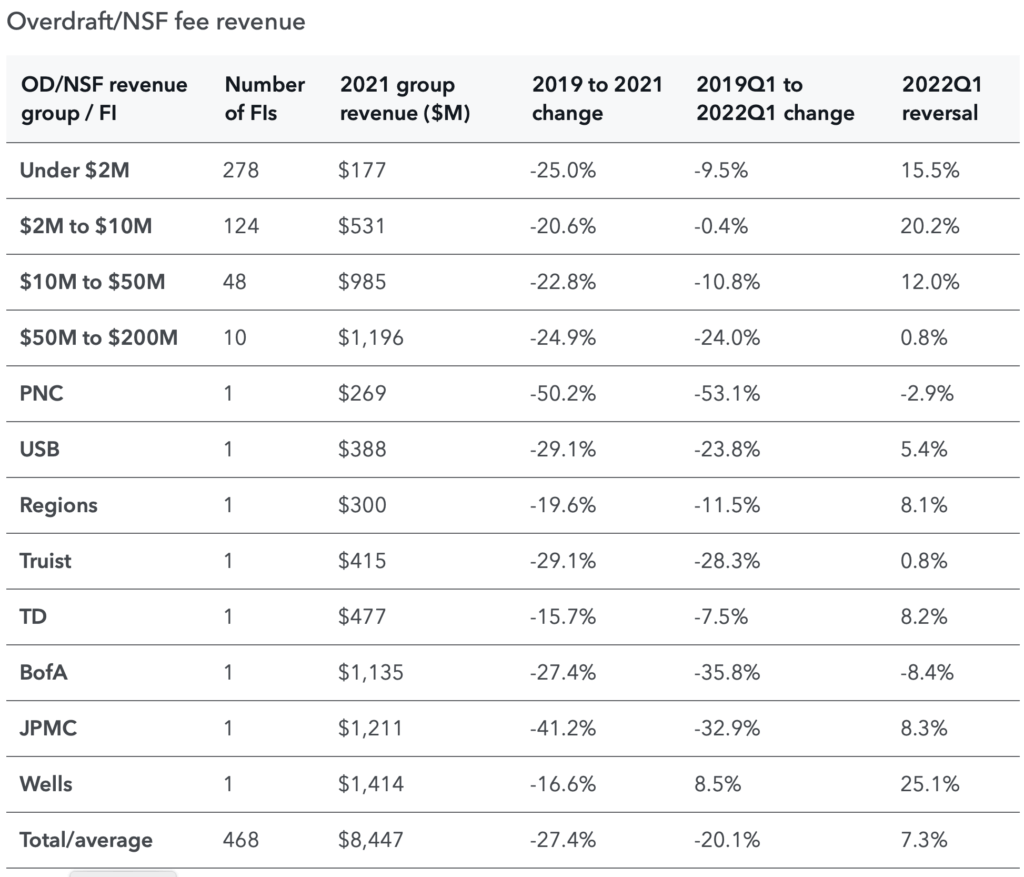
Table 1: Change in Overdraft/NSF fee revenue from pre-pandemic baseline in 2021 and First quarter of 2022 by Groups of Banks and select individual banks
In Table 1 we report changes in overdraft/NSF revenues for small and midsize banks grouped by the amount of overdraft/NSF fees collected and individually for the eight banks collecting more than $200 million in such revenues in 2021.2, 3 The first column reports the number of banks in each group while the second shows the total amount of overdraft/NSF revenues collected in 2021 by the group. The 2021 and first quarter 2022 changes reported in the third and fourth columns are defined in relation to the respective pre-pandemic periods in 2019 to control for seasonality (i.e., year of 2019 and first quarter of 2019).
According to figures shown in the third column, in 2021 small and midsized banks collected 20 to 25 percent less in overdraft/NSF revenues than in 2019. As noted in our December 2021 report, one factor contributing to this decline in overdraft/NSF revenues was the increase in consumer deposits, which was sustained through the first quarter of 2022 according to call report data.
Some large banks have seen notably larger declines than the small to midsize banks, namely PNC and JPMorgan Chase at 50.2 and 41.2 percent, respectively. While this evidence is indirect and does not control for changes in the number, composition, or behavior of accountholders, these declines in fee revenue may reflect changes in overdraft programs. It is also notable that some large banks, notably TD and Wells Fargo, have seen significantly smaller declines in overdraft/NSF revenues than the small banks. Again, it is not possible to disentangle whether this smaller decline is due to changes in the number, composition, or behavior of accountholders or changes or lack of changes in overdraft programs.
Looking at the changes in the first quarter of 2022 provides further indirect evidence on trends in the market. In the last column of Table 1 we report each group’s “reversal,” which is defined as the difference between the change in the first quarter of 2022 and the change in 2021 and thus reflects the extent to which the 2021 decline in overdraft revenue has reversed in early 2022.
- CFPB to Push Banks to Cover More Payment-Services Scams
- Agency reports uptick of complaints; banks warn changes could hurt economy.
- Courtesy of Andrew Ackerman, Wall Street Journal
 The Consumer Financial Protection Bureau is preparing to prod banks to pay back more customers who are the victims of alleged scams on Zelle and other money-transfer services, according to people familiar with the coming regulatory effort.
The Consumer Financial Protection Bureau is preparing to prod banks to pay back more customers who are the victims of alleged scams on Zelle and other money-transfer services, according to people familiar with the coming regulatory effort.- Under new guidance the bureau is preparing to release in the coming weeks, banks could face heightened requirements around certain scams that have become more prevalent on these platforms, these people said, such as when a customer is tricked into sending money to a scammer pretending to be a representative of his or her bank.
-
The coming guidance hasn’t been completed and could change. It appears aimed primarily at a spate of complaints related to Zelle but would likely apply to any other payments service that connects directly to a consumer’s bank account, such as Venmo.
Money-transfer services boomed during the pandemic, when people avoided ATMs and replaced cash and checks with digital money transfers. Zelle recorded some 1.8 billion transactions in 2021 totaling $490 billion, double their prepandemic levels.
 You Accidentally Sent $149 to a Stranger on Venmo? Good Luck Getting It Back
You Accidentally Sent $149 to a Stranger on Venmo? Good Luck Getting It Back
The money transfer app makes it easy to send money to a friend—or to someone else with a similar name. ‘Swindler, return my money’
Courtesy of Telis Demos, Wall Street Journal
While checks can take days to process, money-transfer platforms such as Zelle and PayPal Holdings Inc.’s Venmo allow people to send or receive money almost instantaneously. The transfers are typically free but reversing them is usually impossible.
Growth in these platforms’ usage has fueled an increase in reported scams, leading consumer advocates and Democratic lawmakers to complain that banks aren’t doing enough to help customers duped into making fraudulent payments.
At the heart of the issue is how much banks should be liable for repaying customers who authorize the platforms to move around their money, only to later learn they were defrauded. Seven large banks own Early Warning Services LLC, the company that operates Zelle, and around 1,700 financial institutions offer Zelle to their customers.
Early Warning Services said protecting consumers is a priority for Zelle and the firms that offer it.
“As a network, we are constantly adapting consumer protection measures to address the dynamic and evolving threat of fraud,” it said in a statement. “In addition to our efforts, we encourage measures that reduce the ability of fraudsters to perpetrate these scams and arm consumers with educational resources that will help them protect themselves from fraudsters.”
- Schumer’s Legal Cannabis Bill Is Finally Here — the Long-awaited Legislation Was Introduced But Faces an Uphill Battle
- Courtesy of By Natalie Fertig, Politico
 Senate leaders are introducing sweeping legislation Thursday meant to lift federal prohibitions on marijuana more than 50 years after Congress made the drug illegal.
Senate leaders are introducing sweeping legislation Thursday meant to lift federal prohibitions on marijuana more than 50 years after Congress made the drug illegal.- Senate Majority Leader Chuck Schumer’s Cannabis Administration and Opportunity Act would decriminalize weed on the federal level and allow states to set their own marijuana laws without fear of punishment from Washington.
- The bill has been a long time coming — Schumer, along with Sens. Ron Wyden (D-Ore.) and Cory Booker (D-N.J.) proposed a discussion draft more than a year ago — and its odds of passing in this Senate are slim. But the legislation will shape the conversation around cannabis legalization going forward and portions of it are likely to find their way into other bills that could pass before the end of the year.
- The legislation includes both Democratic and Republican priorities: It expunges federal cannabis-related records and creates funding for law enforcement departments to fight illegal cannabis cultivation. It also establishes grant programs for small business owners entering the industry who are from communities disproportionately hurt by past drug laws, requires the Department of Transportation to research and develop a nationwide standard for marijuana-impaired driving, and restricts the marketing of cannabis to minors.
- Schumer has been the highest-ranking champion of marijuana legalization in Washington, labeling it a top priority over the last two years. It was one of the issues he said Democrats would tackle if they took back the Senate in 2020.
- “When a state like South Dakota votes by referendum to legalize, you know something is out there,” Schumer told POLITICO last year. “The American people started speaking sort of with a clear message. More than two-to-one, that they want the law changed.”
- While marijuana legalization has spread rapidly across the U.S. over the past decade, Capitol Hill has not transitioned as quickly. Nineteen states now allow anyone at least 21 years old to possess and use the drug, and 37 states have established medical marijuana programs. National polls have consistently shown that roughly two-thirds of Americans back marijuana legalization, and support is even higher among younger voters.
- But the votes aren’t yet there to pass Schumer’s bill on Capitol Hill.
- That’s in part because many lawmakers from states with legal markets don’t yet support substantial changes to federal law. Democratic Sen. Jon Tester, for example, represents a state where weed is legal — Montana — and says he does not support federal decriminalization. A handful of other Democrats told POLITICO that they are against legalization or are undecided, including Sens. Jeanne Shaheen (D-N.H.), Joe Manchin (D-W.Va.) and Bob Casey (D-Pa.). Schumer would need all Democrats, plus ten Republicans, to get the bill over the finish line.
- Articles for July 15, 2022 Issue:
- CFPB Sues ACE Cash Express for Concealing No-Cost Repayment Plans and Improperly Withdrawing Consumers’ Funds
- Vermont Department of Financial Regulation Encourages Celsius Network Investors To Proceed With Caution
- CFPB: Promoting Competition in Our Financial Markets
- Treasury Releases Request for Comment on Risks and Opportunities and Presented by Digital AssetsTreasury Releases Request for Comment on Risks and Opportunities and Presented by Digital Assets
 CFPB Sues ACE Cash Express for Concealing No-Cost Repayment Plans and Improperly Withdrawing Consumers’ Funds
CFPB Sues ACE Cash Express for Concealing No-Cost Repayment Plans and Improperly Withdrawing Consumers’ Funds- Repeat offender kept borrowers in debt and in the dark, generating at least $240 million in reborrowing fees.
- July 12, 2022 — The Consumer Financial Protection Bureau (CFPB) filed a lawsuit today accusing payday lender ACE Cash Express of concealing free repayment plans from struggling borrowers. Because of ACE’s illegal practices, individual borrowers paid hundreds or thousands of dollars in reborrowing fees, when they were in fact eligible for free repayment plans. These practices generated at least $240 million in fees for ACE, while keeping borrowers in debt. The CFPB also alleges that ACE lied to borrowers about the number of times it would attempt to debit their bank accounts for repayment of loans and fees. In a 2014 CFPB enforcement action, ACE paid $10 million in penalties and borrower refunds for using illegal debt-collection tactics, and the company is still bound by the order from that case.
-
“Deception and misdirection allowed ACE Cash Express to pocket hundreds of millions of dollars in reborrowing fees,” said CFPB Director Rohit Chopra. “Today’s lawsuit is another example of the CFPB’s focus on holding repeat offenders accountable.”
- ACE Cash Express is a financial services company headquartered in Irving, Texas. In 2019, ACE changed its corporate name to Populus Financial Group Inc., while continuing to carry the ACE Cash Express brand as one of the group’s core financial service offerings. The company offers a variety of financial products, including high-cost, small-dollar payday and title loans, along with bill payment, check-cashing, and prepaid debit-card services. The small-dollar lending products are typically structured to be short-term, single-payment loans with triple-digit annualized interest rates. ACE primarily serves low-income consumers, and its borrowers frequently refinance, rollover, or otherwise extend their loans beyond the original repayment term. ACE has approximately 979 stores in 22 states and the District of Columbia. Since 2006, ACE has been owned by JLL Partners, a private equity firm.
- Related reading: Federal Regulators Fine Bank of America $225 Million Over Botched Disbursement of State Unemployment Benefits at Height of Pandemic
- ACE is also a repeat offender of consumer financial protection laws. In 2014, the CFPB found that ACE used illegal debt-collection tactics to create a false sense of urgency to lure overdue borrowers into repeat borrowing. ACE would encourage overdue borrowers to temporarily pay off their loans and then quickly re-borrow from the company. Even after borrowers explained to ACE that they could not afford to repay their loans, the company would continue to pressure them into taking on more debt. Borrowers would pay new fees each time they took out another payday loan from ACE.
- The CFPB alleges that since July 10, 2014, ACE has received more than $240 million in fees from hundreds of thousands of customers who were eligible for a free repayment plan. And, since January 2016, it has made at least 3,000 unauthorized debit-card withdrawals, which resulted in at least $1.3 million being illegally debited from at least 3,000 borrowers. As alleged in the complaint, ACE specifically harmed consumers by:
- Concealing free repayment-plan options and funneling borrowers into costly reborrowing: In numerous instances, since at least 2014, ACE represented to borrowers who had expressed an inability to repay their current ACE loans that the only options available to them were a short grace period or fee-based refinancing. ACE used misleading language and waterfall scripts to dupe borrowers into refinancing loans. Many borrowers did not know free repayment plans existed, did not know they would not have to pay any additional fees for free repayment plans, and did not know that enrolling in free repayment plans would possibly relieve them of having to make a payment before a loan’s regularly scheduled due date.
- Withdrawing money from borrowers’ bank accounts in violation of contracts: In many states, borrowers signed contracts allowing ACE to make three attempts to withdraw repayment funds from borrowers’ bank accounts. However, for thousands of borrowers, ACE withdrew money through a fourth withdrawal. ACE’s actions caused affected borrowers to lose funds and potentially the ability to pay other bills.
- Vermont Department of Financial Regulation Encourages Celsius Network Investors To Proceed With Caution
-
 July 12, 2022 — Celsius Network is a cryptocurrency company, unlicensed in Vermont, that offered its customers interest-bearing cryptocurrency accounts. Celsius promised customers high interest rates (up to 17%) on deposits of cryptocurrencies. On June 12, 2022, Celsius announced that it was pausing all withdrawals, swaps, and transfers between customer accounts. This action impacts hundreds of thousands of customers and billions of dollars of cryptocurrencies, including accounts of some Vermonters.
July 12, 2022 — Celsius Network is a cryptocurrency company, unlicensed in Vermont, that offered its customers interest-bearing cryptocurrency accounts. Celsius promised customers high interest rates (up to 17%) on deposits of cryptocurrencies. On June 12, 2022, Celsius announced that it was pausing all withdrawals, swaps, and transfers between customer accounts. This action impacts hundreds of thousands of customers and billions of dollars of cryptocurrencies, including accounts of some Vermonters.The Department believes Celsius is deeply insolvent and lacks the assets and liquidity to honor its obligations to account holders and other creditors. Celsius deployed customer assets in a variety of risky and illiquid investments, trading, and lending activities. Celsius compounded these risks by using customer assets as collateral for additional borrowing to pursue leveraged investment strategies. Additionally, some of the assets held by Celsius are illiquid, meaning they may be difficult to sell, and a sale may result in financial losses. The company’s assets and investments are probably inadequate to cover its outstanding obligations.
-
 From Reuters: “State securities regulators in Alabama, Kentucky, New Jersey, Texas, and Washington are investigating Celsius’s decision to suspend customer redemptions.” read more
From Reuters: “State securities regulators in Alabama, Kentucky, New Jersey, Texas, and Washington are investigating Celsius’s decision to suspend customer redemptions.” read moreRelated reading:
- Celsius Network Files for Chapter 11 Bankruptcy
- Global Regulators Back ‘Same Risk, Same Regulation’ For Stablecoins
- Crypto Needs Regulation — Technology Can’t Remove All Financial Risks, BOE’s Cunliffe Says
Recent volatility in cryptocurrency markets
Cryptocurrencies are a new and often volatile type of investment product. In the best of times, cryptocurrencies are generally highly speculative and risky investments. Significant fluctuations in value are possible due to general market conditions, market manipulation, and the nature of the tokens themselves. Since early 2022, however, and particularly since May 2022, the value of most types of cryptocurrencies has plummeted. Coins or tokens held as deposits in financial services company Celsius Network are no exception. But in addition to the ordinary risks of cryptocurrency investing, holders of Celsius interest accounts were also exposed to credit risk that Celsius would not be able to return their tokens upon withdrawal.
Celsius is very likely insolvent
Celsius Network has been operating in multiple jurisdictions, including in Vermont. The Department believes Celsius has been engaged in an unregistered securities offering by offering cryptocurrency interest accounts to retail investors. Celsius also lacks a money transmitter license. This means that until recently, Celsius was operating largely without regulatory oversight.
Due to its failure to register its interest accounts as securities, Celsius customers did not receive critical disclosures about its financial condition, investing activities, risk factors, and ability to repay its obligations to depositors and other creditors.
The Department has joined a multistate investigation of Celsius arising from the above concerns.
Previous representations made by the Company, its CEO, and other Celsius representatives about the safety of customer funds and the company’s ability to meet withdrawal obligations are untrue.
The Department is aware of reports that Celsius has consulted with insolvency counsel and is considering a bankruptcy filing. If you are a Celsius customer, a bankruptcy filing could affect your investor rights and the value of your Celsius interest account balances. You should consult your own counsel if you have questions about your individual situation and how a bankruptcy proceeding could affect your investment in Celsius.
Market Rumors and Scams
Celsius customers may receive communications or read information on the internet suggesting that they place their deposit accounts on “HODL mode” as a show of support for Celsius. As of June 12, 2022, Celsius has frozen investor accounts. As a result, there is no benefit either to customers or to Celsius to placing deposit accounts into “HODL mode.” It is also highly unlikely that placing accounts into “HODL mode” will have any effect on the value of cryptocurrency assets held in such accounts or the value of Celsius assets and investments. The freezing of the accounts does not prevent further declines in value.
 Read more of the Vermont DFR’s press release here.
Read more of the Vermont DFR’s press release here.- CFPB: Promoting Competition in Our Financial Markets
- By Rohit Chopra
 July 11, 2022 — A year ago, the President issued an executive order to launch a whole-of-government effort to promote competition in the American economy. When families and businesses face limited choices, they can encounter higher prices and worse customer service.
July 11, 2022 — A year ago, the President issued an executive order to launch a whole-of-government effort to promote competition in the American economy. When families and businesses face limited choices, they can encounter higher prices and worse customer service.- Congress has charged the CFPB with ensuring that markets for consumer financial products are competitive, so the CFPB is participating in this whole-of-government effort, along with other independent agencies. Over the last year, the CFPB has taken a number of steps to promote competition in our markets.
- First, the CFPB is working to identify the obstacles for consumers to refinance or switch providers more easily. For example, we have asked the nation’s largest credit card issuers about a change that occurred across the industry that is undermining the ability for consumers to get lower-rate offers from competitors. We are also identifying impediments to refinancing in other markets, including mortgages and auto. The CFPB is also accelerating its work to implement a required rulemaking on personal financial data rights, which we hope will spur competition and switching by giving consumers more control of their data.
- Second, we have launched an initiative to save families billions of dollars in junk fees. These back-end fees undermine fair competition by obscuring the all-in cost of a product or service. Tens of thousands of Americans have submitted feedback on this work, and many financial institutions are responding by cutting or eliminating fees altogether, including billions of dollars in overdraft and NSF fees. We issued a legal interpretation affirming that federal law often prohibits debt collectors from charging “pay-to-pay” fees, which will help to ensure law-abiding debt collectors aren’t disadvantaged by those that impose unlawful fees. We have also started a rulemaking process to address credit card late fees that cost Americans $12 billion in 2020 alone.
- Third, the CFPB is looking to identify the roadblocks that small financial institutions and new entrants face when challenging dominant players. With the arrival of Big Tech into payments and banking, we have ordered many of these giants to turn over information about their practices and plans on their payment systems. The information will help the CFPB shed light on how they will decide who they kick off their platform and how they will use the data of individual consumers and any competing businesses. In addition, we are working with community banks to understand the impacts of the highly concentrated core service provider market. These platforms can limit flexibility and raise costs for many small financial institutions seeking to fairly compete.
 Read more here.
Read more here. Treasury Releases Request for Comment on Risks and Opportunities and Presented by Digital Assets
Treasury Releases Request for Comment on Risks and Opportunities and Presented by Digital Assets- July 12, 2022 — The U.S. Department of the Treasury released a notice seeking public comment regarding potential opportunities and risks presented by developments and adoption of digital assets as part of its work under Section 5 of President Joe Biden’s digital assets Executive Order. Section 5 of Executive Order 14067, “Ensuring Responsible Development of Digital Assets,” directs Treasury, in consultation with the Secretary of Labor and other relevant agencies, to report to the President on the implications of development and adoption of digital assets and changes in financial market and payment infrastructures for United States consumers, investors, businesses.
- “For consumers, digital assets may present potential benefits, such as faster payments, as well as potential risks, including risks related to frauds and scams.” Under Secretary of the Treasury for Domestic Finance Nellie Liang said. “The Treasury Department is seeking to benefit from the expertise of the American people and market participants by soliciting public comment as we engage in this important work.”
- Through this request for comment (RFC), Treasury is requesting input from the public that will inform its work in carrying out its mandate under section 5(b)(i) of the Executive Order. This RFC offers an opportunity for all interested parties to provide relevant input, data, and recommendations pertaining to the implications of developments and adoption of digital assets and changes in financial market and payment infrastructures for U.S. consumers, investors and businesses.
- Members of the public are encouraged to submit comments, and comments that respond to the notice will be available on www.regulations.gov.
- Related reading: Treasury Fact Sheet: Framework for International Engagement on Digital Assets
- A copy of the notice is available at Federal Register :: Ensuring Responsible Development of Digital Assets; Request for Comment.
- Articles for July 8, 2022 Issue:
- Fed, FinCEN, OCC Urge Banks to Improve Customer Due Diligence, Avoid De-Risking
- Related Reading: NCUA’s Letter to Credit Unions
- Member Benefit: NASCUS Summary of This Statement
- Cryptoassets and Sanctions: How Easy is it to Freeze Cryptoassets?
- CFPB: Accepting Applications For Advisory Committees
- CFPB Issues Advisory to Protect Privacy When Companies Compile Personal Data
 Fed, FinCEN, OCC Urge Banks to Improve Customer Due Diligence, Avoid De-Risking
Fed, FinCEN, OCC Urge Banks to Improve Customer Due Diligence, Avoid De-Risking - Courtesy of PYMTS.com
- July 7, 2022 — The Board of Governors of the Federal Reserve System, the Federal Deposit Insurance Corporation, the Financial Crimes Enforcement Network (FinCEN), the National Credit Union Administration, and the Office of the Comptroller of the Currency (the agencies), on Wednesday, July 6, issued a joint statement urging banks to properly assess customer relationships and conduct customer due diligence (CDD) to ensure that customers engaged in lawful activities have access to financial services. In other words, to avoid de-risking practices.
- De-risking is a business practice where financial institutions decide to terminate or restrict business relationships with clients to avoid, rather than manage, money-laundering or terrorism financing risks.
- While the statement does not alter existing Bank Secrecy Act/Anti-Money Laundering (BSA/AML) legal or regulatory requirements, the agencies sent a clear message encouraging banks to manage customer relationships and mitigate risks rather than decline to provide banking services to entire categories of customers.
- The agencies reminded banks that they must apply a risk-based approach to CDD, including when developing the risk profiles of their customers. “The CDD process should enable banks to understand the nature and purpose of customer relationships for the purpose of developing a customer profile risk and conduct ongoing monitoring to identify and report suspicious transactions,” reads the statement.
- Related Reading: NCUA’s Letter to Credit Unions: Risk-Based Approach to Assessing Customer Relationships and Conducting Customer Due Diligence
- Member Benefit: NASCUS’s Summary on This Statement (login required)
- But where the agencies put more emphasis is on the need to conduct the analysis on an individual basis, and that “not all customers of a particular type automatically represent a uniformly higher risk of money laundering, or illicit financial activity.” The agencies do not mention which type of customer may be most affected by de-risking practices from banks. The joint statement only cited what may be seen as the most common cases, including independent automated teller machine (ATM) owners or operators, foreign individuals, charities and nonprofit organizations, professional service providers, cash intensive businesses, nonbank financial institutions and customers the bank considers politically exposed persons.
- Interestingly, FinCEN published on June 22 a statement to provide clarity to banks on how to apply a risk-based approach to conducting CDD to independent ATM owners or operators. The statement said that “ATM owner and operators have reported difficulty in obtaining and maintaining access to banking services.” The statement didn’t distinguish between fiat or cryptocurrency ATMs, and in the same way as bank regulators are doing with this statement, FinCEN reminded banks that not all ATM owner or operator customers are automatically higher risk.
- As the agencies know that the BSA gives discretion to banks surrounding implementation of a risk-based approach to CDD, the agencies fall short of recommending one particular methodology or suggesting which relevant factors a bank needs to look at when deciding if a customer is of high risk. The agencies only refer to the Federal Financial Institutions Examination Council (FFIEC) Bank Secrecy Act/Anti-Money Laundering Examination Manual for further guidance to carry out risk examinations.
- Read the entire article here.
 Cryptoassets and Sanctions: How Easy is it to Freeze Cryptoassets?
Cryptoassets and Sanctions: How Easy is it to Freeze Cryptoassets?- The President of the European Central Bank, Christine Lagarde, has warned that cryptocurrencies are being used by Russian corporates and individuals to bypass sanctions over the war in Ukraine. This concern has been echoed by governments around the world. The G7 leaders, in a statement issued by the White House, stressed that measures are in place to pursue those who attempt to use cryptoassets to evade sanctions.
- The novel features of cryptoassets may make them more difficult to freeze, whether by a national sanctions enforcement agency or by a private party.
- US, UK and EU crypto-related sanctions
- Industry compliance with sanctions
- English Court approach to freezing cryptoassets
- US, UK and EU crypto-related sanctions
- Unlike the US and UK, the EU has introduced specific measures to target the amount of cryptocurrency held by Russian nationals and companies. Any person required to comply with EU sanctions law is prohibited from providing cryptoasset wallet, account or custody services to Russian nationals or natural persons residing in Russia, or entities established in Russia, if the total value of the cryptoassets of the person per wallet exceeds EUR 10,000. The European Commission emphasises that the onus is on private crypto service providers to implement adequate systems to take into account the fact that the value of cryptoassets can fluctuate substantially over a short period of time.
- The US, UK and EU sanctions regimes all include forms of asset freeze/blocking restrictions. These restrictions prohibit any form of dealing with a person who is an asset freeze target, including making assets directly or indirectly available to them. While these measures are not exclusively concerned with cryptoassets, the US, UK and EU have confirmed that cryptoassets fall within the purview of asset freeze restrictions. Consequently, if an individual or company designated as an asset freeze target owns or controls cryptoassets, then those cryptoassets must be frozen.
- In addition to targeting cryptoassets held by certain individuals, it is also possible for US, UK and EU sanctions authorities to designate cryptocurrency exchanges, miners or similar as asset freeze targets in their own right. While the UK and EU are yet to take this step, on 20 April 2022 the US Office of Foreign Assets Control (OFAC) designated BitRiver (a crypto mining host), and several subsidiaries as Specially Designated Nationals (SDNs). US persons and persons who are otherwise subject to OFAC’s jurisdiction must ensure that they block BitRiver’s property, and must not engage in any transactions with BitRiver.
- The US, UK and EU regimes also all include anti-circumvention provisions, which prohibit attempts to circumvent the relevant sanctions restrictions. The anti-circumvention prohibitions can be particularly relevant in the crypto context. For example, in April 2022 the US sentenced Mr Virgil Griffith, who worked extensively on the Ethereum cryptocurrency platform, to 5 years in prison and imposed a USD100,000 fine for Mr Griffith’s role in circumventing US blocking sanctions. Mr Griffith funded and developed cryptoasset infrastructure in North Korea, including providing detailed instructions on how cryptoassets could be used to evade US blocking sanctions.
- As the US, UK and EU authorities have all introduced measures aimed at preventing the use of cryptoassets to circumvent sanctions, private parties may face practical difficulties in complying with these rules.
- Industry compliance with sanctions
In October 2021 OFAC published sanctions compliance guidance for private operators in the virtual currency industry1. The guidance includes specific recommendations on steps that private operators can take to ensure that they comply with sanctions. These include conducting risk assessments, sanctions screening clients, using geolocation tools to monitor the location of customers, using transaction monitoring tools and providing effective training for staff. - Private operators in the crypto industry, including two of the world’s largest cryptocurrency exchanges, have recently announced the proactive steps they have taken in order to ensure compliance with sanctions regimes.
- In particular, Coinbase Global Inc has frozen 25,000 Russian accounts, while Binance announced that it would limit services available to Russian nationals, individuals residing in Russia and legal entities established in Russia that have cryptoassets exceeding EUR 10,0002. Binance has also confirmed that it will freeze the cryptoassets of asset freeze targets and that cardholders of sanctioned Russian banks will not be able to use them on the platform. Binance now requires Russian users to complete a proof-of-address verification.
- However, the historically low regulatory burden on cryptocurrency exchanges may mean that the exchanges still only hold limited identifying information about some customers. For example, Binance has operated a policy of allowing customers to create a “basic” account, using basic functions and performing some transactions without needing to submit Know Your Customer (KYC) information. The significant fluctuation in the value of cryptoassets and the difficulty and cost involved in tracing the proceeds of cryptocurrency also create potential enforcement difficulties for both public and private enforcement bodies.
- This recent focus on cryptocurrency and sanctions has prompted us to consider how easy it is in practice to freeze access to cryptoassets in a litigation context.
 Click here to read the entire article.
Click here to read the entire article.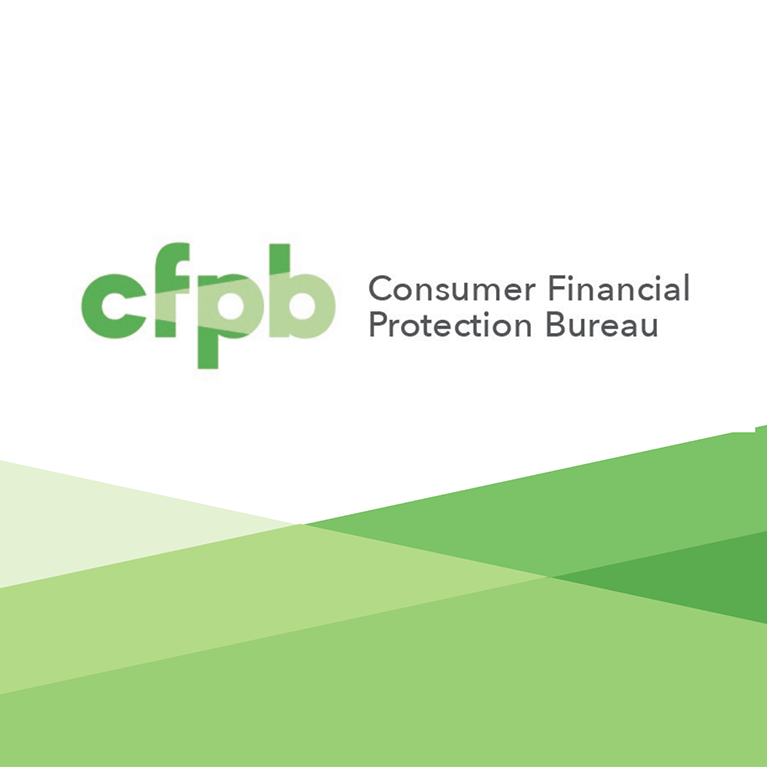 CFPB: Accepting Applications For Advisory Committees
CFPB: Accepting Applications For Advisory Committees- To ensure that the CFPB hears from a variety of external experts with diverse viewpoints, we established the Consumer Advisory Board, the Community Bank Advisory Council, the Credit Union Advisory Council, and the Academic Research Council. These advisory committees provide the CFPB with information about emerging trends and practices in the consumer financial marketplace. They also allow us to hear directly from small financial institutions.
- Starting Tuesday, July 5, we’re accepting applications for membership on all four of our advisory committees. We’re inviting applications from individuals who can provide us with insight and advice as we carry out our work. Here are some examples of the types of applicants we’re looking for:
- Experts in consumer protection, community development, consumer finance, fair lending, and civil rights
- Experts in consumer financial products or services, including consumer reporting, student lending, small dollar lending, credit cards, debt collection, and debt relief
- Experts in consumer finance education
- Representatives of banks and credit unions that serve underserved communities
- Representatives of communities that have been significantly impacted by higher priced mortgage loans
- Current employees of credit unions and community banks
- Academics with a strong research and publishing or practitioner background, and a record of involvement in research and public policy, including public or academic service
 Click here for instructions on how to apply.
Click here for instructions on how to apply.  CFPB Issues Advisory to Protect Privacy When Companies Compile Personal Data
CFPB Issues Advisory to Protect Privacy When Companies Compile Personal Data- Advisory affirms that “permissible purposes” are required to use and share credit reports and background reports
- July 7, 2022 — the Consumer Financial Protection Bureau (CFPB) issued a legal interpretation to ensure that companies that use and share credit reports and background reports have a permissible purpose under the Fair Credit Reporting Act. The CFPB’s new advisory opinion makes clear that credit reporting companies and users of credit reports have specific obligations to protect the public’s data privacy. The advisory also reminds covered entities of potential criminal liability for certain misconduct.
- Over the last century, Congress enacted a number of sector-specific privacy laws to protect personal data, such as educational and health data. One law that includes privacy protections across multiple sectors is the Fair Credit Reporting Act. The Fair Credit Reporting Act regulates companies that assemble dossiers on individual consumers, including credit reporting companies, tenant screeners, and other data brokers.
- Permissible Purposes
- Among other things, the Fair Credit Reporting Act ensures fair and accurate reporting, and it requires users who buy these dossiers to have a legally permissible purpose. This ensures that companies cannot check an individual’s personal information, including their credit history, without a bona fide reason. Some common permissible purposes include using consumer reports for credit, insurance, housing, or employment decisions. For example, a bank may request a credit report in order to determine the terms on which it will offer someone a line of credit.
- Specifically, the advisory opinion makes clear:
- Insufficient matching procedures can result in credit reporting companies providing reports to entities without a permissible purpose, which would violate consumers’ privacy rights: For example, when a credit reporting company uses name-only matching procedures, the items of information appearing on a credit report may not all correspond to a single individual. That means the user of a credit report could be provided a report about a person for whom the user does not have a permissible purpose.
- It is unlawful to provide credit reports of multiple people as “possible matches”:Credit reporting companies may not provide reports on multiple individuals where the requester only has a permissible purpose to obtain a report on one individual. They must have adequate procedures to find the right person, or else the result may be that they provide a report on at least one wrong person.
- Disclaimers about insufficient matching procedures do not cure permissible purpose violations: Disclaimers will not cure a failure to take reasonable steps to ensure the information contained in a credit report is only about the individual for whom the user has a permissible purpose.
- Users of credit reports must ensure that they do not violate a person’s privacy by obtaining a credit report when they lack a permissible purpose for doing so: The Fair Credit Reporting Act strictly prohibits anyone from using or obtaining credit reports without a permissible purpose.
- Click here to read more, including details on Criminal Liability for Violating the Fair Credit Reporting Act’s Privacy Protections
- Articles for July 1, 2022 Issue:
- U.S. Chamber of Commerce Launches ‘Extensive Campaign to Expose and Defeat’ CFPB Director
- CFPB Moves to Reduce Junk Fees Charged by Debt Collectors
- Industry Trade Groups Urge CFPB to Extend Comment Period on Late Fees Rule
- CDFI Fund Offering $1.73 Billion in Grants to Help Communities Recovering from COVID Pandemic
-
 U.S. Chamber of Commerce Launches ‘Extensive Campaign to Expose and Defeat’ CFPB Director
U.S. Chamber of Commerce Launches ‘Extensive Campaign to Expose and Defeat’ CFPB DirectorCourtesy of CUToday.info
June 28, 2022 — The U.S. Chamber of Commerce said it is launching an “extensive campaign to expose and defeat Consumer Finance Protection Bureau (CFPB) Director Rohit Chopra’s ideologically driven agenda to radically change the nature of America’s financial services industry.”
If Chopra is allowed to proceed, the Chamber said his “agenda would harm consumer choice and innovation.” According to the U.S. Chamber, Chopra has “outlined extreme and inaccurate views around the state of our financial system regulations, including that he has:
- Described “repeat offenses” as “par for the course for many dominant firms.”
- Stated that financial regulators were “…clueless and often corrupt lawyers and economists…often seen as auditioning for a future job…”
- Coined the term “junk fees” as “exploitive income streams” in a heavy-handed attempt to vilify legal products that have well-disclosed terms.
‘Unlawful Actions’
 The Chamber said its campaign is specifically objecting to several “unlawful actions,” including Chopra’s intentions to change rules without accountability, injecting great uncertainty into the market, therefore, causing financial companies to limit the types of mortgages, car loans, and personal credit they can offer consumers.
The Chamber said its campaign is specifically objecting to several “unlawful actions,” including Chopra’s intentions to change rules without accountability, injecting great uncertainty into the market, therefore, causing financial companies to limit the types of mortgages, car loans, and personal credit they can offer consumers.Chopra has also proposed outright bans on certain products and has stated his intention to restructure the industry, ultimately hurting consumers by limiting choice and diminishing competition, according to the U.S. Chamber.
“Director Chopra is attempting to use the CFPB to radically reshape the American financial services sector,” said Neil Bradley, EVP-chief policy officer with the U.S. Chamber of Commerce. “Rohit Chopra has an outsized view of the CFPB’s role and the Director’s power. By willfully mischaracterizing the state of competition in the market Chopra is laying the groundwork to force the financial services sector to comport with his personal vision of the appropriate size of companies and what products and services should be offered and under what conditions. No previous CFPB Director has thought they had such power. Rohit Chopra’s radical agenda and reckless actions will only hurt consumers, businesses, and our economy and he needs to be held accountable.”
Actions Being Taken
As part of this campaign, the U.S. Chamber of Commerce said it is:
- Launching a new six figure digital ad campaign. “The ads highlight Director Chopra’s outsized view of his role and radical agenda, subject to no accountability,” the Chamber said.
- Filing six Freedom of Information Act (FOIA) requests. The FOIAs demand that the agency make available its current procedural manual, records relating to the agency’s communications with the White House on President Biden’s July 9, 2021 Executive Order on Competition, among other requests for additional transparency.
Issuing two letters from the Chamber’s Litigation Center detailing the CFPB’s unlawful and imprudent actions. According to the Chamber, the first letter details Director Chopra’s unlawful actions to rewrite the “unfairness” standard via a change to the agency’s examination manual. The second letter describes four other legally dubious actions, including its “Policy Fellowship Program,” changes to administrative adjudication procedures, changes to supervision of non-depository financial institutions, and issuance of an “interpretive rule” announcing new authority for state attorneys general
 CFPB Moves to Reduce Junk Fees Charged by Debt Collectors
CFPB Moves to Reduce Junk Fees Charged by Debt CollectorsJune 28, 2022 — The Consumer Financial Protection Bureau (CFPB) issued an advisory opinion affirming that federal law often prohibits debt collectors from charging “pay-to-pay” fees. These charges, commonly described by debt collectors as “convenience fees,” are imposed on consumers who want to make a payment in a particular way, such as online or by phone.
“Federal law generally forbids debt collectors from imposing extra fees not authorized by the original loan,” said CFPB Director Rohit Chopra. “Today’s advisory opinion shows that these fees are often illegal, and provides a roadmap on the fees that a debt collector can lawfully collect.”
Debt collectors play a critical role in the consumer finance ecosystem, and the CFPB wants to ensure that law-abiding debt collectors are not disadvantaged by their competitors that impose unlawful fees. While most debt collectors allow consumers to make payments by phone or online without charging additional fees, some debt collectors impose additional fees for those types of payments. These debt collectors do so even if it is cheaper and less time-consuming for them to process phone and online payments than it is to process the paper-check payments delivered by mail or in person that debt collectors typically process for free. These types of fees are often illegal, and today’s advisory opinion and accompanying analysis seek to stop these violations of law and assist consumers who are seeking to hold debt collectors accountable for illegal practices.
The advisory opinion interprets the language in Section 808 of the Fair Debt Collection Practices Act (FDCPA), which prohibits debt collectors from collecting any amount that is not expressly authorized by the underlying agreement or permitted by law. The FDCPA was passed in 1977 in response to widespread abuses in the debt collection industry, which Congress acknowledged was not subject to appropriate regulation under existing laws at the time. In 2010, the Consumer Financial Protection Act transferred primary responsibility for the FDCPA, including issuing regulations and ensuring compliance, to the CFPB.
The advisory opinion covers the following on debt collection practices:
- Identifies scope of illegal fees: The collection of any fee is prohibited unless the fee amount is in the consumer’s contract or affirmatively permitted by law.
- Affirms that silence in the law is not an authorization: A debt collector may only collect a fee when it is authorized by the agreement creating the debt or is “permitted by law.” Where no law expressly authorizes a fee, it is not “permitted by law,” even if no law expressly prohibits it.
- Clarifies role of payment processors: Debt collectors violate the FDCPA when using payment processors who charge unauthorized fees at a minimum if the debt collector receives a kickback from the payment processor.
This advisory opinion continues the CFPB’s focus on addressing junk fees in consumer finance. Last week, the CFPB announced a review of the credit card industry’s penalty policies costing consumers over $12 billion each year, and published an Advance Notice of Proposed Rulemaking asking for information to help determine whether regulatory adjustments are needed to address late fees under the Credit Card Accountability Responsibility and Disclosure Act of 2009 (CARD Act). In addition, the CFPB earlier this year sent out a request for information to hear from the public about potential junk fees. The comments that the Bureau received are available for public inspection here .
 Industry Trade Groups Urge CFPB to Extend Comment Period on Late Fees Rule
Industry Trade Groups Urge CFPB to Extend Comment Period on Late Fees RuleCourtesy of Dave Kovaleski, Financial Regulation News
June 29, 2022 — Several industry trade associations are urging the Consumer Financial Protection Bureau (CFPB) to grant a 60-day extension for comments on its proposed rule on credit card late fees that financial institutions collect.
The proposed rule would reduce the $12 billion financial institutions collect in credit card late fees each year.
“In making this request, the undersigned Associations note that CFPB is choosing to reopen a rule that was enacted by the Board of Governors of the Federal Reserve in 2010 with little controversy and has continued to operate without substantial amendment through the tenure of former CFPB leaders,” wrote the groups to CFPB Director Rohit Chopra. “The most recent adjustment to the allowable late fees occurred in just the last year when the CFPB under your leadership published a final rule setting the current first instance safe harbor ($30) and the second instance safe harbor ($41).”
The letter was signed by the National Association of Federally-Insured Credit Unions (NAFCU), Credit Union National Association (CUNA), American Bankers Association, Bank Policy Institute, Consumer Bankers Association, and Independent Community Bankers of America.
The groups noted that the CFPB’s regulatory action on fees was not included in its spring 2022 regulatory agenda, so they requested more time to process and analyze the proposed rule. They said the typical 30-day comment period is not a sufficient enough period of time to go through the large volume of data.
“The information sought in this ANPR is complex and comprehensive, requiring significant analysis and internal coordination to enable firms to provide a meaningful contribution to the public comment record in furtherance of the CFPB’s consideration of credit card late fees and late payments,” the letter reads. “Many of the data points requested have not previously been requested by the CFPB, and respondents require more time than has been provided to properly validate their data production methods and to actually produce what is expected to be a large volume of data.”
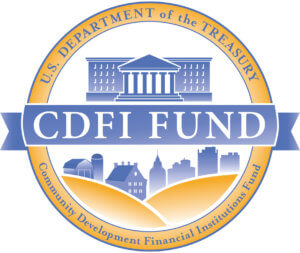 CDFI Fund Offering $1.73 Billion in Grants to Help Communities Recovering from COVID Pandemic
CDFI Fund Offering $1.73 Billion in Grants to Help Communities Recovering from COVID Pandemic - June 28, 2022 — Credit unions designated as Community Development Financial Institutions have until August 23 to apply for grants under the CDFI Fund’s Equitable Recovery Program.The CDFI Fund is making $1.73 billion available to help eligible financial institutions expand lending, provide grants, and make investments in low-to-moderate-income communities, including minority communities, that need better access to financial services and were disproportionately affected by the COVID-19 pandemic. Award funds may be expended for two types of eligible activities: financial products and services and operational support.The CDFI Fund website has a dedicated page with information on this program, including a link to the Notice of Funds Availability, eligibility criteria, and the application requirements, process, and timelines.
 The CDFI Fund will host an informational webinar on the Equitable Recovery Program on June 29, beginning at 1 p.m. Eastern and on July 7, beginning at 3 p.m. Eastern. Advance registration is not required. The CDFI’s dedicated web page has information on joining the webinars. The Fund also posted its recorded pre-application webinar.All applicants must have active accounts with the federal government’s System for Award Management, Grants.gov, and the CDFI Fund’s Awards Management Information System.
The CDFI Fund will host an informational webinar on the Equitable Recovery Program on June 29, beginning at 1 p.m. Eastern and on July 7, beginning at 3 p.m. Eastern. Advance registration is not required. The CDFI’s dedicated web page has information on joining the webinars. The Fund also posted its recorded pre-application webinar.All applicants must have active accounts with the federal government’s System for Award Management, Grants.gov, and the CDFI Fund’s Awards Management Information System. -
Articles for June 24, 2022 Issue:
- FCA Calls for Input on the Use of Synthetic Data to Support Financial Services Innovation
- OPINION: Congress Can Do Better Than the Howey Test for Crypto Regulation
- Biden to Appoint First Native American to Serve as Treasurer
- CFPB Initiates Review of Credit Card Company Penalty Policies Costing Consumers $12 Billion Each Year
-
 FCA Calls for Input on the Use of Synthetic Data to Support Financial Services Innovation
FCA Calls for Input on the Use of Synthetic Data to Support Financial Services InnovationCourtesy of Finextra.com
The Financial Conduct Authority has launched a study into the use of algorithmically generated synthetic data and its potential for safely opening data sharing between firms, regulators and other public bodies.
The regulator has released a call for input from stakeholders to better understand different market participants’ views on the extent to which synthetic data can expand data access and data sharing opportunities in an increasingly digital market
“Increasingly, innovation within financial services is data-driven, requiring large volumes of high-quality data to develop and train accurate, effective models and systems,” says the wathdog. ”However, financial data – such as consumer transaction records, account payments, or trading data – is sensitive personal data subject to data protection obligations, as well as often being commercially sensitive. This is where we believe synthetic data can help.”
The study will also evaluate the maturity of synthetic data usage within financial services, and the extent to which both regulated and unregulated firms are using it.
The FCA is additionally interested in what the industry sees as the role of the regulator and the appetite of firms to collaborate with regulators and/or other organizations to generate synthetic data.
 OPINION: Congress Can Do Better Than the Howey Test for Crypto Regulation
OPINION: Congress Can Do Better Than the Howey Test for Crypto RegulationCourtesy of Howard B. Adler, Opinion Contributor, The Hill
Cryptocurrencies are generally not subject to federal regulation unless they are deemed to be “securities,” in which case the Securities Act of 1933 requires them to abide by disclosure requirements and antifraud regulation by the Securities and Exchange Commission (SEC) if they are offered to the public.
The test the SEC uses to determine whether a cryptocurrency is a security was laid out by the Supreme Court in Securities and Exchange Commission v W. J. Howey Co. If the SEC asserts that a cryptocurrency is a security, an alleged issuer seeking to challenge that contention must litigate. The criteria contained in the so-called Howey test are irrelevant to any rational public policy reason to regulate cryptocurrency. Yet, cryptocurrency companies are forced to spend millions in legal fees to seek to demonstrate that their products do not meet these criteria.
Howey, of course, did not deal with cryptocurrency or any other form of modern technology. Rather it dealt with a 1940’s era scheme to market units of a citrus grove in Florida coupled with a contract for cultivating and marketing the grove’s fruit and paying the profits to investors. The court held that an investment is an “investment contract,” and thus, a security as defined in the Securities Act, if it is “a contract, transaction or scheme whereby a person invests his money in a common enterprise and is led to expect profits solely from the efforts of the promoter or a third party.”
With respect to cryptocurrency, the crucial prong of this test is usually whether profits result solely from the efforts of a promoter or third party. Using this test, the SEC determined that Bitcoin, which is a decentralized network with no promoter, is not a security. A number of forms of cryptocurrency follow the decentralized finance, or “defi,” model that relies on peer-to-peer payments with no promoter or financial intermediary. It is unlikely that these forms of cryptocurrency would be deemed securities under Howey. Other forms of cryptocurrency, such as interest-bearing stablecoins, would meet the Howey test because a promoter is paying interest. Does this distinction make any sense?
In determining whether a financial product should be regulated, governments generally look at the following factors: Do the people who are being offered the product require protection from fraud or dishonesty? Do the markets in which the product is sold require regulation to preserve their integrity? Are there broader governmental interests at stake?
In the case of cryptocurrency, regardless of whether profits result from the efforts of a promoter, purchasers have been defrauded of billions of dollars, resulting from cyber hacks and failures to disclose risks or the actual assets and liabilities of cryptocurrency entities. Cryptocurrency is increasingly being marketed through the same vehicles as more conventional financial products, including broker-dealers, mutual funds and securities exchanges and the integrity of these markets must be protected. Finally, important governmental interests mandate regulation. For example, since cryptocurrencies are often used by criminals, law enforcement and anti-money laundering regimes are implicated. In addition, the government’s strong interest in preserving the primacy of the U.S. dollar gives it an interest in overseeing potential competitors to the dollar. All of these factors are present for all cryptocurrencies regardless of whether or not they meet the Howey test.
Unfortunately, in the absence of congressional action to regulate cryptocurrency, the SEC is left with only the Howey test and its resulting illogic. In designing a regulatory scheme, Congress has the luxury of directly considering the technologies involved, rather than applying a test that originated in the Florida citrus industry.
Biden to Appoint First Native American to Serve as Treasurer
Courtesy of Olafimihan Oshin, the Hill

Photo courtesy of The Mohegan Tribe
June 21, 2022 — President Biden is set to announce the appointment of Lynn Malerba, the lifetime chief of the Mohegan Tribe, as the first Native American to serve as U.S. treasurer.
In a statement, the Treasury Department said that Malerba, who previously served in the department’s Tribal Advisory Committee, will also oversee the Office of Tribal and Native Affairs, a newly established office that will directly communicate with tribal nations and be the hub for tribal policy.
Her name will be the first signature seen on U.S. currency belonging to a Native woman and tribal leader in the nation’s history.
Malerba will also oversee the U.S. Mint and Fort Knox and will work closely with the Federal Reserve as a liaison.
Treasury Secretary Janet Yellen, who will be the first Treasury secretary to visit a reservation when she travels to the Rosebud Indian Reservation in South Dakota on Tuesday, congratulated Malerba, noting that her appointment will be beneficial for the economic opportunities in the tribal community.
“I am deeply honored that Chief Malerba will serve as the nation’s Treasurer and spearhead the department’s new Office of Tribal and Native Affairs. This is an historic appointment,” Yellen said in a statement.”
The Treasury created a “tribal team” last year as part of an effort to improve relations with tribal nations and help administer $30 billion in programs directed to tribes as part of the American Rescue Plan in an effort to combat the pandemic.
“I am honored and humbled by Secretary Yellen and the Biden Administration’s commitment to ensuring that all voices are heard by Treasury as we work together to create an equitable and just society,” Malerba said in a statement.
“It is especially important that our Native voices are respected. This appointment underscores this Administration’s commitment to doing just that. I am excited to serve our communities as Treasurer and for the work ahead.”
 CFPB Initiates Review of Credit Card Company Penalty Policies Costing Consumers $12 Billion Each Year
CFPB Initiates Review of Credit Card Company Penalty Policies Costing Consumers $12 Billion Each YearJune 21, 2022 — The Consumer Financial Protection Bureau (CFPB) is taking the first step toward addressing credit card company penalty policies costing consumers $12 billion each year, starting by looking at excessive late fees. In an Advance Notice of Proposed Rulemaking published today, the CFPB asks for information on the Federal Reserve Board of Governors’ 2010 immunity provision for excessive late fees that allows credit card companies to escape enforcement scrutiny. The CFPB is seeking data about credit card late fees and late payments, assessing whether those fees are “reasonable and proportional.” We are also seeking data about card issuers’ revenue and expenses, the potential deterrent effect of late fees, and the role late fees play in credit card companies’ profitability.
Advance Notice of Proposed Rulemaking
Under the Consumer Financial Protection Act, Congress transferred the authority to adjust the late fee provisions from the Fed to the CFPB. Today, the CFPB has published an Advance Notice of Proposed Rulemaking to review the Fed’s immunity provision and determine whether adjustments are needed to address late fees. Late fee penalties are charged in addition to interest when a cardholder does not make the minimum payment by the due date.
Over 175 million Americans hold at least one credit card. In March, the CFPB issued a report, Credit Card Late Fees, that found that many major issuers charge the maximum late fee allowed under the immunity provisions; 18 of the top 20 issuers set late fees at or near the established maximum level. The report also found that the credit card market continues to generate sizable profit from late fees. Credit card companies charged $12 billion in late fee penalties in 2020. This makes up 10 percent of the total cost of credit cards to customers. And that revenue comes disproportionately from people living in low-income neighborhoods.
Today’s Advance Notice of Proposed Rulemaking asks card issuers, consumer groups, and the public to comment on the following:
- How do credit card issuers set late fee amounts? How is the fee determined to be considered reasonable or proportionate or at least related to the actual costs to the card issuer? How is the fee related to the statement balance?
- Are revenue goals a factor in determining late fees? How do they figure into profitability for the card issuers?
- What are card issuers’ costs and losses associated with late payments?
- Do late fees have a deterrent effect? Does the amount have a deterrent effect? Do card issuers impose other consequences other than late fees when payments are late?
- What methods are card issuers using to encourage timely payments, including autopay and notifications?
- How many calendar days after the due date do consumers make the late payment? For example, what percentage of accounts is less than 24 hours late versus 30 days late?
- For card issuers, what annual income is coming from interest and fees? What are annual expenses?
Read the Advance Notice of Proposed Rulemaking regarding Credit Card Late Fees and Late Payments.
Public input will inform revisions to Regulation Z, which implements the CARD Act and the Truth in Lending Act. The deadline for submitting comments is July 22, 2022.
 Read the entire notice here.
Read the entire notice here. - Articles for June 17, 2022 Issue:
- Global Regulators Set Out Climate Checklist
- OCC Wants to Start Collecting Cannabis, Crypto Business Data from Banks
- California’s Top Regulator Launches Effort to Regulate Crypto Financial Products
- NCUA Releases Q1 2022 State-Level Credit Union Data Report
 Global Regulators Set Out Climate Checklist
Global Regulators Set Out Climate Checklist- Courtesy of Huw Jones, Reuters
- June 15, 2022 — Global regulators published a detailed checklist for banks on Wednesday to assess how climate change affects all aspects of their business, including pay and capital, as economies set carbon reduction targets.
- READ MORE: New York Senate Passes Bitcoin Mining Moratorium
The New York State Senate voted to pass the bill overnight that would establish a two-year moratorium on permitting new crypto mining that uses proof-of-work authentication methods using carbon-based fuel.
- International banks like Goldman Sachs, Deutsche Bank and HSBC will be expected to examine whether they are quantifying risks from climate change properly despite sometimes patchy data and time horizons that go well beyond traditional risk assessments and remuneration packages.
- The guidance is the latest effort by the Basel Committee, made up of regulators from the United States, Europe, Japan, China and elsewhere, to review how their rulebook covers climate change in a sector at the forefront of efforts to transition to a net-zero economy.
- Banks must look at how risks from climate change affect their business strategy, training of senior staff and board members, internal controls, capital and pay over the short, medium and longer term, the guidance showed.
- “The board and senior management should consider whether the incorporation of material climate-related financial risks into the bank’s overall business strategy and risk management frameworks may warrant changes to its compensation policies,” Basel said. “Banks should identify, monitor and manage all climate-related financial risks that could materially impair their financial condition, including their capital resources and liquidity positions.”
- Members of the committee, which include regulators from the United States, Europe, China and Japan, are expected to apply the new guidance as soon as possible, and Basel will monitor compliance.
- Regulators say few if any banks have been making such detailed and comprehensive assessments of climate risks.
- Separately, banks in the United States, European Union and elsewhere face mandatory disclosures to investors on how climate change is affecting their business.

- Read more here.
 OCC Wants to Start Collecting Cannabis, Crypto Business Data from Banks
OCC Wants to Start Collecting Cannabis, Crypto Business Data from Banks- Courtesy of Anna Hrushka, BankingDive.com
- June 9, 2022 — Dive Brief
- The Office of the Comptroller of the Currency (OCC) is proposing adding cannabis and digital currency activities to the list of business data it collects from banks in an attempt to better identify areas of risk in the financial system, according to a notice the agency posted in the Federal Register on Wednesday.
- OCC-supervised banks are required to file an annual risk summary form (RSF), which collects data about different products, services, customers and geographies (PSCs).
- The OCC said it wants to add six new PSCs this year: cash transactions, marijuana-related businesses, ATM operators, crypto asset custody, stablecoin issuance and stablecoin payments. The regulator said it also plans to add three customer types under the money transmitters category: customers that accept or transmit crypto currency, crypto ATM operators and crypto asset exchanges.
- Dive Insight:
- The OCC’s proposal would put cannabis and crypto on a list of industries — such as casinos, liquor stores and check cashers — from which it already collects data.
- “As new products and services are introduced, existing products and services change, and banks expand through mergers and acquisitions, banks’ evaluation of money laundering and terrorist financing risks should evolve as well,” the OCC said in its notice.
- The OCC said its money laundering risk assessment (MLR) is an important tool for its Bank Secrecy Act and anti-money laundering activities “because it allows the agency to better identify those institutions, and areas within institutions, that may pose heightened risk and allocate examination resources accordingly.”
- “This risk assessment is critical for protecting U.S. financial institutions of all sizes from potential abuse from money laundering and terrorist financing,” the regulator said.
- The OCC’s proposal also deletes four existing categories: boat/airplane, bulk cash/currency repatriation customers, bulk cash/currency repatriation and international branches.
- The agency will collect comments on the proposal until Aug. 8, it said.
- The MLR sheds light on products or customers that may be experiencing difficulties or challenges maintaining banking services, the OCC said.
 Read more here.
Read more here. California’s Top Regulator Launches Effort to Regulate Crypto Financial Products
California’s Top Regulator Launches Effort to Regulate Crypto Financial Products- Courtesy of Kate Berry, American Banker
- June 02, 2022 — California’s top financial regulator took the first step toward oversight of cryptocurrency financial products by issuing a broad public request for information on the fast-growing but volatile crypto market.
- California’s Department of Financial Protection and Innovation said Wednesday that it wants input on the risks posed by crypto financial products and how it can better protect consumers from frauds and scams. The input will help the agency develop guidance, regulatory clarity and supervision of crypto financial products and services in California.
- The inquiry comes on the heels of a broad executive order that Democratic Gov. Gavin Newsom signed last month directing the state’s DFPI to conduct a market-monitoring inquiry of crypto.
-
“We know that this is a moment where we need to act,” Suzanne Martindale, the department’s senior deputy commissioner, said in an interview Thursday with American Banker. “Because of the dynamic, evolving and unsettled nature of this space, we’re trying to be adaptive and base our thinking on the data, the market research and the stakeholder input we’re getting.”
- The move comes as federal agencies are scrambling to coordinate oversight of crypto with a fragmented response so far. In March, the Biden administration directed the Treasury Department and other agencies to respond to the rapid growth of cryptocurrencies and digital assets.
- “We are trying to be very smart and closely coordinated with our fellow regulators so that we’re not accidentally conflicting in developing terms, or deciding to apply certain laws,” Martindale said.
- The financial protection department provided a list of 16 questions for public comment.
- Among the questions asked are whether crypto firms should be required to be licensed in the state and what rules are needed to ensure that certain features of crypto products — such as fees or other hidden charges — are properly disclosed to consumers.
- “What we’re going to be looking at as a financial regulator is the different use cases that show up, because crypto is showing up in lending arrangements and we have bank licensees and companies that are involved in crypto in some way,” Martindale said.
- Read more here. (Log-in required.)
 NCUA Releases Q1 2022 State-Level Credit Union Data Report
NCUA Releases Q1 2022 State-Level Credit Union Data Report- The NCUA Quarterly U.S. Map Review for the first quarter of 2022 covers several key indicators of the financial health and viability of federally insured credit unions, including:
- Median four-quarter growth in assets,
- Median four-quarter growth in shares and deposits,
- Median four-quarter growth in members,
- Median four-quarter growth in loans,
- Median delinquent loans as a share of total loans,
- Median loans outstanding as a share of total shares and deposits,
- Median year-to-date return on average assets, and
- Share of federally insured credit unions with positive year-to-date net income.
- Four-quarter growth is the growth from the end of the first quarter of 2021 through the first quarter of 2022. Most maps shown in this review display medians, or the 50th percentile of the distribution of the variable. In other words, for a given metric, half of all credit unions had a value at or above the median, while the other half had a value that was less than or equal to the median.
- Data presented in this review are rounded. Unless otherwise noted, indicators in percentages are rounded to the nearest tenth of a percentage point, while indicators in basis points are rounded to the nearest basis point. In the legends, the data range in each color band excludes the value of the lower bound but includes the value of the upper bound of the range. Credit unions are included in their states of chartering or the states in which their headquarters are located.
 Read the report here.
Read the report here.- Articles for June 10, 2022 Issue:
- Marijuana Regulators and Stakeholders Hold Closed-Door Conference To Discuss Future Of Reform And Industry Challenges
- Growth in Lending, Assets, Insured Shares Reported in First Quarter of 2022
- Senators Unveil Industry-Friendly Bill to Regulate Cryptocurrency
- UK Government Wants Financial Regulators to Oversee Amazon, Microsoft Cloud Businesses
 Marijuana Regulators and Stakeholders Hold Closed-Door Conference To Discuss Future Of Reform And Industry Challenges
Marijuana Regulators and Stakeholders Hold Closed-Door Conference To Discuss Future Of Reform And Industry Challenges- Courtesy of Kyle Jaeger, MarijuanaMoment.net
- June 6, 2022 — Marijuana government regulators, trade associations and businesses are meeting for a two-day conference beginning on Monday to help chart a path forward as the state-by-state legalization movement continues to grow amid relative federal stagnation. The cannabis stakeholders will strategize about a wide range of policy considerations ranging from promoting equity in the industry to interstate commerce to creating rules around emerging cannabinoids.
- Details of the closed-to-press gathering, organized by the non-partisan Cannabis Regulators Association (CANNRA), were shared exclusively with Marijuana Moment ahead of the event.
- “We felt like this was an opportunity for us to more formally introduce ourselves to stakeholders and formalize some of those relationships and hear a wide range of perspectives in person, to be able to hear different views,” CANNRA Executive Director Gillian Schauer told Marijuana Moment in a phone interview.
- There will be about a dozen panels, each of which are designed to inform the people in charge of regulating a medley of state and local cannabis programs as the policy landscape continues to expand and evolve.
- For example, there will be a panel moderated by a representative of the Michigan Cannabis Regulation Agency (MCRA) that broadly examines the “state and federal roles in a future national marketplace.” Panelists will include members of the U.S. Cannabis Council (USCC), Coalition for Cannabis Policy, Education, and Regulation (CPEAR), Council for Federal Cannabis Regulation (CFCR) and National Cannabis Roundtable (NCR).
 Read More Here
Read More Here Growth in Lending, Assets, Insured Shares Reported in the First Quarter of 2022
Growth in Lending, Assets, Insured Shares Reported in the First Quarter of 2022- June 7, 2022 — According to the latest financial performance data released today by the National Credit Union Administration, total loans outstanding in federally insured credit unions increased $136 billion, or 11.7 percent, over the year ending in the first quarter of 2022, to $1.30 trillion. During the same period, total assets rose by $169 billion, or 8.7 percent, to $2.12 trillion. Insured shares and deposits rose $125 billion, or 8.0 percent, to $1.69 trillion, from one year earlier.
- The NCUA’s Quarterly Credit Union Data Summary provides an overview of the financial performance of federally insured credit unions based on information reported to the agency in the first quarter of 2022. As of March 31, 2022, there were 4,903 federally insured credit unions with 131.0 million members.
- Highlights from the NCUA’s Quarterly Data Summary Report(opens new window) for the first quarter of 2022 include:
- Net income for federally insured credit unions in the first quarter of 2022 totaled $18.1 billion at an annual rate, down $1.6 billion, or 8.2 percent, from the first quarter of 2021. Interest income rose $3.3 billion, or 5.7 percent, over the year to $61.0 billion. Non-interest income fell $2.0 billion, or 7.5 percent, to $24.3 billion, largely due to a drop in other income.
- The credit union system’s provision for loan and lease losses or credit loss expense was little changed at $2.9 billion at an annual rate in the first quarter of 2022.
- Total loans outstanding increased $136.2 billion, or 11.7 percent, over the year, to $1.30 trillion. Credit union loan balances rose in most major categories compared with the first quarter of 2021.
- The delinquency rate at federally insured credit unions was 42 basis points in the first quarter of 2022, down 4 basis points compared with the first quarter of 2021. Loan performance was mixed across major categories.
- Credit union shares and deposits rose by $157.9 billion, or 9.3 percent, over the year to $1.85 trillion in the first quarter of 2022. Regular shares increased $60.1 billion, or 9.6 percent, to $686.1 billion. Other deposits increased $37.0 billion, or 5.0 percent, to $777.7 billion, led by money market accounts, which were up $61.7 billion, or 17.1 percent.
- The credit union system’s net worth increased by $21.1 billion, or 10.8 percent, over the year to $216.4 billion. The aggregate net worth ratio — net worth as a percentage of assets — stood at 10.22 percent in the first quarter of 2022, up from 10.02 percent one year earlier.
 Read the full release here.
Read the full release here.  Senators Unveil Industry-Friendly Bill to Regulate Cryptocurrency
Senators Unveil Industry-Friendly Bill to Regulate Cryptocurrency- Regulatory framework would spare much of the crypto market from SEC oversight and create favorable tax treatment
- Courtesy of Paul Kiernan, Wall Street Journal
- A pair of U.S. senators unveiled legislation that would create special exemptions to federal law for some cryptocurrencies, amid an intensifying lobbying push by the industry to avoid existing regulations.
- Sens. Cynthia Lummis (R., Wyo.) and Kirsten Gillibrand (D., N.Y.) outlined a bill Tuesday dubbed the Responsible Financial Innovation Act, which aims to create a “complete regulatory framework for digital assets.” In a joint press release, they said it would balance the crypto market’s need for guardrails and consumer protections with a desire to promote financial innovation.
- “As this industry continues to grow, it is critical that Congress carefully crafts legislation that promotes innovation while protecting the consumer against bad actors,” Ms. Lummis said.
- Ms. Lummis has been the Senate’s most outspoken advocate for cryptocurrency since taking office last year. She reported personally owning between $100,000 and $250,000 of bitcoin in her 2022 financial disclosures.
- Congressional aides said the bill has little chance of advancing this year through the Senate, which is controlled by Democrats. Similar legislation introduced by crypto-friendly lawmakers in the House has languished.
- Among other objectives, the bill seeks to carve some cryptocurrencies out of the Securities and Exchange Commission’s jurisdiction. It also would create new concepts in the nearly 90-year-old securities laws that would allow issuers of some digital tokens to meet lighter disclosure requirements than public companies face.
 Read More Here.
Read More Here. UK Government Wants Financial Regulators to Oversee Amazon, Microsoft Cloud Businesses
UK Government Wants Financial Regulators to Oversee Amazon, Microsoft Cloud Businesses- Courtesy of PYMTS.com
- June 8, 2022 — The U.K. Treasury released a policy paper on Wednesday (June 8) proposing a new regulatory framework that would provide the Bank of England (BoE) and the Financial Conduct Authority (FCA) with new powers to oversee tech firms that provide critical services to the financial industry.
- The government is concerned about the growing dependence of banks on cloud computing, as these services are mostly provided by a handful of players. As of 2020, over 65% of U.K. firms used the same four cloud providers for cloud infrastructure services, according to the Treasury statement.
- If many firms rely on the same third party for material services and this company fails, it could have a systemic impact across the financial system, the paper argues.
- The government doesn’t cite by name which non-financial companies may be “critical” for the industry, but Amazon and Microsoft are two of the companies that may be affected by this regulation. The financial regulators’ current powers are not sufficient to tackle the systemic risks that disruption at a third party providing key services to multiple firms could cause, so the Treasury is proposing new legislation to address this concern.
- First, the Treasury, in consultation with the BoE and the FCA, will designate certain third parties as “critical.” The policy paper doesn’t offer information about the criteria that regulators will use to designate a company as “critical,” only that it will take into account “the number and type of services and the materiality of these services.”
- These criteria will be set out in primary legislation, and it is expected that the third parties affected could also make representations to the Treasury about this designation.
- Second, once a company has been designated as “critical,” the financial regulators will be able to make rules relating to the provision of these material services, gather relevant information from critical third parties and take formal action (including enforcement) where needed. More information about these powers is expected via primary legislation, but the Treasury advances that the regulators will be able to enter companies’ premises as part of an investigation, request information and require the production of documents.
- The paper doesn’t include all the potential penalties for the companies if they don’t comply with the regulator’s requests, but as a last resort, the government is considering granting regulators the power to prohibit a critical third party from providing future services or continuing to provide services to firms.
- The government’s next steps are to propose new legislation and publish a discussion paper on this topic shortly after such legislation is introduced. Legislation could be passed within this parliamentary session that started in May as the government included this plan in the Queen’s speech, which usually determines the laws that will be discussed in a parliamentary session.
- U.K. DORA Equivalent
- The U.K.’s plan to provide regulators with additional powers to supervise cloud providers in financial services mimics the European Union’s legislative proposal on the Digital Operational Resilience Act (DORA).
- DORA is a new law proposed by the European Commission that aims to establish uniform requirements for the security of networks and information systems in the financial sector.
- While most of the proposed law addresses banks and other financial institutions in Europe, there is a chapter devoted to information and communications technology (ICT) third-party risk, which includes cloud providers of critical or important functions.
- DORA will enable the European Supervisory Authorities to access critical ICT third-party service providers directly — and sanction them if necessary. First, as in the U.K. proposal, cloud providers will need to be designated as critical ICT third-party service providers. Then, the companies will be subject to a new set of rules.
 Read More Here
Read More Here-
Articles for June 3, 2022 Issue:
- Fed Paper Looks at the Potential Effects of CBDC on Monetary Policy
- In Case You Missed It: CFPB — Credit Denials Must Have Specific, Accurate Explanations
- Mortgage Servicing COVID-19 Pandemic Response Metrics: New Observations from Data Reported by Sixteen Servicers for May-December 2021
- Playing by the Rules: Fintechs Use AI for Marketing Compliance
- Fed Paper Looks at the Potential Effects of CBDC on Monetary Policy
- Courtesy of Derek Andersen, CoinTelegraph
 May 31, 2022 — The working paper traces the effects of operations with CBDCs through several scenarios and concludes the Fed will have it under control.
May 31, 2022 — The working paper traces the effects of operations with CBDCs through several scenarios and concludes the Fed will have it under control.- On Tuesday, the United States Federal Reserve released a study on the possible effects of a retail central bank digital currency (CBDC) on U.S. monetary policy implementation. The study, dated April, was a staff working paper titled “Retail CBDC and U.S. Monetary Policy Implementation: A Stylized Balance Sheet Analysis.”
- The paper considered four scenarios that illustrate the potential effects of a retail CBDC on monetary policy from the perspective of three stakeholder groups: the Fed, commercial banks and U.S. households.
- The first scenario involved exchanging cash for CBDC, which affected the categorization of assets at the Fed and in the household involved but had no effects on policy implementation. The following three scenarios showed a cascading effect that began with individuals withdrawing a CBDC from a commercial bank when the money had been deposited as cash.
- Assuming fixed-bank demand for reserves, the scenarios went on to discuss commercial banks’ reaction to the reduction in cash reserves resulting from CBDC withdrawals. If those withdrawals lead to a shortfall in reserves, banks have the choice of offloading certain securities or loans to build up their cash holdings again, or to increase deposits by offering more attractive terms on their products. That, in turn, could lead to higher short-term interest rates and reduce demand for CBDCs by holding deposits in banks longer.
- If interest rates rise too abruptly, the Fed could turn to the discount window and standing repo facility to moderate the rates, and if that fails, the next step would be reserve management purchases. Those technical operations are discussed in some detail.
- According to the authors, the paper showed that “the potential effects on monetary policy implementation from a retail CBDC are highly dependent on the initial conditions of the Federal Reserve’s balance sheet.” Their analysis also demonstrated how the Fed could use existing tools to manage the impact of retail CBDCs on monetary policy implementation.
- Related: Brainard tells House committee about potential role of CBDC, future of stablecoins
- The paper is the latest sign of the flurry of activity around CBDCs in the U.S. and other countries.
- In Case You Missed It: CFPB — Credit Denials Must Have Specific, Accurate Explanations
- Courtesy of PYMNTS.com
 The Consumer Financial Protection Bureau (CFPB) wants to remind consumers that federal law requires companies to explain specific reasons for denying credit applications, even when the creditor employs credit models using complex algorithms, according to a Thursday (May 26) press release.
The Consumer Financial Protection Bureau (CFPB) wants to remind consumers that federal law requires companies to explain specific reasons for denying credit applications, even when the creditor employs credit models using complex algorithms, according to a Thursday (May 26) press release.- Citing the Equal Credit Opportunity Act (ECOA), the agency said the law applies regardless of whether a firm is using a “black-box model” to make decisions on credit applications.
- “Companies are not absolved of their legal responsibilities when they let a black-box model make lending decisions,” CFPB Director Rohit Chopra said in a news release. “The law gives every applicant the right to a specific explanation if their application for credit was denied, and that right is not diminished simply because a company uses a complex algorithm that it doesn’t understand.”
- See also: CFPB’s Opinion on Fair Lending Rules Could Extend to AI
- ECOA protects applicants against discrimination when seeking, applying for, and using credit by making sure creditors provide a notice when taking adverse action against an applicant. In that notice, the creditor needs to list specific, accurate reasons for their action. They cannot use technologies in decision-making if that technology keeps them from being able to provide these necessary explanations, the bureau said.
- The CFPB notes that law-abiding financial companies have for years used advanced computational methods to make credit decisions, and have been able to show the thinking behind those decisions.
- “However, some creditors may make credit decisions based on the outputs from complex algorithms, sometimes called “black-box” models,” the bureau said. With such models, adverse action notices that meet ECOA’s requirements may not be possible.”
- Earlier this month, the CFPB said released its annual Fair Lending Report to Congress, which looks to the future of the CFPB’s work with financial markets and mentions predictive analytics, algorithms, and machine learning. It says that the agency is worried that “while the technology holds great promise, it can also reinforce historical biases.”
- Read more: CFPB Targets Credit Card “Suppressed Data” Practices
- This week also saw the CFPB release research that found many of the nation’s largest credit card companies aren’t routinely providing data to credit bureaus on the actual monthly payments their borrowers are making.
- The bureau said its research found that only half of these companies contribute data to credit reporting companies about the exact monthly payment made by borrowers and that many of them suppressed information they had in the past furnished.
- Mortgage Servicing COVID-19 Pandemic Response Metrics: New Observations from Data Reported by Sixteen Servicers for May-December 2021
 This is the second metrics report providing the CFPB’s observations of data obtained from 16 large mortgage servicers to identify areas of risk in the servicers’ COVID-19 pandemic response. The report addresses similar topics, including call center data, COVID-19 hardship forbearance exits, delinquency, and borrower profiles for the period May through December 2021.
This is the second metrics report providing the CFPB’s observations of data obtained from 16 large mortgage servicers to identify areas of risk in the servicers’ COVID-19 pandemic response. The report addresses similar topics, including call center data, COVID-19 hardship forbearance exits, delinquency, and borrower profiles for the period May through December 2021.- The updated report includes corrected versions of Figures 11 and 14 and updates to the accompanying observations.
- Read the full report (Updated May 25, 2022)
- Playing by the Rules: Fintechs Use AI for Marketing Compliance
- Courtesy of Nir Laznik, FinExtra.com
 May 23, 2022 — Anyone who follows professional sports could spot one of the most dominant players in the league – stock trading and investing apps. Seeing the biggest sports stages in the world flooded by fintech ads is another indicator of the billions of advertising dollars being spent by companies in the space. As the market for innovative personal finance apps, alternative trading services, and payment solutions heats up, the competition among financial services providers grows. Companies are spending billions on marketing and advertising, paying big bucks to be center stage for public attention.
May 23, 2022 — Anyone who follows professional sports could spot one of the most dominant players in the league – stock trading and investing apps. Seeing the biggest sports stages in the world flooded by fintech ads is another indicator of the billions of advertising dollars being spent by companies in the space. As the market for innovative personal finance apps, alternative trading services, and payment solutions heats up, the competition among financial services providers grows. Companies are spending billions on marketing and advertising, paying big bucks to be center stage for public attention.- For fintechs that operate globally and under the jurisdiction of multiple government agencies and regulatory systems, designing and deploying advertising and marketing campaigns is a risky business. As a result, localization of marketing campaigns take precedence as teams navigate a maze of global regulations aimed at protecting the consumer. Firms can be heavily penalized for misleading advertising, costing millions in fines, and losing hard-earned brand equity.
- To ensure compliance with regulations for governing ad content in financial services and adherence to corporate brand guidelines, leading financial services companies are adopting advanced technology platforms. Here are three key areas where technology can help keep marketing campaigns compliant:
- Omni-Channel Compliance
- Monitoring and tracking advertising content across all marketing channels can be fraught with risks. With a growing number of social media channels combined with the explosion of email marketing and television and print advertising, executives responsible for these function have a difficult job of oversight. They have to spend countless hours reviewing what their team is distributing across different channels and have to ensure those activities are compliant based on their location and subsector. Manual checks can no longer address the pace and scale in which advertising content is generated and distributed. Instead, financial institutions can leverage AI-based compliance platforms to automate their marketing compliance and focus on their campaigns.
- Affiliate overview
- With marketing affiliates taking an increasingly important role in fintechs’ go-to-market strategies, auditing their activity becomes critical. With affiliates being hyper sales-driven, there is a risk they can overcommit or overpromise to consumers. Yet, the full legal responsibility remains on the fintech provider selling the services, not the marketing affiliate charged with promotion. Auditing the activity of affiliates retrospectively isn’t effective when trying to avoid fines and non-compliance. New technologies and advanced AI enable real-time monitoring and identification of promotions to ensure your affiliates are operating within the rules.
- Proactive Remediation
- “A person who never made a mistake, never tried anything new” is a famous quote from Albert Einstein. It’s a phrase that many marketers can relate to. Marketers are trying new approaches and moving quickly to embrace the next new tactic, strategy, and channel to attract and retain customers. Experimenting and launching new campaigns can lead to mistakes and errors. When disaster strikes, marketers and compliance functions need a backup plan. Technology can serve as that critical backstop. Being able to retract and suspend any marketing piece is as important as detecting a misfired tweet or non-compliant print advertisement. Marketers need a platform that can manage the full spectrum of the marketing compliance function, and keep a record of all activities for their internal compliance function and for external audits. AI can provide those suggestions and next best steps. This simplifies the remediation process and gives marketers the support they need to move fast while reducing marketing risks.
- Like other functions in financial services, marketing is going through a period of disruption. Multi-channel campaigns, celebrities, influencers and affiliates, bold language and gamification are all being used to increase market share. To maximize marketing investments while preserving brand value and meeting compliance, fintechs should leverage advanced technology to allow self-fix and smart monitoring of all external communications and marketing campaigns.
- Articles for May 26, 2022 Issue:
- CFPB and New York Attorney General Shut Down Debt Collection Ring
- Digital Dollar Could Coexist With Stablecoins, Fed Vice Chairwoman Says
- Barr, Biden’s Pick for Fed Regulation Role, Cruises Through Confirmation Hearing
- EBA Publishes Regulatory Standards to Identify Shadow Banking Entities
 CFPB and New York Attorney General Shut Down Debt Collection Ring
CFPB and New York Attorney General Shut Down Debt Collection Ring- Companies and individuals used social media to smear consumers and threaten them with imprisonment
- May 23, 2022 — The Consumer Financial Protection Bureau (CFPB), in partnership with the New York Attorney General, filed a proposed stipulated judgment in federal court to settle its case against a debt collection enterprise and its owners and managers. The judgment would order all participants in the scheme, based in upstate New York, to exit the debt collection market after their history of deception and harassment. Their debt collection companies would also be shuttered and required to pay a total of $4 million in penalties.
- “It is illegal for debt collectors to orchestrate smear campaigns using social media to extort consumers into paying up,” said CFPB Director Chopra. “Our action with the New York Attorney General bans the ringleaders of this operation from the industry to halt further misconduct.”
- “This debt collection operation used illegal and deceptive tactics to prey on consumers, and now they are paying the price for the harm they caused,” said Attorney General Letitia James. “Predatory debt collectors make their profit by targeting hardworking consumers and then illegally saddle them deeper into debt. These debt collectors used harassing calls and false threats to coerce consumer to pay, not only is that illegal, it’s also downright shameful. Today’s action should send a strong message to debt collectors nationwide that we will not hesitate to use the full force of the law to hold them accountable if they hurt consumers.”
- The defendant companies are JPL Recovery Solutions; Regency One Capital; ROC Asset Solutions, which does business as API Recovery Solutions and Northern Information Services; Check Security Associates, which does business as Warner Location Services, Pinnacle Location Services, and Orchard Payment Processing Systems; Keystone Recovery Group; and Blue Street Asset Partners. The individual defendants are owners Christopher Di Re, Scott Croce, and Susan Croce, as well as Brian Koziel and Marc Gracie, who acted as managers of some or all of the companies.
- Read more here.
 Digital Dollar Could Coexist With Stablecoins, Fed Vice Chairwoman Says
Digital Dollar Could Coexist With Stablecoins, Fed Vice Chairwoman Says- Lael Brainard testifies on benefits, risks to a U.S. central bank digital currency
- Courtesy of By Andrew Ackerman, Wall Street Journal
- A U.S. central bank digital currency could one day provide consumers with a level of safety amid a proliferation of privately-issued digital assets such as stablecoins, Federal Reserve Vice Chairwoman Lael Brainard told House lawmakers Thursday.
- Ms. Brainard told the House Financial Services Committee that in the future a central bank digital currency could coexist with and be complementary to stablecoins by providing a widely available, government-backed means of payment. “It could provide a safe, central bank liability as the neutral settlement layer in the digital financial ecosystem,” she said. “It would actually facilitate and enable private sector innovation.”
- Her remarks come as the Fed debates a potential new form of money to keep pace with private-sector payments innovations, including stablecoins, a type of cryptocurrency intended to be pegged to the dollar or another national currency.
 Read the entire testimony “Digital Assets and the Future of Finance: Examining the Benefits and Risks of a U.S. Central Bank Digital Currency” Before the Committee on Financial Services, U.S. House of Representatives, Washington, D.C. here.
Read the entire testimony “Digital Assets and the Future of Finance: Examining the Benefits and Risks of a U.S. Central Bank Digital Currency” Before the Committee on Financial Services, U.S. House of Representatives, Washington, D.C. here.
- Unlike private cryptocurrencies such as bitcoin, a Fed-issued central bank digital currency would be issued by and backed by the U.S. central bank, a government entity, as are U.S. paper dollar bills and coins. The idea has divided Fed officials, making it unlikely they will decide soon on whether to create a digital dollar. Stablecoins gained renewed attention from regulators this month after TerraUSD, at the time one of the largest stablecoins, saw its value fall far below a dollar.
- “The recent turmoil in crypto financial markets makes clear that the actions we take now—whether on the regulatory framework or a digital dollar—should be robust to the future evolution of the financial system,” Ms. Brainard said.
- House Financial Services Committee Chairwoman Maxine Waters (D., Calif.) said a central bank digital currency could ensure the U.S. continues to compete with other countries such as China that are considering or have launched digital currencies.
- “We must keep in mind that we may be very well in the midst of a new digital assets space race with countries around the world competing to deploy digital versions of their own currencies,” Ms. Waters said. “America can’t be left behind.”
- Read the entire article here.
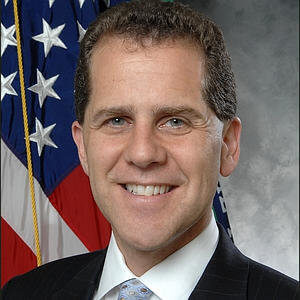 Barr, Biden’s Pick for Fed Regulation Role, Cruises Through Confirmation Hearing
Barr, Biden’s Pick for Fed Regulation Role, Cruises Through Confirmation Hearing- Courtesy of Pete Schroeder, Reuters
- May 19, 2022 — Michael Barr, the second person nominated by Democratic President Joe Biden to be the Federal Reserve’s Wall Street cop, looked to be on a path to confirmation after testifying before the Senate on Thursday.
- Barr, who served as a senior Treasury Department official under Democratic President Barack Obama, received some skeptical questions from Republican lawmakers. But there was little indication of any concerted effort to sink his candidacy, and moderate Democrats appeared supportive of him. Testifying before the Senate Banking Committee, Barr struck a measured tone on a wide range of issues, including financial risk from climate change and the proper regulation of cryptocurrencies, while vowing to take a holistic view on the overall state of bank regulation in the United States.
- Related Reading: Statement of Michael S. Barr, Nominee to be a Member and Vice Chair for Supervision of the Board of Governors of the Federal Reserve System, Before the Committee on Banking, Housing, and Urban Affairs of the United States Senate May 19, 2022
- When pressed on the climate issue on Thursday, Barr insisted the Fed had “important but quite limited” powers, which are focused on assessing the risks banks might face from climate change, as it would any other looming concern.
- “I think the Federal Reserve … should not be in the business of telling financial institutions to lend to a particular sector or not to lend to a particular sector,” he said.
- Barr, currently a law professor at the University of Michigan, has already drawn support from moderate Democrats, as well as progressives anxious to ramp up scrutiny of Wall Street after what they say was regulatory easing under Republicans. At the Treasury, Barr was a central figure in the drafting of the 2010 Dodd-Frank financial reform law, which established a range of safeguards following the 2008 financial crisis.
- On cryptocurrency, Barr said the technology has “some potential for upside” but that stablecoins in particular could pose “financial stability risks” if customers believe they are more reliable than they are in reality. Barr previously advised and served on the boards of several crypto and fintech firms, but said at Thursday’s hearing that, if confirmed, he would not work in the financial sector for four years after leaving government.
- Click to read the entire article.
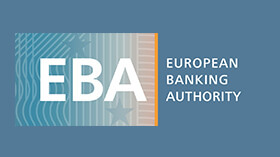 EBA Publishes Regulatory Standards to Identify Shadow Banking Entities
EBA Publishes Regulatory Standards to Identify Shadow Banking Entities- Courtesy of Moody’s Analytics
- May 23, 2022 — The European Banking Authority (EBA) published the final draft regulatory technical standards specifying the criteria to identify shadow banking entities for the purposes of reporting large exposures. Following the European Commission endorsement, these standards will be subject to scrutiny by the European Parliament and the Council, before being published in the Official Journal of the European Union.
- The final draft regulatory technical standards clarify that entities carrying out banking activities or services that have been authorized and supervised in accordance with the regulatory framework consisting of any of the legal acts referred to in Annex I of these draft regulatory standards (or are part of a group supervised on this basis) shall not be considered as shadow banking entities. Similarly, the entities that have been exempt or excluded from the application of some of those Legal Acts, notably the Capital Requirements Regulation (CRR), the Capital Requirements Directive (CRD), the European Market Infrastructure Regulation (EMIR), and Solvency II, shall not be considered as shadow banking entities. However, all other entities that provide banking activities and services shall be considered shadow banking entities. The draft regulatory technical standards address three main legal provisions addressing the:
- criteria for identifying both shadow banking and non-shadow banking entities
- definition of banking activities and services
- criteria for excluding entities established in third countries from being deemed as shadow banking entities
- Specific rules apply to certain collective investment undertakings. Undertakings included in the consolidated supervision of an institution are out of the scope of these final draft regulatory standards. Moreover, for the entities established in a third country, the final draft regulatory technical standards differentiate between “institutions” and “other entities.” Institutions are not identified as shadow banking entities, provided they are authorized and supervised by a supervisory authority that applies banking regulation and supervision based on at least the Basel Core Principles for Effective Banking Supervision. Other entities are not identified as shadow banking entities, provided they are subject to a regulatory regime recognized as equivalent to the one applied in the European Union for such entities, in accordance with the equivalence provisions of the relevant European Union legal act.
- The main basis for development of these draft regulatory standards has been the guidelines on limits on exposures to shadow banking entities, which carry out banking activities outside a regulated framework. Article 394(2) of the Capital Requirements Regulation (CRR2 or Regulation 2019/876) sets out the additional reporting obligations for an institution that is required to report its 10 largest exposures to shadow banking entities that carry out banking activities outside the regulated framework on a consolidated basis. Article 394(4) of the Capital Requirements Regulation (CRR or Regulation 575/2013) requires EBA to develop draft regulatory technical standards to specify the criteria for the identification of shadow banking entities. These guidelines were published in December 2015 to give effect to the mandate of Article 395(2) of CRR.
 Related Reading
Related Reading- Press Release
- Standards on Shadow Banking Entities (PDF)
- Articles for May 19, 2022 Issue:
 2022 DSIR Deeper Dive: Increased Regulatory Scrutiny of Cybersecurity Incidents
2022 DSIR Deeper Dive: Increased Regulatory Scrutiny of Cybersecurity Incidents- Courtesy of Teresa Goody Guillén and Andreas Kaltsounis, BakerHostetler
- May 17, 2022 — Our 2022 Data Security Incident Response Report discussed the increased regulatory scrutiny of cybersecurity incidents and defenses following a year of high-profile and damaging cyberattacks, including the Russia-based SolarWinds espionage campaign and the Colonial Pipeline ransomware attack. This article summarizes several U.S. government actions aiming to improve the nation’s cybersecurity and the government’s ability to track and respond to cyber incidents. Organizations subject to these actions will need to evaluate how such actions may apply to them and take necessary measures to comply. Organizations should also note that these actions are just examples of a larger whole-of-government effort to bolster the nation’s cybersecurity and address cyberattacks—organizations should expect and watch for additional cyber regulations that may impact their operations.
- The Biden Administration
- At the forefront of this increased focus on cybersecurity is the Biden Administration’s goal to get the federal government’s cyber protections in order as it encourages private entities to do the same. In May 2021, President Biden issued the Executive Order on Improving the Nation’s Cybersecurity, calling on government agencies to strengthen and protect their data and information-security infrastructure. The SolarWinds hack demonstrated the extent to which government agencies are vulnerable to cyberattacks, especially as a result of open-source software and third-party dependencies that support so much of the federal government’s activities. The Executive Order aims to update and improve government systems and, by mandating software bills of material, improve visibility into hidden vulnerabilities that may exist in the government’s software and systems.
- Office of the Comptroller of the Currency
- On April 1, 2022, the Office of the Comptroller of the Currency, the Federal Deposit Insurance Corporation and the Federal Reserve Board implemented a rule requiring banking organizations to notify their primary federal regulator after an incident affecting or disrupting bank operations is discovered “as soon as possible and no later than 36 hours.” The rule also requires bank service providers to notify their banking organization customers when they experience an incident.
- FinCEN
- In November 2021, the Financial Crimes Enforcement Network (FinCEN) issued an advisory indicating that money services businesses and other entities subject to the Bank Secrecy Act should file a suspicious activity report if they think a ransomware payment is processed through them. FinCEN is using the data to track ransomware groups and quantify the ransoms they are able to extract. For example, FinCEN noted that Darkside and Sodinokibi/REvil, the groups behind the Colonial Pipeline and the JBS and Kaseya attacks, respectively, accounted for 458 reported ransomware-related transactions in the first half of 2021, with a total value of $590 million.
 Read the entire article here.
Read the entire article here. Former Regulators Join $45 Million Round in Crypto Risk Platform Solidus Labs
Former Regulators Join $45 Million Round in Crypto Risk Platform Solidus Labs- Courtesy of FinExtra.com
- May 17, 2022 — Solidus Labs, a digital asset risk surveillance firm founded by ex-Goldman Sachs engineers, has secured a $45 million B round led by Liberty City Ventures and joined by Evolution Equity Partners, Declaration Partners, and angels including former US Acting Comptroller of the Currency Brian Brooks and former CFTC Chairman Christopher Giancarlo.
- The New York-based firm seeks to transform financial risk monitoring, beginning with the new challenges posed by crypto and digital asset markets. Solidus’ clientele includes top crypto firms as well as traditional financial institutions and regulatory agencies.
- The announcement comes on the backdrop of record breaking crypto and DeFi adoption – with some estimates placing total value locked (TVL) in DeFi at more than $200 billion in the beginning of 2022 – which has seen Solidus Labs quadruple its team over 2021 amid massive demand.
- In March, the firm unveiled its all-in-one crypto-native risk monitoring suite, Halo, which is currently monitoring more than one trillion trading events per day in more than 150 markets. The platform deploys over 50 different proprietary market abuse typologies, shielding investors and safeguarding crypto businesses from new threats unique to the crypto and decentralized finance space.
- “For Web3 and the DeFi economy to truly fulfill their massive potential, there’s a need to mitigate new risks – both in terms of liquidity enablement and on the consumer and investor protection side. This is where Solidus’ crypto-native solutions come into play, and the reason we’ve been experiencing a 560% year-over-year revenue increase,” says Asaf Meir, Solidus’ founder and chief executive. “The additional funds will allow us to support the growing cohort of financial institutions looking to expand into the DeFi space, accelerate the deployment of our threat intelligence capabilities, and expand our R&D to solve a fast-growing array of DeFi specific use-cases and needs.”
- FTC Joins Amicus Brief Opposing Liability Shield for Sloppy Credit Reports
FTC Joins CFPB in Asking Second Circuit to Reverse Decision Inventing Defenses Against Liability for Data Brokers and other Consumer Reporting Agencies  The Federal Trade Commission has joined the Consumer Financial Protection Bureau in an amicus brief filed with the United States Court of Appeals for the Second Circuit in the case of Sessa v. TransUnion. The brief asks the court to overturn a lower court decision, which held that TransUnion was not liable for failing to investigate a wrongfully reported debt because the inaccuracy was “legal” and not “factual.”
The Federal Trade Commission has joined the Consumer Financial Protection Bureau in an amicus brief filed with the United States Court of Appeals for the Second Circuit in the case of Sessa v. TransUnion. The brief asks the court to overturn a lower court decision, which held that TransUnion was not liable for failing to investigate a wrongfully reported debt because the inaccuracy was “legal” and not “factual.”- “The lower court’s decision not only disregards the plain language enacted by Congress, but also is a gift to data brokers that already exercise a largely unfettered, invisible power over consumers’ lives,” said Samuel Levine, Director of the FTC’s Bureau of Consumer Protection. “Consumers can’t vote with their feet when consumer reporting agencies get it wrong. Enforcers and consumers need to be able to hold these companies accountable.”
- The lower court held that legal inaccuracies are exempt from the requirement under the Fair Credit Reporting Act that consumer reporting agencies “follow reasonable procedures to assure maximum possible accuracy” of consumer reports. Since this law was enacted, it has allowed enforcers and consumers to hold consumer reporting agencies accountable for the incorrect information they place on consumers’ credit reports. This authority is especially critical in the credit reporting market, where consumers have no options for avoiding credit reporting agencies in order to participate in the economy and there are few incentives to fix sloppy mistakes. This holding, if adopted elsewhere, would make it easier for consumer reporting agencies to escape accountability for sloppy reports that harm consumers.
- The joint brief argues that the lower court’s legal inaccuracy exemption is neither based on any textual language in the law, nor is it workable. The invented defense invites consumer reporting agencies and furnishers to skirt their legal obligations by arguing that inaccurate information is only legally, and not factually, inaccurate. For any number of obviously inaccurate factual mistakes that might appear on a consumer’s credit report, consumer reporting agencies might be able to manufacture some supposed legal interpretation to insulate itself from liability. The lower court’s unsupported reading could increase the number of inaccurate credit reports and result in inaccurate information about consumers being conveyed to lenders, landlords, employers, and other entities that purchase consumer reports.
- The Commission voted 3-0 to file the amicus brief. Commissioner Noah Joshua Phillips did not participate.
-
- 4 SaaSholic, Why Data Protection Is So Important for SaaS (Accessed October 24, 2022)
 October 25, 2022 —
October 25, 2022 —